Busy? That’s an understatement for the Omaha commercial real estate market
By Dan Rafter, Editor
Pandemics, soaring inflation and rising interest rates. Omaha’s commercial real estate market has remained resilient during all of them.
Why? What makes Omaha’s commercial real estate market such a strong one? Why has demand for multifamily, industrial and retail properties in this city remained so high for investors? Why has leasing and sales activity remained so strong throughout most of Omaha’s commercial sectors?
The commercial pros working this market point to a pro-business government that encourages devel opment and entices companies to open national or regional headquarters here. They also cite the strong
workforce in Omaha and the commitment city leaders have to constantly improving the neighborhoods that make up Omaha.
That last point is especially important today. Several high-profile commercial developments are springing up across Omaha and its suburbs. These new office towers, mixed-use developments and multifamily prop erties are pumping new dollars into the city. And they are attracting new residents and companies.

So even though the national economy is far from stable today, Omaha’s commercial real estate market is show ing few signs of slowing.
OMAHA
FINANCE
Financing pros: Interest-rate hike means a slowdown in commercial deals is inevitable
By Dan Rafter, Editor
In its efforts to curb rising inflation, the Fed eral Reserve on Sept. 21 raised its benchmark interest rate by three-quarters of a percentage point. The Fed said that it plans to boost this rate in the future to fight inflation.
The Fed also said it will continue to enact hikes until its benchmark rate hits 4.6% in 2023.
This move, of course, sent another ripple of concern through the commercial real estate industry, with CRE professionals wondering how many commercial deals the higher inter est rates might scuttle.
MINNESOTA | MISSOURI | NEBRASKA | OHIO | TENNESSEE | WISCONSIN | THE DAKOTAS | ILLINOIS | INDIANA | IOWA | KANSAS | KENTUCKY | MICHIGAN WWW.REJOURNALS.COM VOLUME 34 ISSUE 5 SEPTEMBER/OCTOBER 2022
FINANCE (continued on page 27)
(continued on page 21)
CRE MARKETPLACE PAGE 53: ARCHITECTS/DESIGN-BUILD FIRMS BROKERAGE FIRMS DEVELOPERS LAW FIRMS ECONOMIC DEVELOPMENT CORPORATIONS
The Heartwood Preserve is another major mixed-use development that is providing a boost to Omaha’s commercial real estate market.
Financing Special O er

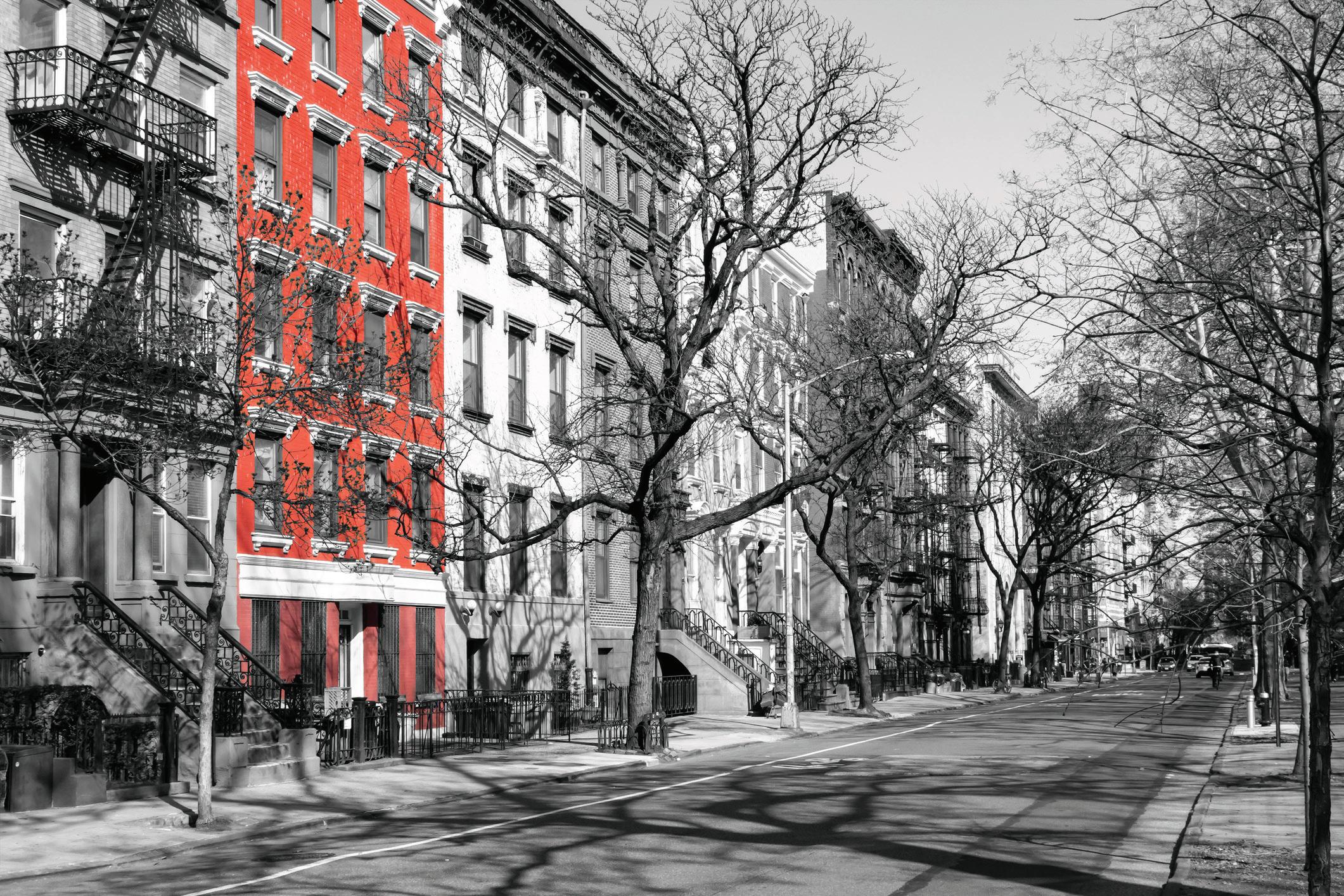
Multifamily
Commercial Real Estate Lending Capital Markets Now’s the time to refinance your Multifamily Real Estate Loan. Get a 3.95% interest rate for 1 year on a 5/1 ARM commercial multifamily loan. Rate will adjust to a xed 4.95% for years 2-5. Apply by 10/21/22 and receive a refund of the underwriting and documentation fee. BankFinancial’s Multifamily 3.95% Loan Special • 5/1 ARM at 3.95% Intro Rate with Zero Points • Loan Amount: $750,000 to $3,000,000 • Purpose: Loan Balance Refinance • Properties: 5+ Units • LTV: Up to 65% / 30-Year Amortization Also Available: • Cash-Out Investment Equity Loan • LTV Up to 80% (Dual Note) • Interest-Only Lines of Credit • Loan Amounts Up to $10,000,000 *Initial loan rate is fixed at 3.95% for the first year: rate will then adjust to a fixed 4.95% for years 2 through 5. Loan application, including the underwriting and documentation fee, must be received by 10/21/22 to be eligible for a credit of up to $3,950 at closing. Loan transaction must close on or before 12/16/22 to get the 3.95% intro rate promotion. All loans subject to credit and collateral approval. Exclusive Rate 3.95%* Contact us to learn more today! 1.833.894.6999 | BankFinancial.com

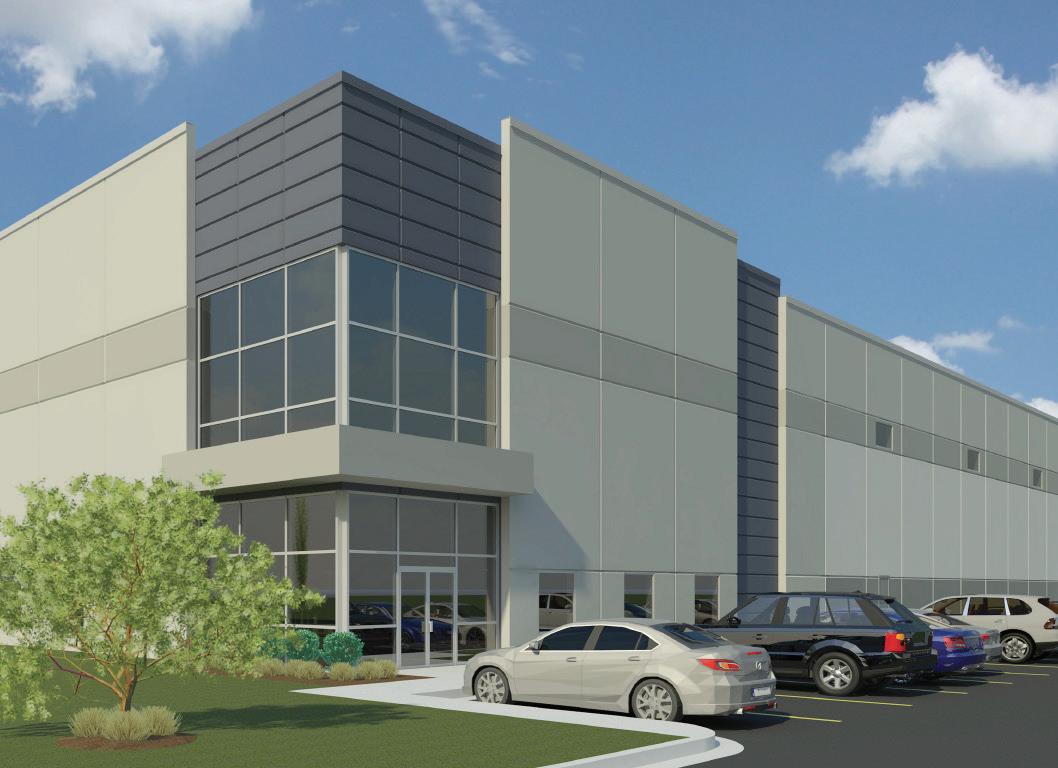
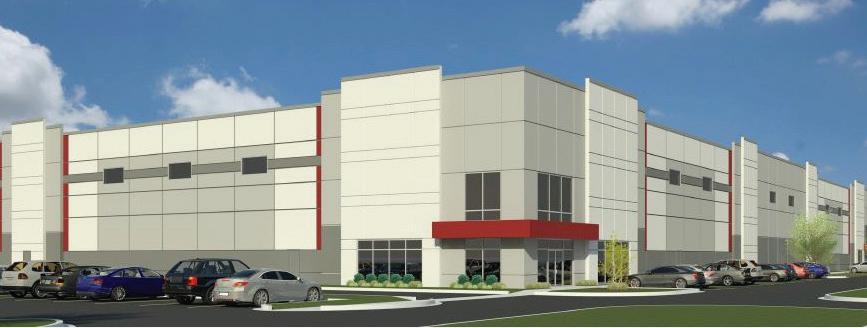
1032 W. 43RD ST. | CHICAGO, IL 50 S. FAIRBANK ST. | ADDISON, IL 4400 HOMERLEE AVE. | EAST CHICAGO, IN BREAKING NEW GROUND... The Missner Group and Realterm announce a partnership that will deliver 460,000 square feet of Class-A industrial real estate to the Chicagoland market. Together we aim to deliver facilities of superior quality, all while enhancing the surrounding communities. 130,000 SF 250,000 SF78,000 SF A DEVELOPMENT OF missnergroup.com | realterm.com
Busy? That’s an understatement for the Omaha commercial real estate market: Pandemics, soaring inflation and rising interest rates. Omaha’s commercial real estate market has remained resilient during all of them.


Financing pros: Interest-rate hike means a slowdown in commercial deals is inevitable: In its efforts to curb rising inflation, the Federal Reserve on Sept. 21 raised its benchmark interest rate by three-quarters of a percentage point. The Fed also said that it plans to boost this rate in the future to fight inflation. This set off a new round of worries in the commercial real estate market.
Colliers pros: Momentum still strong in Cleveland’s commercial real estate market: Like in many major cities, Cleveland’s commercial real estate market is thriving. Demand is soaring for industrial space and multifamily units. Retailers are opening new locations. Healthcare providers continue to open new clinics and emergency care centers across the Cleveland area. And even the office market is showing some positive signs.
Poised for a bright future: Columbus’ CRE market remains a resilient one: A booming industrial market. A multifamily sector that remains hot. And retail and office sectors that, despite challenges, are showing positive signs. That’s what the brokers working in Columbus and its suburbs say they see today in this Ohio city’s commercial real estate market.
Challenging times? They’re nothing new for a resilient Detroit: How busy has the multifamily sector been? Just ask Greg Coulter, managing member and founder of Income Property Organization in Bloomfield Hills, Michigan. He says that he’s never seen more activity in this sector.
No huge drop-off coming: Multifamily market expected to remain hot into 2023: Renters and investors are still seeking out multifamily space. And the demand for apartment living is showing no signs of slowing, according to Kia Crooms, area vice president of the Midwestern region for King of Prussia, Pennsylvania-based Morgan Properties.

If you’re looking for outstanding space, check out HoosierSites.com. Hoosier Energy will become your secret source for finding the perfect existing facility or shovel-ready site. Great locations with access to highways, runways, rail and ports. But the best part is our flexibility in creating competitive rates for new and expanding businesses. For many decision-makers, when space starts feeling like the final frontier, Hoosier Energy becomes their first thought.







Supply chain issues. A labor shortage. An increasingly competitive market: Can modular construction provide the relief developers seek? Developers face plenty of challenges today: It’s difficult to find experienced labor. Material costs keep rising. And supply chain disruptions mean that it can be difficult to get everything from insulation to concrete and steel to construction sites on time.

4 | Midwest Real Estate News | September/October 2022 | www.rejournals.com
DEPARTMENTS 6 Editor’s Letter 41 Development Showcase: Minneapolis’ Alvera 53 Directory Listings PRIME INDUSTRIAL LOCATIONS WITH POWER, ACCESS AND INCENTIVES. SPACED OUT?
HOOSIER ENERGY RURAL ELECTRIC COOPERATIVE IS AN EQUAL OPPORTUNITY EMPLOYER FEATURES 1 1 18 8 14 33 36 The Midwest’s commercial real estate publication, providing useful, unbiased and accurate coverage of the industry and its professionals since 1985. WWW.REJOURNALS.COM Publisher | Mark Menzies menzies@rejournals.com Editor | Dan Rafter drafter@rejournals.com ADVERTISING Vice President of Sales & MW Conference Series Manager | Ernest Abood eabood@rejournals.com Vice President of Sales | Frank E. Biondo frank.biondo@rejournals.com Vice President of Sales | Marianne Grierson mgrierson@rejournals.com Classified Director | Susan Mickey smickey@rejournals.com EVENTS/CONFERENCES Support Specialist, Media & Events | Hayley Myers hayley.myers@rejournals.com Midwest Real Estate News brings real estate leaders together to explore the challenges and opportunities unique to their markets. ADDRESS 1010 Lake St Suite 210, Oak Park, IL 60301 Midwest Real Estate News® (ISSN 0893-2719) is published bimonthly by Real Estate Publishing Corp., Oak Park, Il 60301 (rejournals.com). Current and back issues and additional resourc es, including subscription request forms and an editorial calendar, are available on the internet at rejournals.com. Subscriptions: Within U.S.: 1 year, $69; 2 years, $89; 3 years, $109. Single copies, $10.00. Subscription information: Haley Myers 1010 Lake St Suite 210, Oak Park, IL 60301 708-622-0074. ©2022 Real Estate Publishing Corp. 8


Chicagoland’s Union Electrical Team LEARN MORE AT POWERINGCHICAGO.COM
The office market’s challenges are unrelenting
By Dan Rafter, Editor
The office market had already been struggling. But an un certain economy has only brought more challenges for this sector. A new report found that demand for office space continued to fall throughout last sum mer, thanks in part to rising interest rates and persistent inflation.
That’s the bad news from the latest VTS Office Demand Index, or VODI.
According to VTS, Chicago, Boston and New York City saw the largest declines in demand for office space in July. That’s partly because these cities have a large number of finance, insurance and real estate companies, sectors that are particularly sensitive to rising interest rates.
VTS’ VODI score, a measure of office demand, tracks tenant tour require ments, both in-person and virtual, of office properties in key U.S. markets. You can consider it an early indicator of upcoming office leasing activity. It’s also the only commercial real estate index that tracks new tenant demand. It’s not a crystal ball, of course, but it is a good indicator of what’s coming next when it comes to demand for office space.
And the report covering the recently concluded summer season is yet one more indication that the office mar ket’s challenges might be lasting well into the new year.
According to VTS, across the United States, new demand for office space fell 11 VODI points to 52 in July. That represents a 17.5% month-overmonth drop, pushing the index to its lowest level since February of 2021.

“We’re used to seeing demand for office space cool in summer months, but not at this rate,” said Nick Romi to, chief executive officer of VTS, in a written statement. “Unique to 2022 is an economic outlook that is continu ally shifting and is likely contributing to a reduction in new office demand, as uncertainty causes some potential tenants to delay or reconsider their current office space needs.”
Demand for office space in Chicago
dropped 29.9%, falling to below half its pre-pandemic pace, VTS said. Chi cago had a VODI score of 47 this July, while its average pre-pandemic VODI score was 100.
Of course, you probably don’t need a VODI score to tell you that the office
sector continues to face hurdles. Many companies are still trying to finalize their back-to-the-office plans, and most are turning to a hybrid ap proach, letting employees work part of the time from home and part of the time in the office.
This means that many companies no longer need as much office space. As these companies move to smaller space – often of a higher class – it will keep the vacancy rate in the office sector high.
Add to that the challenges of rising in terest rates and inflation and it’s clear that the future remains murky for the office sector.
The good news? The number of peo ple working in offices has been rising. It’s not at pre-pandemic levels yet, that’s true. But there is some posi tive momentum. And the owners of Class-A office space are finding that their properties are often in demand from companies wanting to upgrade to better office space to help entice their workers back.
The only certainty now, though, is that the office sector will continue to rebound at a slower pace in what is hopefully becoming a post-pandemic environment.
Midwest Real Estate News | September/October 2022 | www.rejournals.com6 FROM THE EDITOR
“The good news? The number of people working in offices has been rising. It’s not at pre-pandemic levels yet, that’s true. But there is some positive momentum.”
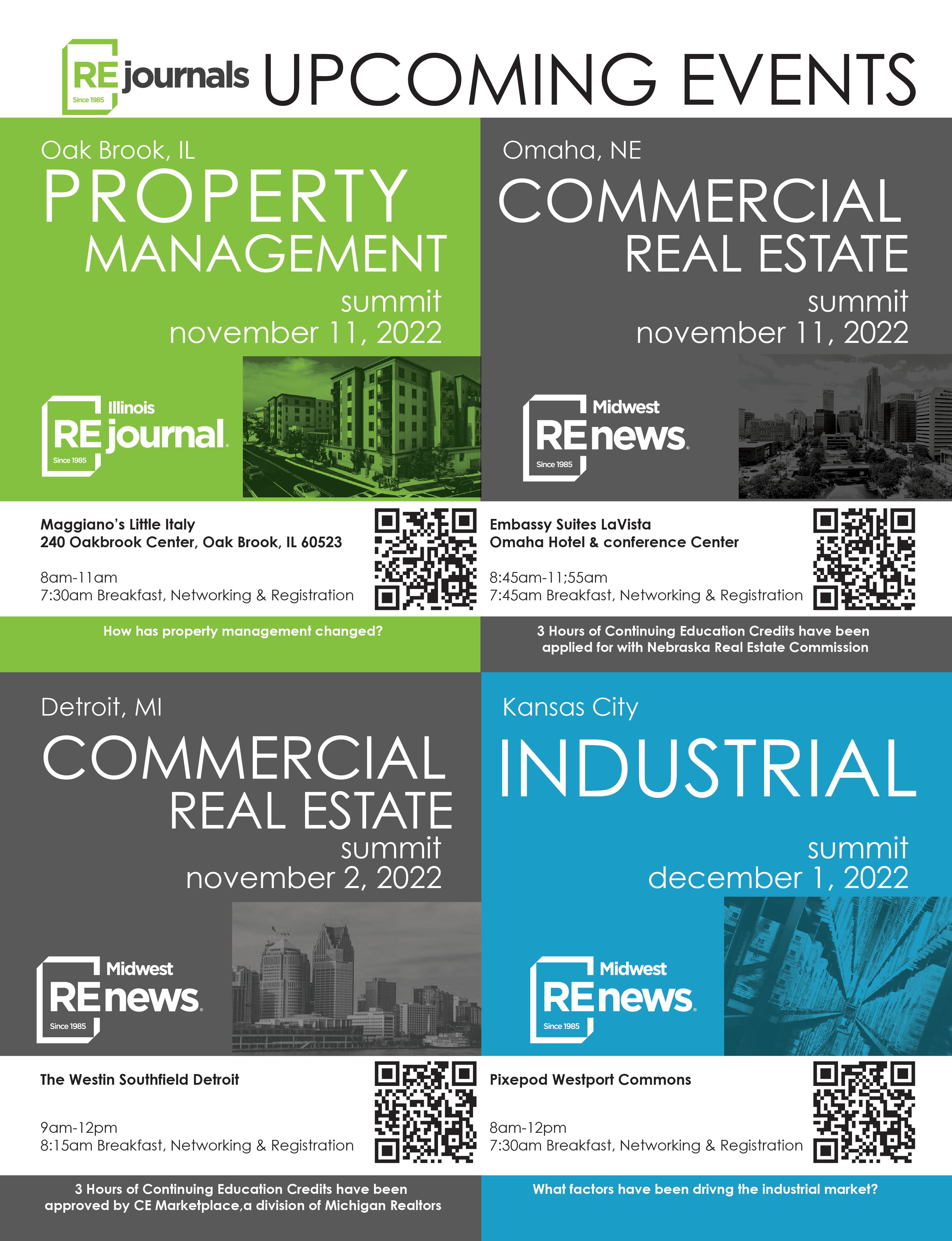
Colliers pros: Momentum still strong in Cleveland’s commercial real estate market
By Dan Rafter, Editor
Like in most major cities across the Midwest, Cleve land’s commercial real estate market is thriving. Demand is soaring for industrial space and multifamily units. Retailers are opening new locations here. Health care providers continue to open new locations across the Cleveland area. And even the office market is showing some positive signs.
Not to say there aren’t any challeng es. No one knows exactly how rising interest rates might slow deal velocity in Cleveland and its suburban areas. Developers and contractors continue to struggle with supply shortages and the rising costs of materials. And many major employers in the area still haven’t finalized their back-to-
work plans, keeping the office sector in its COVID limbo.
But three CRE pros from the Cleveland office of Colliers said that leasing activity is strong in most commercial sectors today in their market. And in even better news, these pros are pre dicting that the rest of 2022 and the beginning of next year will be strong in Cleveland, too.
What’s behind the commercial real estate momentum in this key Midwest city? You can credit Cleveland’s ideal location in the center of the country, its strong workforce, pro-business environment and investors’ insatiable demand for commercial real estate assets.

Industrial keeps booming
Tim Breckner, senior vice president with Colliers in Cleveland, specializes in the industrial sector. That’s a big plus: Industrial real estate remains the darling of investors today. And de mand for industrial space is slowing no signs of falling, either across the country or in the Cleveland market.
As of the second quarter of this year, the industrial vacancy rate in the Cleveland market had fallen to 4.2%, according to Colliers’ research. Breck ner said that this is the lowest this vacancy rate has been since Colliers first started tracking it.
The second quarter again saw posi tive net absorption in the Cleveland
industrial market. Breckner said that Cleveland hasn’t seen negative ab sorption in the industrial sector since the second quarter of 2019.
“It seems like COVID was a big factor for increasing industrial de mand even further,” Breckner said.
“Things were already trending in this direction. People were already ordering everything online. But after COVID, people started ordering even more frequently online. They grew comfortable ordering clothes, foods, consumables, whatever they needed. That is a big part of why demand has only grown for industrial space since the pandemic started.”
Another positive for Cleveland’s industrial market? The city and its
Midwest Real Estate News | September/October 2022 | www.rejournals.com8
CLEVELAND
Euclid Grand is an example of the modern apartment units residents are seeking in downtown Cleveland.
surrounding areas did not have much spec industrial construction until recent years. This mean there hasn’t been an overabundance of supply in the area. Once developers started building new modern industrial space, then, the de mand for it remained high.
And this new spec space has filled quickly, often while the facilities are still under construction.
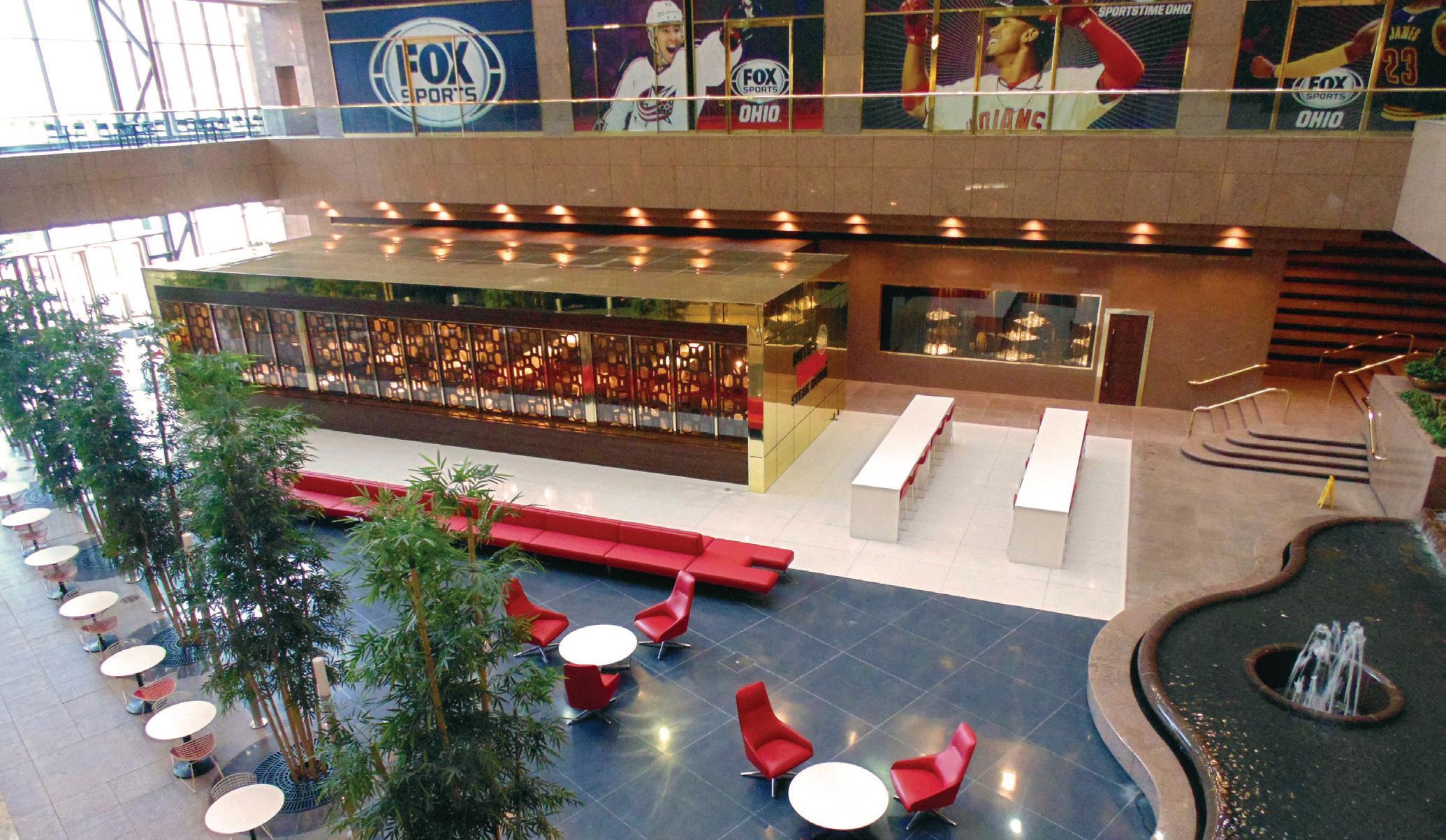
Breckner said that end users are looking for specific amenities when it comes to new industrial space today. This includes higher clear heights, with some of the new product entering the market boasting clear heights of 40 feet. At the minimum, new facilities must have clear heights of at least 30 feet, Breckner said.

Users also expect wider column spac ing inside facilities, more docks and more room to park trailers, Breckner said.
“We have what I consider to be a lot of spec space under construction today,” Breckner said. “But for the most part, this space is filling quickly. We are not seeing any high vacancy rates. Demand
is so high that landlords are becom ing more strategic when it comes to who they lease to. They are seeking full-building users. If they can’t get that, they only want to split their buildings up among two users instead of chopping it up for several users. Landlords can be more selective in this market, too.”






While the Cleveland-area industrial market continues to thrive, it does face challenges, Breckner said. Not surprisingly, these challenges come down to rising interest rates and sup ply chain disruptions.

Breckner said that developers are still struggling to get the materials they need to build industrial space. He said that today dock equipment and the panels for overhead doors have

www.rejournals.com | September/October 2022 | Midwest Real Estate News 9
BOLD RESULTS PITTSBURGH • CLEVELAND • CHICAGO • COLUMBUS PROPERTY TAX SAVINGS WE KNOW HOW TO GET RESULTS BECAUSE WE KNOW PROPERTY TAX LAW. We are the property tax law firm. It’s all we do, with more than 40 years of experience and billions in assessment reductions nationwide. Contact Kieran Jennings and the team at Siegel Jennings for a no-fee, no-risk review of your portfolio 216-763-1004 • siegeltax.com SIEGEL JENNINGS PROPERTY TAX LAW CLEVELAND The 200 Public Square office building in downtown Cleveland is in the middle of a major renovation that will include updates to its lobby area. (continued on page 10)
become especially difficult to get. These materials have also become more expensive.
The rising cost of materials means that industrial space itself might continue to get more expensive for end users. As Breckner says, asking rates for industrial spaces in the Cleveland area were up again this quarter. They’re also up on a yearover-year basis, he said.
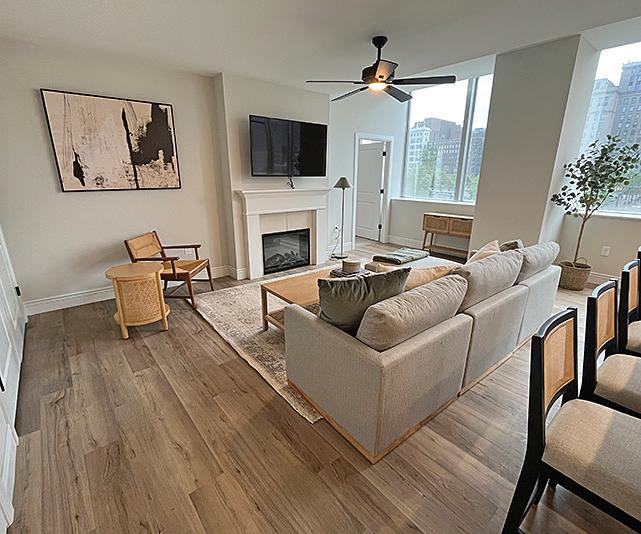
Despite these potential headwinds, Breckner said he doesn’t expect demand for industrial space in the Cleveland market to slow any time soon.
“It comes down to the way people shop now,” he said. “They go online to buy anything they need. People also don’t consider all the returns they make. Those returns also go back through a chain of warehous es. It’s almost a two-fold increase, then, because of the way people’s shopping habits have changed. You buy something. You send it back. In each direction, it goes through a warehouse or series of warehous es.”
An uncertain office sector
As it is in most cities, the office sec tor in Cleveland remains in a state of uncertainty. Many of the area’s bigger employers are still finalizing back-towork plans. And many of the area’s office workers continue to work from home, at least two to three days a week.
This has left Cleveland – and especial ly the city’s downtown office market – with a higher vacancy rate. Again, this is hardly unusual; Most major cities across the United States face the same challenges with their office space.




Brian Hurtuk, managing director with the Cleveland office of Colliers, said that most companies with office
space in downtown Cleveland are operating on a new normal: They are encouraging their office workers to come into the office at least three days a week.
This means that on any given week day, about 60% of the normal work force is traveling into downtown Cleveland, Hurtuk said.
Midwest Real Estate News | September/October 2022 | www.rejournals.com10 CLEVELAND
CLEVELAND (continued from page 9) K&D offers luxury downtown living, sophisticated suburban living, senior/affordable housing, commercial/retail leasing - as well as employment opportinities at all of our communities! Visit our website for info about all of our locations throughout Northeast Ohio at... www.KandD.com NOW RENTING! FIRST MOVE-INS BEGIN OCTOBER 1, 2022! LIVING OPTIONS TO SUIT EVERY LIFESTYLE Reflective Sophistication. Uncompromising Convenience. 55 Public Square | Cleveland, OH 44113 | 216.621.5005 | www.ResidencesAt55.com 202 BRAND NEW, LUXURY 1 & 2 BEDROOM SUITES AND 2 & 3 BEDROOM PENTHOUSES! Fahrenheit Restaurant Attached to the Building with Rooftop Dining! Located Minutes from the Warehouse District, E. 4th Street, Professional Sporting Venues, JACK Cleveland Casina, Playhouse Square, Public Square, Dining, Entertainment... everything that Downtown has to offer! 24/7 Fitness Center, Community Lounge, Convenience Market with Cafe, Smart Apartment App Feature, Package Room, Bike Storage, Pet Washing Facility, Attached Garage Parking, Pet Friendly! Left: The 200 Public Square office building in downtown Cleveland is in the middle of a major renovation that will include updates to its lobby area. Right: The view from 200 Public Square in downtown Cleveland.
“We have a long way to go, then, before we get to a more normal office environment,” he said.
In the suburbs, the equation is a bit different. Hurtuk said that on any given weekday in Cleveland’s subur ban communities, about 75% of the normal workforce heads into offices.
Why the difference here? The subur ban office market is dominated by smaller, more flexible companies that began asking their workers to return to the office sooner than have the larger, national companies that dot the downtown office market.
The suburban office market is also filled with buildings that are typically smaller. If workers are worried, say, about crowding into an elevator, they can take the stairs. Suburban office buildings don’t tend to be as vertical as those in downtown Cleveland.
“The interesting thing is the busi nesses downtown -- professional firms, law firms, accounting firms, banks and insurance companies -- are doing well financially,” Hurtuk said. “Companies are paying rent
on time. Very few companies of any significance have said that they are going to give space back to the mar ket. No one of significance has put a big block of space back on the market for sublease.”
Before the pandemic hit, the Cleve land office market was seeing high vacancy rates in all classes of build
Unmatched Expertise
The
ings. Some of the market’s higher-end office buildings were even generating more than $30 a square foot in asking rates.
Today? Asking rents have taken a hit of about 10% overall. And tenants in the market are asking for economic relief from landlords and building owners, Hurtuk said.
Hurtuk said that tenants are also asking for a greater amount of tenant improvement dollars when moving to a new office space or renewing their leases in an existing building. Overall, building owners are giving tenants almost 20% more for tenant improvements than they were before the pandemic.
“There are some positives in the mar ket,” Hurtuk said. “The higher-end buildings are seeing more activity. And there are other buildings in the market that are building momentum, too. We are not jumping up and down with joy about the office market, but we are also not standing on window ledges. We are cautiously encour aged. The more we have office work ers back downtown every day, the better it is for everybody.”
Many companies that are looking for new office space are targeting build ings with robust amenity packages, Hurtuk said. That’s one way for them to attract workers back to the office, at least on a part-time basis.
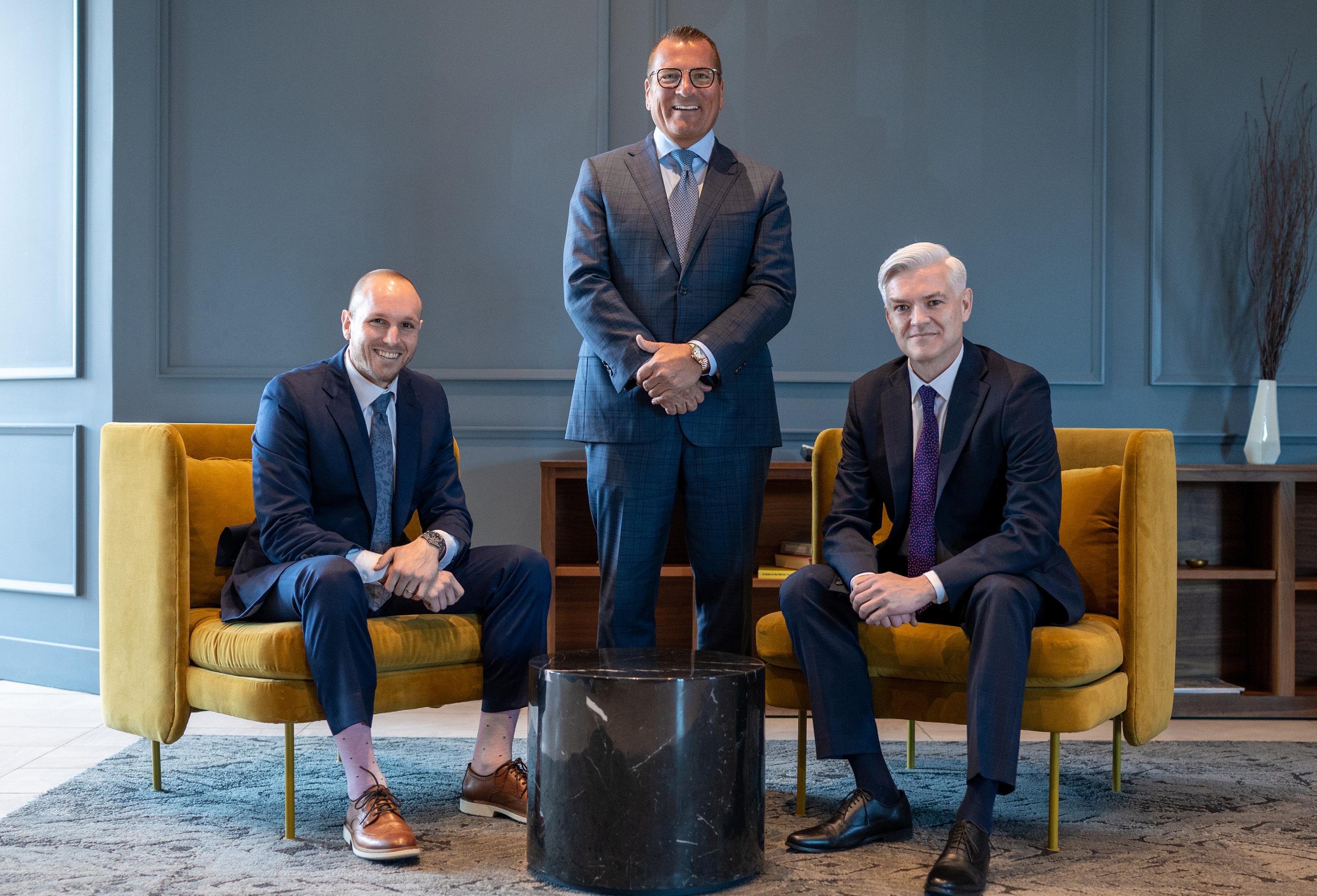
Contact the Cooper Multifamily

www.rejournals.com | September/October 2022 | Midwest Real Estate News 11
CLEVELAND
Team: Colliers | Cleveland 200 Public Square, Suite 1200 Cleveland, OH 44114 +1 216 239 5060 colliers.com/Cleveland
experts of the Colliers Cooper Multifamily Team in Cleveland have been sharing their comprehensive real estate knowledge with clients for more than 40 years. Masters of their craft helping sellers maximize sales proceeds and investment returns.
“The higher-end buildings are seeing more activity. And there are other buildings in the market that are building momentum.”
(continued on page 12)
Amenities that matter today include
restaurants that serve healthy food, fitness centers
offer the latest exercise equipment, ample and easy-to-access parking and con ference rooms fitted with the latest technology.
Hurtuk points to 200 Public Square in Cleveland as an example. That iconic Cleveland office building is in the mid dle of a $6 million capital campaign spent on conference rooms, a cafete ria, fitness center and refreshed lobby area.
Getting people back into the office has become a priority for many em ployers in Cleveland, Hurtuk said. They realize that younger workers need to be around those with more experience. Mentoring doesn’t work remotely. They also realize that brainstorming new ideas and crafting creative business strategies is more likely when workers are in the office.
“I’m hoping that more organizations will encourage and entice their
workers back to the office on a daily basis,” Hurtuk said.
More people are returning to down town Cleveland, Hurtuk said. But this activity tends to be clustered on Tues days, Wednesdays and Thursdays, he said. Mondays and Fridays remain far quieter than they were before the pandemic.
“It has been a big change,” Hurtuk said. “Just two short years ago, every one was coming into the office every day. Now everyone is trying to figure out what they need for office space.
What is the secret sauce? Right now, we have not seen any announce ments or grumblings of significant downsizings or give-backs of space. So that’s a positive.”
Demand still rising for multifamily space
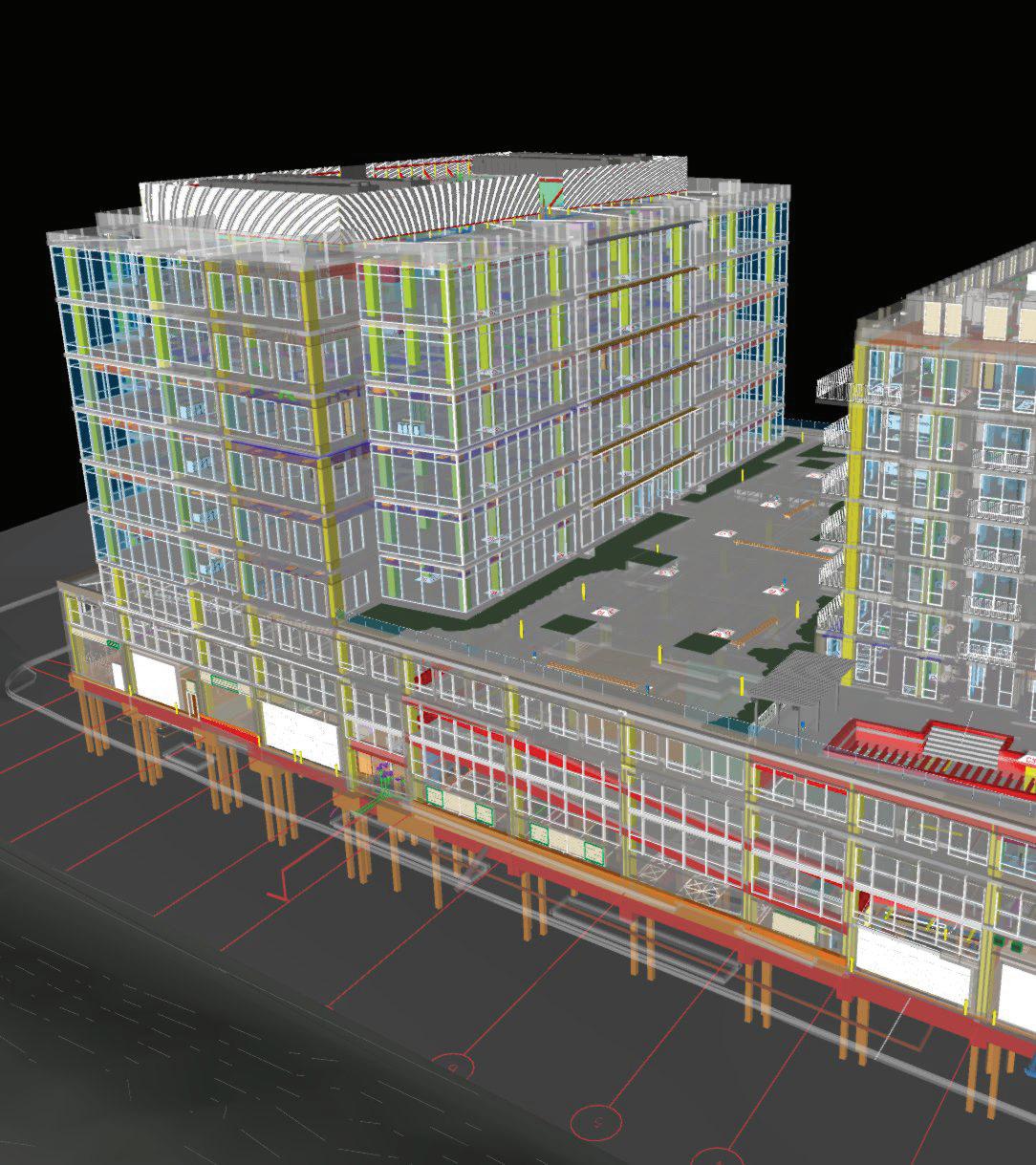
Along with the industrial sector, the multifamily space has been thriving in Cleveland, with demand for apart ment units high before, during and after the pandemic.
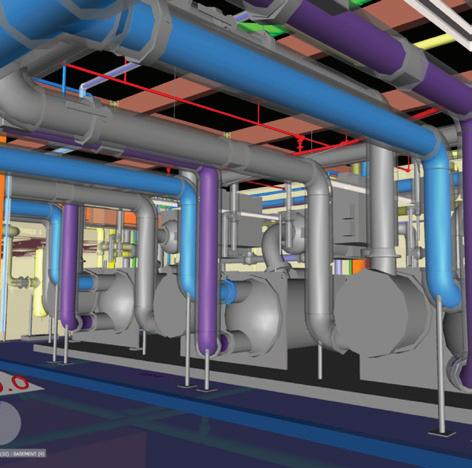
Just ask Gary Cooper, senior vice
president with the Cleveland office of Colliers. He specializes in the multi family sector and says that the apart ment market has remained resilient throughout the Cleveland market.
“It’s been another good year,” Cooper said. “Occupancies and rent growth have both remained strong. Everyone thought we’d hit a wall or show some cracks in the multifamily market. But we aren’t seeing those cracks. People are bullish moving forward.”
The only slight concern? Cooper said that the Cleveland market is showing
MIKE FURLONG, CM-BIM Managing Principal




Midwest Real Estate News | September/October 2022 | www.rejournals.com12
330.414.9970 | mike.furlong@ipsvdc.com | www.ipsvdc.com • BIM Coordination Services • Site Logistics • 3D Content Creation • Revit® • Navisworks® • 3D Studio Max • Residential Design Integrated Project Solutions We protect your future project investments through BIM/VDC to improve construction coordination schedule, reduce unexpected challenges & improve your BOTTOM LINE! CLEVELAND
on-site
that
CLEVELAND (continued from page 11)
“It’s been another good year. Occupancies and rent growth have both remained strong. People are bullish moving forward.”
a bit of rent fatigue in workforce and lower-income apartment buildings. These buildings are also seeing a small amount of collection issues, he said.
“The economy can be challenging for many people today,” Cooper said. “When you look at some people, we go to the gas pump and complain. But we are still able to buy food. For a lot of folks, to spend $200 more a month on fuel alone forces them to make some difficult choices. Then there are the rising food costs and utility bill costs. That is where we are starting to see a bit of rent fatigue. People are getting pounded from every level, every time they go to the pump or the grocery store or the home-improvement store. They are facing sticker shock today.”
Not as many renters in the workforce housing or low-income end of the market fell behind on their payments during the height of COVID, Cooper
said. Stimulus checks and enhanced unemployment checks helped them pay their bills. Now those financial safety nets have disappeared while inflation is boosting prices, making it more difficult for some to pay their rent each month.
Still, Cooper said that the situation is far rosier than what some predicted at the start of the pandemic. Back then, people worried that as many as 40% of renters would stop paying their rents. That, obviously, never happened.
What has led to the long hot streak in demand for multifamily, both in Cleveland and across the country? Cooper points in part to the soaring prices of single-family homes. The National Association of REALTORS® reported that the median sales price of an existing home hit $403,800 in July, up 10.8% from a year earlier. Last month, the median sales price hit an all-time high of $413,800.
At the same time, new apartment product comes with higher-quality finishes and amenities, Cooper said. It featured high-end kitchens and bathrooms.
“When you combine the economic fundamentals and the rental product that has been out there, you have a perfect recipe for continuing de mand,” Cooper said.
Cooper said that demand is so high in certain Cleveland submarkets that it’s difficult for renters to find space. This is especially true in many of Cleveland’s nearby suburban com munities.
“You go to properties and they say they have nothing to show you,” Coo per said. “They say they are full and they’ve even rented out the model. If there are occupancy challenges, it is usually property specific. A certain property might have maintenance is sues, a bad roof or structural issues.
But demand for most multifamily properties is very high today.”
The strength of the multifamily mar ket in downtown Cleveland is a sur prise to many, Cooper said. People still want to rent in downtown, even if workers aren’t yet coming back to their downtown offices in strong numbers, he said.
“You would think that the slowdown in office workers would lead to a slowdown in demand for downtown multifamily. But we haven’t seen that,” Cooper said. “We are seeing nothing but continued demand. How many people can pay $1,800 a month for a one-bedroom apartment in downtown Cleveland? When will this market hit a wall? I don’t know. We haven’t seen it yet.”

COLUMBUS
Poised for a bright future: Columbus’ CRE market remains a resilient one
By Dan Rafter, Editor
Abooming industrial mar ket. A multifamily sector that remains hot. And retail and office sectors that, despite challeng es, are showing positive signs. That’s what the brokers working in Columbus and its suburbs say they see today in this Ohio city’s commercial real estate market.
And in even better news? Local bro kers say they expect the rest of this year and the beginning of 2023 to be strong, too, with few signs of any slowdown in Columbus’ commercial sectors.
Consider real estate firm CASTO, which primarily focuses on retail and multifamily. Eric Leibowitz, vice presi dent of development and leasing with the company, said that CASTO has been extremely busy this year and last, and that vacancy rates at the properties it owns in the Columbus market remain low.

“The Columbus market has been strong for a long time, other than
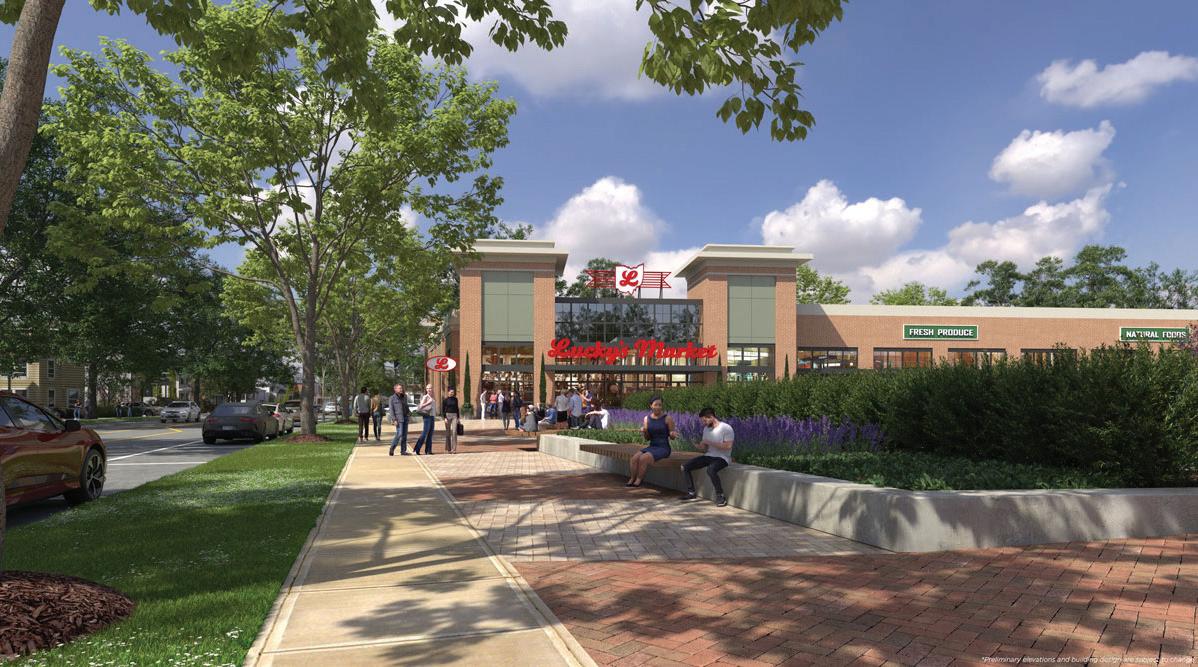
the blip that was the start of COVID,” Leibowitz said. “We have great eco nomic engines here in Columbus. We are the state capital. We have strong educational facilities, most notably Ohio State University. And companies want to locate here.”
A good example is the announcement by technology company Intel that it has selected a portion of the New Albany International Business Park in
New Albany, Ohio, as the location for a more than $20 billion chip-manufac turing facility. New Albany is located about 14 miles from Columbus.
Intel plans to build two factories here by 2025. The project is expected to generate thousands of construction and manufacturing jobs.
“The Intel announcement has created a lot of buzz,” Leibowitz said. “This
will be a big positive for the region. To what extent, we are waiting for that. But we all expect Intel’s project to be very positive for the Columbus area.”
Leibowitz said that he isn’t surprised by Intel’s decision. Many large cor porations are considering Columbus for either their headquarters or new facilities. As Leibowitz says, the qual ity of life in Columbus is strong, with plenty of entertainment and cultural
Midwest Real Estate News | September/October 2022 | www.rejournals.com14
CASTO is transforming space in Columbus’ Harrison West neighborhood into Thurber Village, a mixed-use project that will include a CVS, Lucky’s Market and 225 apartment units with structured parking.
Eric Leibowitz
“People want to stay in the Columbus area. We are seeing great activity at our multifamily properties”
options. Columbus is also a pro-busi ness community, with the city willing to take the necessary steps to create a welcoming environment for compa nies making the move here.
This high quality of life has provided a boost to the Columbus-area mul tifamily market. As Leibowitz says, demand for apartment living in the Columbus market is still strong and outpacing the supply of rental units.

“People want to stay in the Columbus area,” Leibowitz said. “There was certainly some pent-up demand for multifamily space. And our multifam ily division has been great at both urban redevelopment and finding the right opportunities in the suburban markets. We are seeing great activity at our multifamily properties.”
And while multifamily has been strong, as it has been across the country, Leibowitz said that Colum bus’ retail sector is performing well, too. He said that those retailers that reacted quickly during the pandemic

to make it easier to get their products and services to customers performed well during COVID and are succeed ing today.
Those that were slow to react to the changing shopping and dining habits of consumers during the pandemic?
They haven’t fared nearly as well, Leibowitz said.
“The retailers that we lost during
COVID were ones that we were prob ably going to lose anyway,” he said. “COVID might have expedited it, but they probably weren’t going to survive much longer. Several of our retailers found efficiencies and got better and stronger because they had to.”
Those efficiencies mostly centered around making it easier for wary consumers to shop and dine during
the pandemic. Restaurants and re tailers offered curbside pickup and enhanced their delivery options. They boosted their online presences and made ordering from their websites even easier.
And the savviest of these retailers have only continued offering these services as the Columbus area con tinues to move past the pandemic.
“The retailers who survived across the board made it easy for people to order online and schedule things like curbside pickup regardless of these consumers’ age or generation,” Lei bowitz said. “During the pandemic, we worked hard to accommodate our tenants however we could. Our job was to help them be as successful as possible. We saw a lot of creativity during the pandemic. And we’ve seen some positives come out of it both from an operational and relationships perspective.”
Certain retailers, though, have been more successful than others. One
www.rejournals.com | September/October 2022 | Midwest Real Estate News 15
nmrk.com At Newmark, we know clients’ commercial real estate needs vary by place and we take the time to tailor solutions to what the market demands. Whether through leasing, capital markets, valuation and advisory or property management, we adapt to the future and engineer strategies that address what comes next. Our Tailored Insight Empowers Your Real Estate Potential Columbus, Ohio t 614-883-1200 CASTO’s Hamilton Quarter project in New Albany, Ohio. COLUMBUS
segment that remains particularly strong is grocery-anchored retail, Leibowitz said. People need food, of course, so they continued to go to grocery stores even during the height of the pandemic. Grocery stores also appeal to those people who still enjoy going into stores instead of buying all their products online.
Retailers located near grocery stores also benefit from the spillover of supermarkets. Customers are more likely to run into a hardware store, clothing store, pet store or other retailer if they are already shopping at a grocery store in the same retail center.
“In my opinion, during the pandemic, people were looking for opportunities to get out of the house, to have a mundane task feel normal,” Leibowitz said. “That could have meant going to a hardware store or grocery store.”
A mirror to national trends?
Grant Fitzgerald, regional manager of Marcus & Millichap’s Columbus and Cleveland offices, agreed that 2022
has been a particularly strong year for the Columbus commercial real estate market.
“Things are as busy as ever,” Fitz gerald said. “Across the country, 2022 has been a record year for deal velocity in commercial real estate. Columbus is no different.”
And like in other cities, the multifamily and industrial markets are especially strong in Columbus, Fitzgerald said.
What is somewhat surprising is the strength of Columbus’ retail market, Fitzgerald said.
“Retail is doing very well in some instances,” he said. “Quality retail, especially, is doing well here. Really, Columbus is mirroring many of the trends you read about nationally.”
Fitzgerald said that demand for multi family is strong among both investors and renters in Columbus for many of the same reasons that this demand is high across the country. As Fitzgerald says, three of the country’s largest generations are simultaneously in the renter pool in the United States today.

Millennials and Generation Z are both actively seeking apartments, Fitzger ald said, something that isn’t surpris ing. But at the same time, many Baby Boomers are choosing to downsize and become renters by choice.
That has boosted the demand for multifamily space significantly, Fitz gerald said.


“It is extremely challenging to build multifamily at the rate at which we need it,” Fitzgerald said. “Part of the reason for the demand in Columbus, when compared to coastal markets, is that you can build things in a rea sonable timeframe here. The supply has attracted investors to Columbus. It’s a steady market, too, with strong, consistent employment. That has helped bring investors to Columbus for decades.”
The industrial market in and around Columbus has been strong for years. That hasn’t changed.
Columbus’ location in the center of the country helps. Companies need
to get their products to consumers quickly today. Having distribution centers and warehouses in the coun try’s center helps them accomplish this. It makes sense, then, that com panies are turning to markets like Columbus as they open more distri bution centers.
Columbus, though, also boasts other attributes that make it an attractive destination for industrial users. It has a strong transportation infrastruc ture. And Fitzgerald said that the city is friendly to businesses. It also has a highly educated workforce.
“Industrial has been so hot for so long that in some ways it is cooling off. But this is happening in a very small and healthy way,” Fitzgerald said. “You read news stories about Amazon giv ing back space and it sounds bad. But that’s just a drop in the bucket. The short-term and long-term strength of the Columbus industrial market is very good. Columbus continues to attract large corporations.”
A bright future
Fitzgerald said that he expects a bright future for Columbus’ CRE market. For one thing, 2020 made it clear that it is no longer necessary for people to live in the more expensive coastal markets of the country. As people began working remotely, they could live anywhere. Markets like Columbus became more attractive because of their cost of living and high quality of life.
“For the price of a 400-square-foot palatial closet in Manhattan you could get a 2,000-square-foot Class-A apartment building in Columbus’ Short North neighborhood and have a much higher quality of life,” Fitz gerald said. “Columbus is a desirable market for people. You get more bang for your buck.”
Like other real estate firms in Colum bus, CASTO has been busy planning and creating new mixed-use develop ments in the market. One of the big gest is Hamilton Quarter, located just a couple of miles from the location of the new Intel development in New Albany, Ohio.
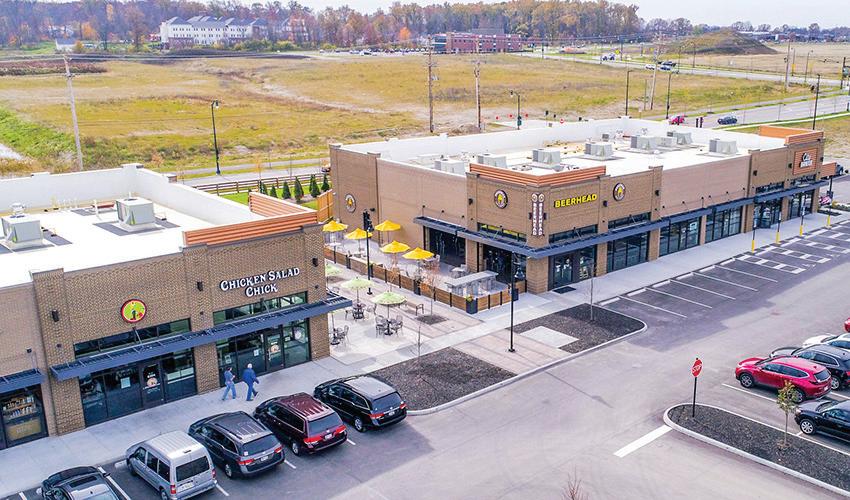
This project includes the corporate headquarters building of Big Lots, a Target store, a medical facility and about 700 apartment units.

Midwest Real Estate News | September/October 2022 | www.rejournals.com16
COLUMBUS Experience Thrive Communities info@thrivecos.com | thrivecos.com
CASTO’s Hamilton Quarter project includes a significant amount of retail.
“It is the definition of mixed-use,” Leibowitz said. “This is a place where people can get everything they need. It’s one-stop shopping. You can get your groceries and your soft goods. There are great restaurants nearby. We have multifamily housing. It’s a great blend of uses.”
This good news, though, doesn’t mean that real estate firms don’t face chal lenges today. New construction can be especially difficult with the continuing supply chain disruptions. It is difficult to get many materials on time today, and the price of those materials con tinues to rise.
CASTO is dealing with this by involving its construction groups into leasing conversations earlier. This way, these construction professionals can explain that if a project needs to be delivered on a certain date, they need to order specific materials on a certain date, too.
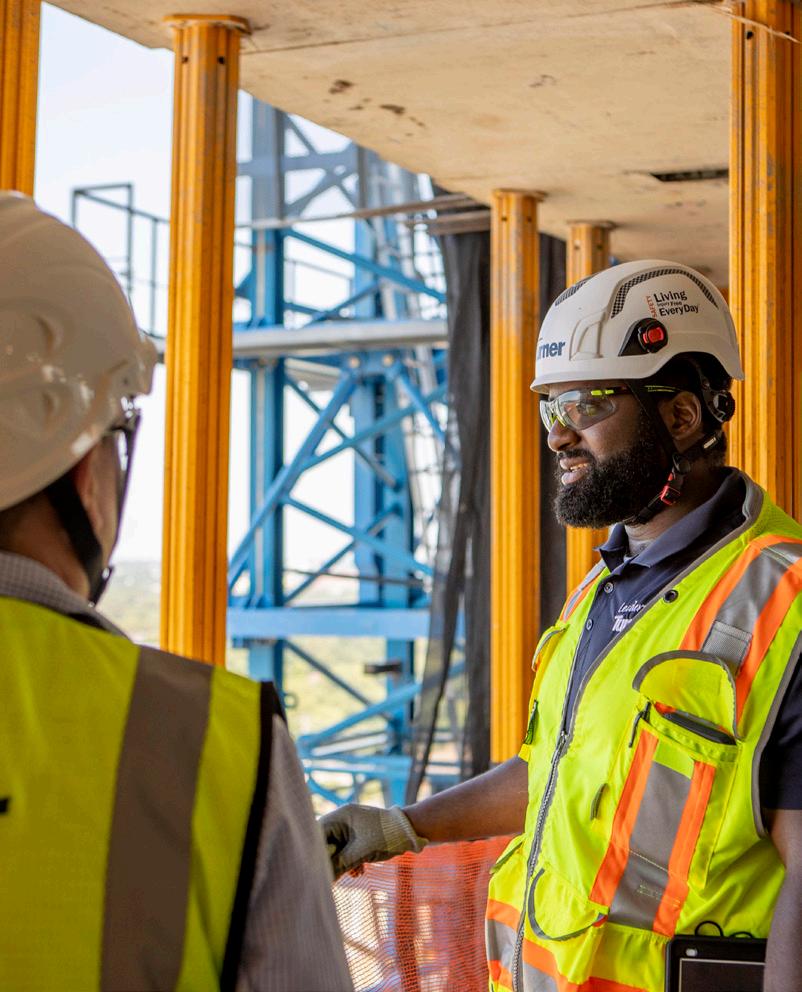
As Leibowitz said, it’s all about coordi nating schedules more efficiently.
“The way CASTO has been set up for many years has prepared us for pret


ty much anything,” Leibowitz said. “The way we are operating now is not different than the way in which we op erated four or five or 10 years ago. We are adjusting based on what is going on around us. We have everything in house. We can coordinate within our own building, which makes the entire process easier.”
Rising interest rates, of course, are a concern, too. As Fitzgerald says, high er rates will slow some deals. But Fitz gerald isn’t predicting that these rates
will cause any significant downward trend in the local CRE market.
“There is quite a lot of money out there,” Fitzgerald said. “The average person’s cash-in-hand is high com pared to where it’s been in any other downward economy before. People have money in their bank accounts. Funds have money. Wealthy individ uals have a lot of liquid cash. Rising interest rates will make the cost of capital more expensive. But if people have a lot of money out there ready to
go, this won’t make as big of an impact as if people needed every dollar they had.”

At the same time, commercial real es tate remains an attractive investment. When compared to other investments, commercial real estate remains a safe and steady option, Fitzgerald said.
“Commercial real estate is outperform ing other assets,” he said. “Until that is no longer true, people will continue putting their money in real estate.”

www.rejournals.com | September/October 2022 | Midwest Real Estate News 17
COLUMBUS
Grant Fitzgerald
“Commercial real estate is outperforming other assets. Until that is no longer true, people will continue putting their money in real estate.”
Challenging times? They’re nothing new for a resilient Detroit
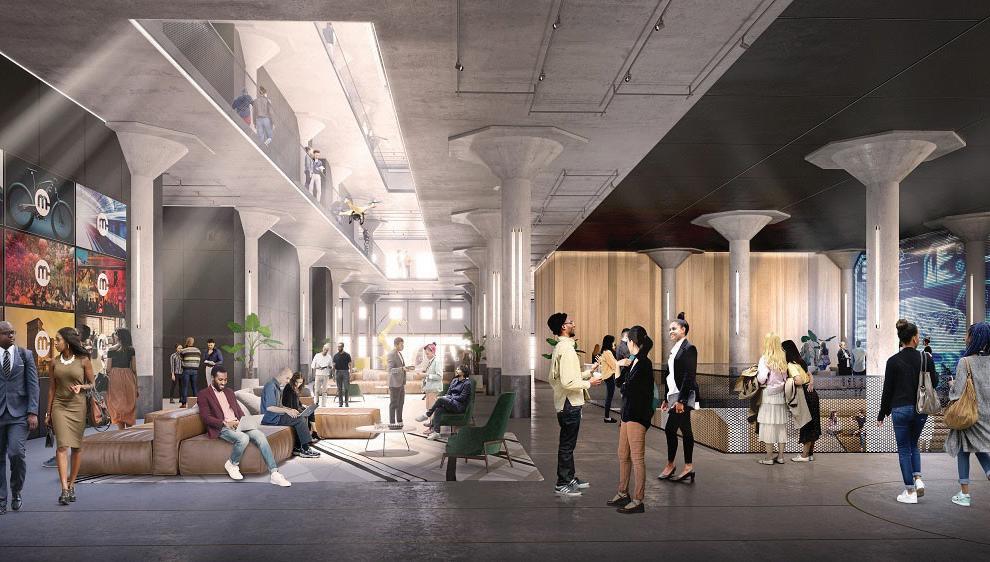 By Dan Rafter, Editor
By Dan Rafter, Editor
How busy has the multifamily sector been? Just ask Greg Coulter, managing member and founder of Income Prop erty Organization in Bloom field Hills, Michigan. He says that he’s never seen more activity in this sector.
And that’s pretty impressive, consid ering how long Coulter has worked in commercial real estate.
“I’ve been doing this for 31 years. I’ve never seen anything like what we’ve had in this sector in the last 24 months,” Coulter said. “Cap rates are at all-time lows. Demand is high. Cap ital is out there everywhere you look. It’s been incredible in multifamily.”
And the best news? There are few signs that demand for multifamily space, both among renters looking for a place to live and investors searching for a safe harbor for their dollars, is ready to slow anytime soon.
Don’t expect, then, new sales and development of multifamily space to suddenly slowdown in the com ing months.
The threat of rising interest rates?
This doesn’t mean that rising inter est rates aren’t a concern. Coulter said that in the last 60 days, ac quisition activity in the multifamily sector has tightened slightly. But still, demand for multifamily assets remains high among investors, even with the economic uncertainty now plaguing the country, Coulter said.
Coulter points to his hometown market of Detroit. In Detroit’s Mid town, Corktown and CBD areas, de mand for multifamily space, both among renters and investors, con tinues to soar. Monthly apartment rents are still rising and cap rates remain low.
In the more tertiary markets of Detroit, though -- those city neighbor hoods located farther from the CBD and downtown -- demand is slowing slightly. Coulter said delinquencies are higher in these areas, making multifamily properties here less de sirable to investors.
But “less desirable” doesn’t mean “undesirable,” even in the city’s ter tiary markets.
“The tertiary markets are seeing more multifamily properties up for sale,” Coulter said. “And these properties have more issues when it comes to delinquencies and collections. But still, the demand for these properties is there. It might not be as high as in the areas around the CBD, but people are still buying these properties.”
What’s behind the continued demand among investors and renters for mul tifamily space? Coulter points to in
terest rates first. Yes, rates have risen recently. And that does throw some uncertainty into even the strong mul tifamily sector.
But historically, interest rates remain low. This makes it more affordable for investors to purchase multifamily as sets. And the demand for rental units remains high, meaning that investors continue to make solid returns on their multifamily assets.
“People always need a place to live,” Coulter said. “That still holds true. There is a lot of capital out there look ing for a home. Investors still see the long-term prospects for multifamily as being solid.”
Also interesting has been the perfor mance of monthly apartment rents. Apartment rents continue to increase on a year-over-year basis across the country. Coulter says that in Detroit, monthly apartment rents are up 3%
Midwest Real Estate News | September/October 2022 | www.rejournals.com18
DETROIT
Ford’s tech campus project in Detroit’s Corktown neighborhood will transform the formerly vacant Michigan Central Station.
to 4% when compared to a year ear lier. In the suburbs, apartment rents are up 3.5% to 9% year-over-year, depending on the community.
Because demand for apartment units has been so high for so long, it can prove challenging for renters to find units. The National Multifamily Housing Council says that the Unit ed States would need more than 4 million additional apartment units to meet the demand that consumers have for multifamily space.
And in most major markets across the United States, there is nowhere near enough apartment units to meet the demand for them.
“They are working on bringing new units to market, but you can only build so fast,” Coulter said.
In the Detroit market, builders are adding new apartment projects in communities such as Auburn Hills, Rochester Hills, Troy, Royal Oak, Novi and Westville. And in Detroit itself, developers are repositioning outdat ed industrial facilities, turning them into trendy multifamily spaces.
What does the future hold for the multifamily market, in Detroit and across the country? Coulter said that he expects demand for apartments to remain strong among both renters and investors.
“I think interest rates will go up some
more in the next 12 months. But the demand for multifamily space is still high and the supply is still low,” Coulter said. “We had a little blip, a little slowdown just now because in terest rates rose so fast. I think that was a shock to people. But it seems like the multifamily market is heating up again already. I think the popula tion is already getting over the higher interest rates. I think demand for multifamily space, then, will remain high. I see no reason why that won’t be the case.”
A diversified economy is key
Andrew Farbman, chief executive officer of Southfield, Michigan-based Farbman Group, said that Detroit today benefits from a diversified economy.
As Farbman says, Detroit ranks as one of the mortgage-lending capitals of the country, with three of the largest producers of residential loans based in southeastern Michigan. At the same time, the Detroit market has benefitted from the rising demand in autonomous and electric vehicles, with major auto makers working on this technology here.
Another positive? Ford is getting clos er to occupying its new space in De troit’s Corktown neighborhood. The auto giant purchased the formerly vacant Michigan Central Station and plans to transform it into a campus dedicated to new technology.

“Once that opens, it will be a signif icant driver in that marketplace,” Farbman said. “Detroit is fortunate that we now have three submarkets – Corktown, Milwaukee Junction and
Eastern Market – all finding their foot ing in the tech hub. Watching them compete for tech businesses has
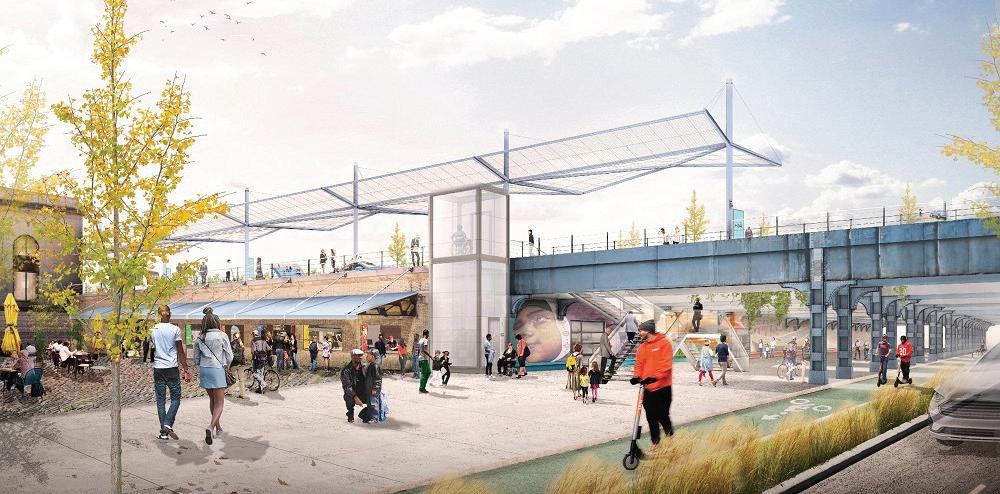
www.rejournals.com | September/October 2022 | Midwest Real Estate News 19
DETROIT • Asbestos / Lead /Mold Consulting • Building & Infrastruc ture E valuations • Construction Materials Testing • Environmental Services • Geotechnical Ser vices • Indoor Air Qualit y Consulting We Provide: (continued on page 20) A rendering of Vernor Plaza, one of the public spaces of Ford’s Michigan Central project.
DETROIT
been interesting. Hopefully, they are all successful. They all have former loft buildings that can be converted to new-age loft office space and res idential. It’s an interesting time here.”
The Detroit market is fortunate, too, in that the problems facing the of fice sector across the country aren’t having as much of an impact here. Farbman says that the office sector is not as significant a portion of the user base in downtown Detroit as it is in the downtowns of other major Midwest cities.
“We are seeing less of an impact here from the work-from-home movement going on with some of the younger workforce,” Farbman said. “Detroit is healthier today and is moving along on its path of becoming a true 24hour global city. It is fun to see.”
The Detroit market is benefitting, too, from the number of national banks that are expanding their presences in Southeastern Michigan. Old National Bank and Citizens Bank have each ex panded their footprint in the market.
As in most markets, the multifam ily and industrial sectors are the strongest today in the Detroit area,
Farbman said. And even with the challenges of rising interest rates and construction costs, industrial, at least, looks to remain strong through out the rest of the year and into 2023.
“No matter what town you are in, the industrial market and the growth of the industrial market has been fairly rampant,” Farbman said. “Occupan cies are at historical highs. Demand seems infinite when you are showing industrial space. The amount of activ ity in that sector is shocking. We’ve seen rents take a nice move forward in industrial, too. We are seeing some new developers focusing on our mar ket than we had seen in the past. That is exciting to see.”
Multifamily remains strong in the Detroit market, too, Farbman said. However, when it comes to valuation, Detroit and southeastern Michigan tend to trail other Midwest apartment markets, Farbman said.

That is slowly changing, though. Farb man said that a greater number of in stitutional investors are sinking their money into Detroit-area apartment developments. That is pushing values a bit higher today, he said.
The challenge for investors is that the supply of multifamily properties in Detroit and its surrounding commu
nities is still too low to meet the de mand for them. And Farbman doesn’t see this changing soon.
“It is still so hard to find good infill sites,” Farbman said. “You do see more multifamily product coming in the edge cities and in some of the growth pockets of western Wayne and western Oakland counties. Those communities continue to grow in pop ulation, so they need new multifamily product. The growth of multifamily supply, then, is not as dramatic in the Detroit market as it is in some of the other communities we cover, but it is happening.”
The good news in the office sector is that most employers in Southeastern Michigan are back to work today, Farbman said. This doesn’t mean that the amount of office traffic is the same today as it was before the pandemic hit. But many companies have made their post-pandemic work plans here, and that certainty has helped the office sector in Detroit and its nearby communities.
Farbman said that office activity in downtown Detroit has rebounded faster than it has in larger cities such as Chicago.
“Detroit’s resiliency is partly be cause a good portion of the city is
not mass-transit-focused,” Farbman said. “The cities that rely heavily on mass-transit systems have been the slowest to recover when it comes to the office market. Our office market is also spread out a bit, with a smaller concentration of our office space in Detroit proper. That has helped as of fice space in suburban markets tends to have lower vacancies right now.”
The retail sector in the Detroit mar ket is firmly in rebound mode, too, Farbman said. This is especially true of infill locations in busy city and sub urban neighborhoods.
“I am bullish on retail in general,” Farbman said. “The location and land are so reusable and adaptable.”
As Farbman says, the pandemic did slow some of the momentum that Detroit, and specifically its CBD, had been seeing. But commercial real es tate activity in the city is picking back up again, he said.
“Detroit has seen plenty of tough times in the past,” Farbman said. “We are a tough city, and we work hard to recover from those challenging times. That is happening now.”
Midwest Real Estate News | September/October 2022 | www.rejournals.com20
DETROIT
(continued from page 19)
Elton Park Corktown Apartments is one of the newer, and more popular, apartment developments in the Detroit market.
A solid office sector
The performance of Omaha’s office sec tor is a prime example of the strength of the city’s CRE market.

Sam Noddle with Omaha’s Noddle Companies said that the office market in Omaha is busy today, with leasing activity high all the way from downtown Omaha to the urban core neighbor hoods to the suburbs.
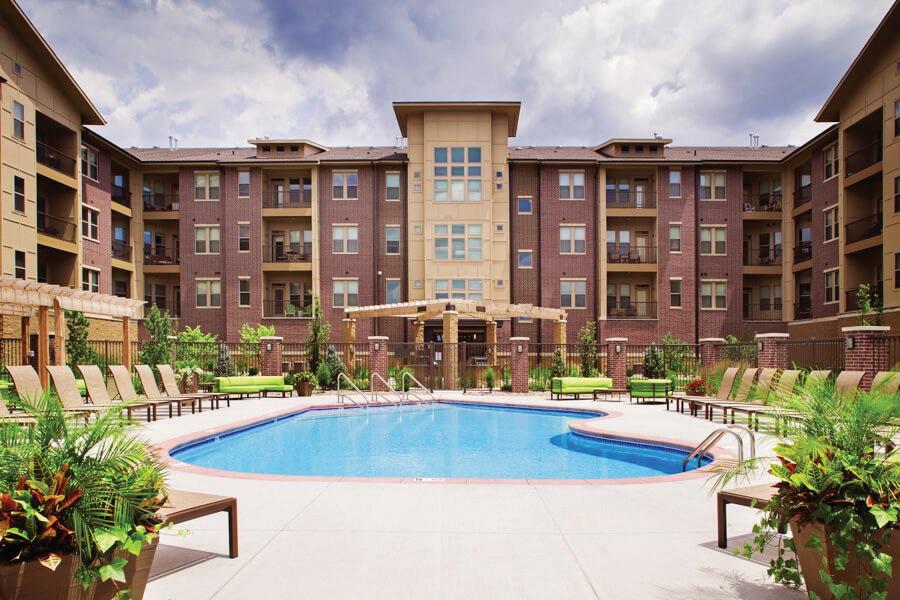


And if that sector, which is struggling so much across the country, is holding its own? That’s a sure sign that Omaha’s entire CRE market is performing well.

“I would say that we are shocked at how busy the office market is in Omaha,” Noddle said. “All of our office space is leasing. Like with all markets, we are seeing companies looking for more valuable tenant improvement packages. And the cost of construc tion has gone up so much. But we are
Noddle points to the thriving Aksar ben Village mixed-use development, of which Noddle Companies has played a key role in developing and managing. Toast, a merchant proces sor for food and beverage companies, recently signed a 50,000-square-foot lease in the village. This lease means that for the first time all the office
“What we have noticed is that a lot of officer users still want office space, and for the most part they still want the same amount of space,” Noddle said. “They need a place for their team to huddle and work. But they are designing the space differently. They want more collaborative space. Workstations are designed for threeand four-day workweeks. But they
Amenities matter, too, as companies look for anything they can offer to entice their employees back to the office. That’s a positive for Omaha developments like Askarben Village, Noddle said. The village, for instance, offers a food hall with a wide variety of vendors. There’s a dog park with a bar that operates out of an old Air stream trailer.
The retailers that occupy Aksarben Village give office workers plenty of options, too. Noddle points to the yoga studio that holds outdoor class es, the running shop, bookstore and flower shop.
“All of these retailers and amenities have made it so easy to lease office space in Aksarben Village,” Noddle said. “Office workers want to be around this kind of atmosphere.”
Noddle said that Omaha’s retail mar ket has remained solid, too. Again, he pointed to Aksarben Village. There is only about 5,000 square feet of space left to lease there, all of it retail.
T h e W a t e r f o r d B u i l d i n g 1 9 2 n d S t r e e t & W e s t D o d g e
T ' S A B O U T M O R
H A N B
W h e n y o u d e v e l o p , l e a s e a n d m a n a g e b u i l d i n g s a s a l o n g t e r m o w n e r , y o u ' r e n o t j u s t i n v e s t i n g i n r e a l e s t a t e . Y o u ' r e i n v e s t i n g i n a c o m m u n i t y
F r o m C l a s s A o f f i c e p a r k s w i t h r o o m t o g r o w a n d a m e n i t i e s
l i k e f i t n e s s c e n t e r s a n d f l e x i b l e c o l l a b o r a t i o n s p a c e s t o m o d e r n w a r e h o u s e s w i t h E S F R f i r e s u p r e s s i o n s y s t e m s a n d 3 2 f o o t c l e a r h e i g h t s , R & R i s u n i q u e l y a b l e t o h e l p o u r c u s t o m e r s f i n d t h e r i g h t s p a c e s t h a t e m p o w e r g r o w t h f o r b o t h t h e i r b u s i n e s s a n d f o r g r e a t e r O m a h a
T h a t ' s q u a l i t y y o u c a n t r u s t
T a l k t o o u r t e a m o f O m a h a w o r k s p a c e e x p e r t s t o d a y :
www.rejournals.com | September/October 2022 | Midwest Real Estate News 21
OMAHA (continued from page 1) (continued on page 22) W E ' R E P R O U D L Y I N V E S T I N G I N O M A H A ' S F U T U R E . I
E T
U I L D I N G S .
MIKE
HOMA President, Nebraska Division COOPER WILSON Manager, Brokerage & Development RRREALTY.COM/NEBRASKA | (402) 885 4002
OMAHA
The Aksarben Village mixed-use development in Omaha features apartments, office space, retail, restaurants and public parks.
Noddle said that this space probably could have been leased, but that Noddle is waiting for the right retail for this location.
Noddle said that this space doesn’t need more restaurants. Instead, Nod dle is looking for something different, preferably a fashion-based retail use, something that is missing from the village now.
The goal, Noddle said, is to bring in retailers that provide excitement to the community. The fact that Noddle can be so selective? That, too, speaks to the strength of the commercial real estate market in Omaha.
“People are more excited about being out there right now,” Noddle said. “Since the COVID restrictions have been lifted, sales in our food hall have grown tremendously. They are up about 40% year-to-date. The bar that we opened last year is extremely busy. We have noticed a lot more ex citement in the air. People are eager to get out there and be social again.”
Another major project in Omaha is the Builder’s District, also being developed by Noddle Companies. Kiewit, when it moved its headquar ters to 15th and Mike Fahey streets in Omaha, provided the impetus for this project. The goal here is to populate the area surrounding this building with multifamily units, office space, retail and an urban park.
The project will cover about six city blocks and will include a 130,000-square-foot office building made primarily of timber. Noddle says that the project will include sports courts, giving people space to play volleyball and pickleball.
Noddle expects to break ground on the project early next year.
“I am cautiously optimistic when it comes to the commercial real estate market here,” Noddle said.
Noddle did say that the cost of con struction and materials remains a challenge for companies like Noddle Companies. The long lead times be tween ordering materials and receiv ing them is a problem, too.
“It doesn’t matter what it is, a heat pump, an electrical panel or even a door,” Noddle said. “There was a door system we were going to buy. The price was crazy and it had a 16-week lead time. That has certainly changed the way we are thinking about deals. The costs of construction and lead times are definitely impacting this business.”
Not enough product out there?
Brian Kuehl, a broker with Omaha’s Investors Realty, agreed that the retail market in the city and suburbs has been resilient. He pointed to the steady absorption levels in this sector during the last two years.
Kuehl said that the retail vacancy rate throughout the Omaha market
is about 5%. At the same time, retail asking rents are on the rise.
“There is actually a bit of a lack of product out there to lease,” Kuehl said. “There is some pent-up demand from businesses that are frankly run ning out of space.”
Part of this can be traced to the pan demic. Construction stopped during the earlier days of COVID. Then supply shortages hit. The cost to deliver new construction is now high. This has re sulted in a slowdown in the amount of new retail space being built through out the Omaha market, Kuehl said.
And Kuehl hasn’t seen many signs that supply chain issues are easing. He said that the bids that Investors Realty solicits for general contractors are about 20% to 30% higher than they historically have been.
“I don’t see a real softening,” Kuehl said. “You hear chatter that the supply chain situation has gotten a little bit better. But that has not trickled down to Main Street yet.”
Even with these challenges, though, the retail sector has remained solid throughout the Omaha market, Kuehl said, with plenty of demand for retail space.
Kuehl said that the most successful of retailers have embraced the om nichannel approach, relying on both their websites and brick-and-mortar locations to keep sales strong. Retail ers have also embraced many of the conveniences they launched during
the pandemic, including curbside and in-store pick-up options and enhanced delivery.
What has changed today is that shop pers, even though they can buy plenty of goods online, are also eager to get into physical stores and socialize again. That has led to a growth in ex periential retail in the Omaha market, with concepts like pickleball venues, indoor mini golf and high-end bowling alleys rising in popularity.
“People want to be entertained,” Kuehl said. “They want an experience. We are seeing people come back out. People are shopping in person again.”
Earlier this year, Omaha officials approved the initial route for a new downtown streetcar that will travel from the city’s riverfront to 42nd Street. The route will also travel along Farnam Street with loops around the city’s Chi Health Center.
Kuehl said that the streetcar system will provide another boost to Omaha’s retail sector. He says to expect new mixed-use development along the streetcar route.
Heartwood Preserve is another major development that is boosting the entire Omaha commercial real estate market, Kuehl said. This 500-acre mixed-use project in west Omaha fea tures, or will feature, seniors housing, multifamily, single-family homes, re tail and office uses. Open green space will also be a key at this development located on the former Boys Town site in Omaha.
Then there is Mutual of Omaha, which is building a new skyscraper at 1614 Dodge St. in downtown Omaha. The expected completion of this project is 2026.
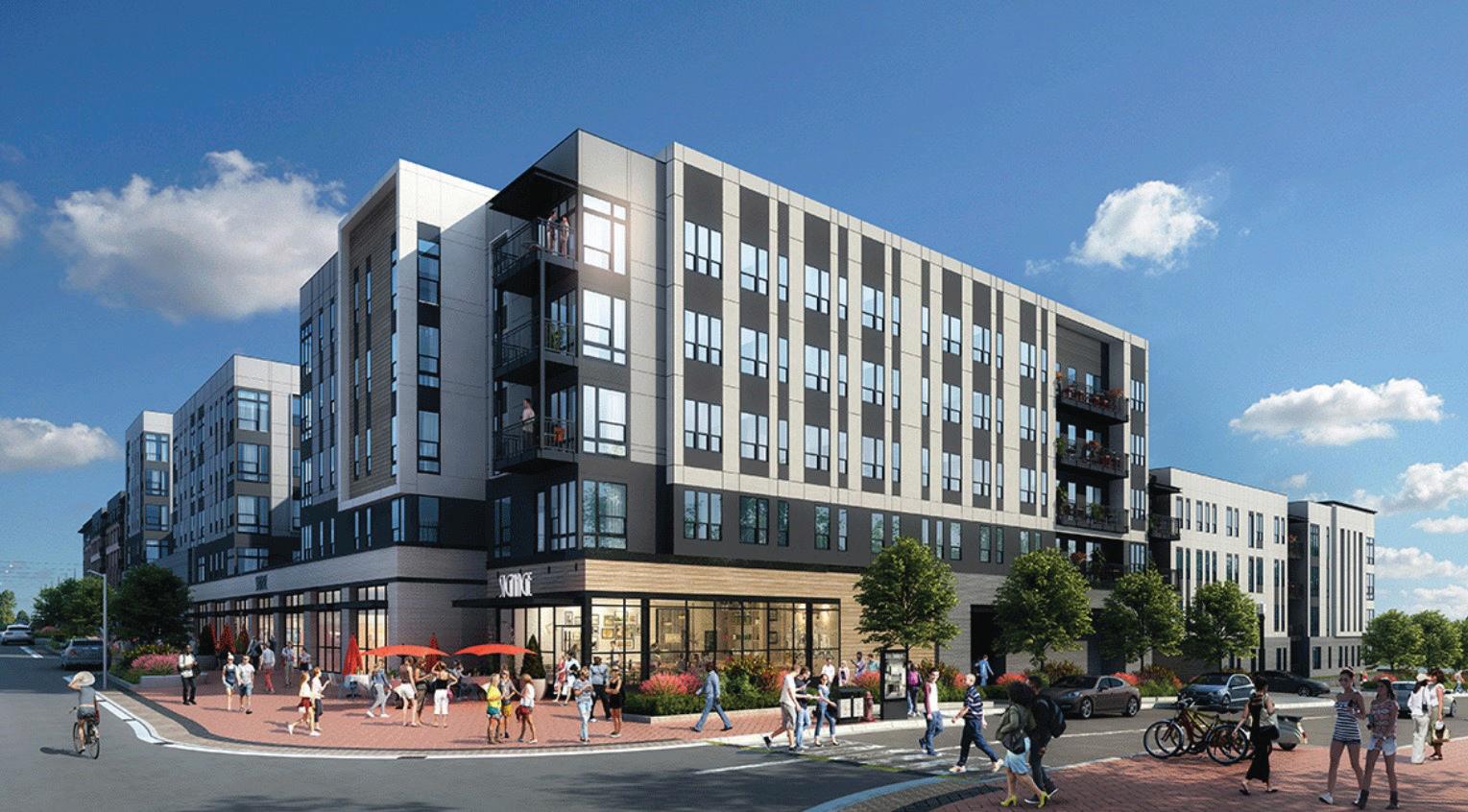
“There is a little bit of everything out there,” Kuehl said. “The market seems pretty darn strong.”
Kuehl credits much of the success of Omaha’s retail sector to the desirability of the city itself. Plenty of people have moved into Omaha and its suburbs in recent years. And as more people ar rive, they need more restaurants and shops to serve them.
“The residential market has been very strong, very robust here,” Kuehl said.
Midwest Real Estate News | September/October 2022 | www.rejournals.com22 OMAHA
OMAHA
(continued from page 21)
The Mercantile, a mixed-use project developed by Hines, will feature apartment buildings, a boutique hotel, office buildings and a landscaped boulevard.
(continued on page 24)

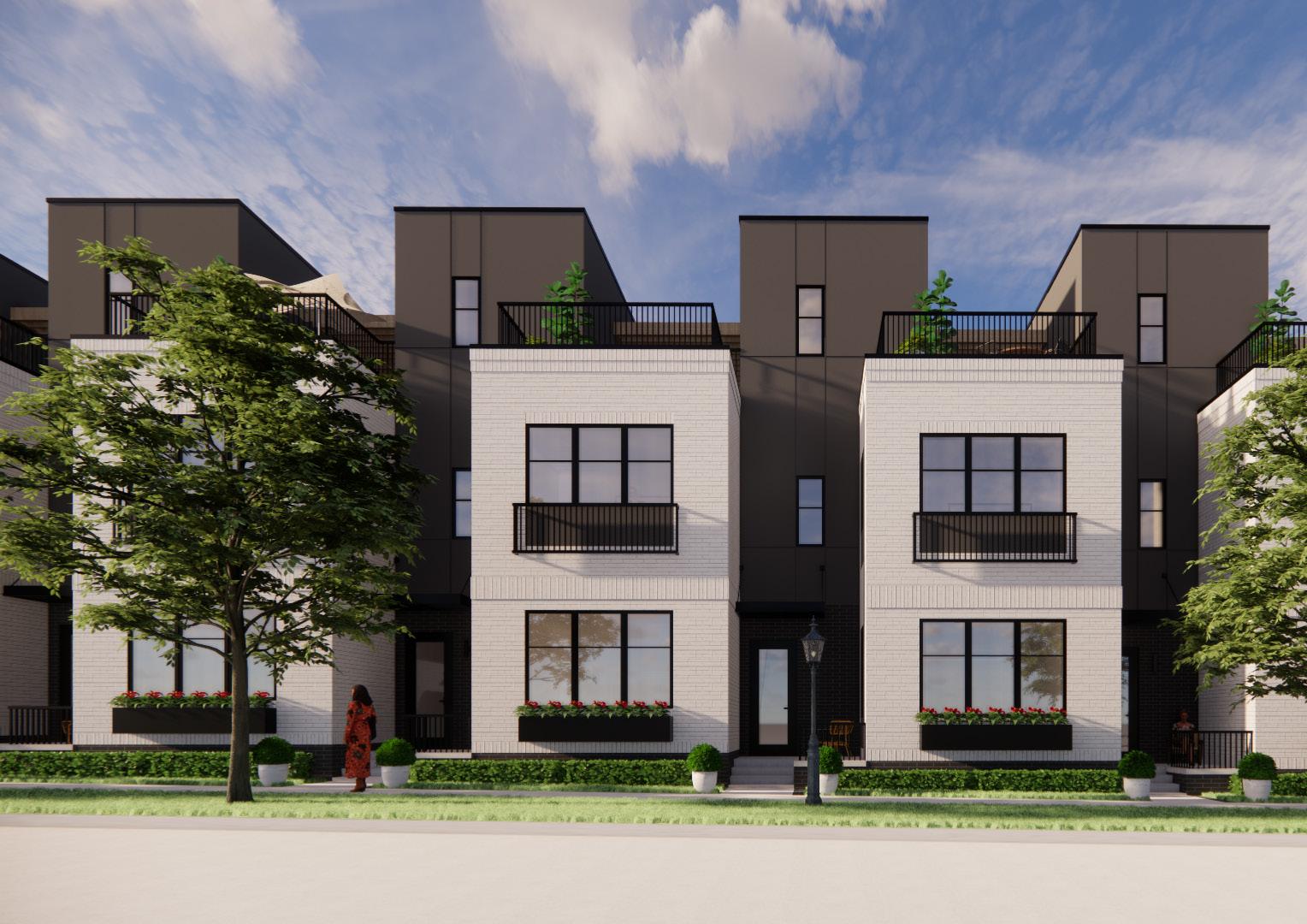


village pointe campus: NEBRASKA MEDICINE MEDICAL OFFICE BUILDING At Noddle Companies, we believe each project can help shape a community. As a Commercial Real Estate Developer, Property Manager, and Investment Company, we are proud of the work we do in the Omaha Metro. to our clients, teammates, and community at large for allowing us to be part of our growing city. THANK YOU COMMUNITY. 2285 South 67th Street Suite 250 Omaha, NE 68106 info@noddlecompanies.com 402.496.1616
noddle
homes: DEWEY ROWnoddle homes: ROWHAUS
builder’s
district: 1501 MIKE FAHEY
“As the number of rooftops expands, you need neighborhood and service retail. Our residential market might slow down a bit because of the change in interest rates and construction costs. But it has been so strong for so long.”

Kuehl is seeing positives in the downtown retail market, too. As in most cities, Omaha’s downtown was hit harder than other areas of the market during the pandemic. But many employers have started bring ing people back to the office. While foot traffic in downtown Omaha is not back to normal levels yet, Kuehl
said, more people are visiting down town again.
That is good news for retailers, he said.
“We were different than a lot of other states,” Kuehl said. “Nebraska kind of kept going even during COVID. We were not quite as stringent with our shutdowns or lockdowns as some other states were. We were not shut down as long as other parts of the country. I think that has helped our downtown a bit. We are seeing traffic rebounding in downtown.”
No slowdown in industrial
As it is in most markets across the country, the industrial sector is boom ing in Omaha and its surrounding com munities. And also as in most markets, there is little indication that the sector is heading for a slowdown in the near future.
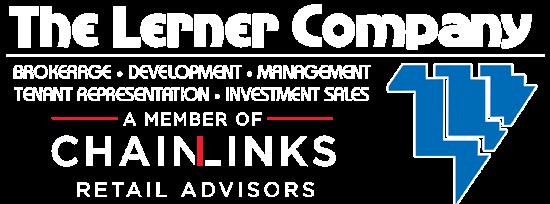
Denny Sciscoe, director of industrial services at Cushman & Wakefield/The Lund Company, said that demand for industrial space in the Omaha market is just as high this year as it was last year, and 2021 was a banner year.

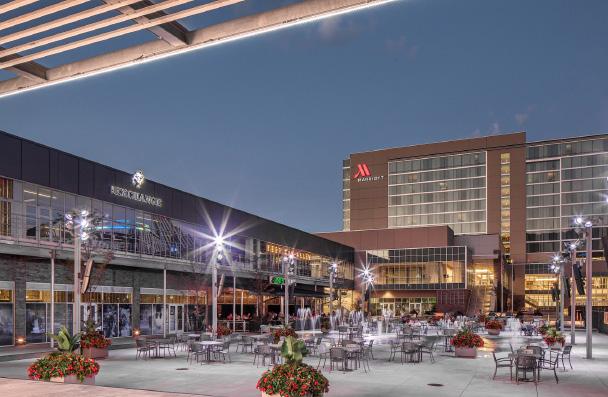
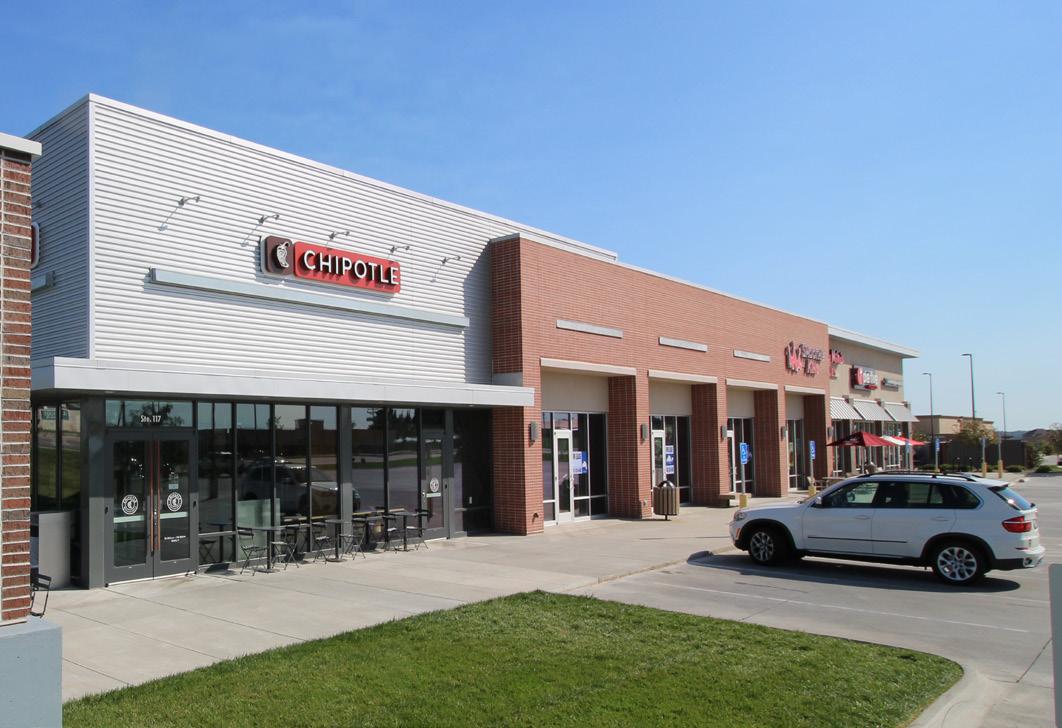
This is no surprise. Sciscoe said that the industrial market in Omaha has been on a hot streak since 2017. De mand for industrial space among end users and investors has only grown since the start of COVID, he said.
Part of the reason for this strong sector? Supply. There isn’t enough industrial space in the Omaha market to meet the demand for it.
“Back in 2017, 2018 and 2019, we had hardly any new industrial development going on,” Sciscoe said. “This year, we are developing about 2 million square feet of industrial space. We are trying to catch up, but we are still behind. People come through the chamber of commerce and are told that the space they are looking for doesn’t exist. When we do add the supply, that only increases the demand, believe it or not, because it is actually available, it is property that people can lease.”
Sciscoe says that the Omaha market has never seen as much spec indus trial construction as it is seeing now. But no one is worried about filling this space, he said, as most new buildings are leased before construction is fin ished.
“We are in uncharted territory,” Scis coe said.
Much of the demand for new industrial space is fueled by the growth in ecom merce, of course. But the onshoring movement has helped, too. During COVID, many companies realized that they could no longer rely on the “justin-time” model of shipping products. They needed more warehouse space and manufacturing facilities in the United States.
When companies bring manufacturing facilities back to the United States, they gain more control over their sup ply chain, Sciscoe said.
The future looks bright for Omaha’s industrial market, Sciscoe said. The growth in ecommerce that was hap

OMAHA (continued from page 22) LEASING TENANT REP INVESTMENT SALES DEVELOPMENT
pening before the pandemic only accelerated during COVID, he said. Consumers today are comfortable or dering anything online, and this trend is not going to change.
“It seems like we experienced about five years of expected ecommerce growth in just 12 months,” Sciscoe said. “The pandemic accelerated the growth of ecommerce more than any one expected.”
Omaha also boasts several advan tages that make it a strong market for industrial end users. As Sciscoe says, the city’s population contin ues to grow, and companies like to locate their distribution centers and warehouses near growing population centers.

Omaha benefits, too, from a strong highway system, with busy Inter state-80 running through it. Land prices aren’t overly expensive here and the labor pool is deep and strong.
“It’s also about timing,” Sciscoe said. “All the primary markets were first when companies were looking for warehouse and distribution center space. Then the secondary markets got filled in, places like St. Louis and Louisville. Now it is the tertiary markets’ turn in this cycle. The time has come, we have the Amazons and Facebooks and Googles here. It’s the evolution of the cycle that we are in.”
One headwind that the industrial market is facing? Not surprisingly, Sciscoe points to rising interest rates.

Higher rates have not slowed the leasing side of the market, Sciscoe said. But it has slowed activity from the capital markets side. There has been some slowdown in the number of investors looking to buy or sell buildings, Sciscoe said.
“Everyone has sort of hit pause for a bit,” he said. “Once interest rates go up, cap rates tend to go up and that means lower sales prices for sellers. Everyone is adjusting to this new norm. It will take some time to adjust to the new normal. I think it will take one or two new sales to reset the market.”
A busy future
Brinker Harding, senior vice president with the Omaha office of Colliers, said that the development activity happening in the Omaha market is unusual because it is taking place everywhere.
“If you go from the Missouri River to the east, the Elkhorn River on the west and all the way from south Omaha to north Omaha, there are projects happening in every submar ket that are exciting,” Harding said.
“There is so much going on still, in spite of what we are seeing with the headwinds of rising interest rates and soaring inflation.”
Brinker said that the many projects taking place in the downtown Omaha area have provided an especially sig nificant boost to the area economy. The RiverFront project in downtown is a good example: It combined three
separate parks into one large public green space. This, of course, has at tracted plenty of retailers and restau rants to this slice of downtown.
There’s also The Mercantile, a mixeduse project overlooking Heartland of America Park lake in downtown

Omaha. The project, developed by Hines, will feature apartment buildings, a boutique hotel, office buildings and a landscaped boulevard. Hines will also build a 720-car parking structure that will be owned by the City of Omaha.
Baird Holm LLP is consistently ranked as one of the Midwest’s Top Firms for Real Estate. Our real estate and finance team has the experience necessary to counsel owners, developers and lenders in complex property, development and financing matters.

Our distinctions include:
• Ranked Band 1 (highest tier) in Chambers and Partners real estate category
One attorney in the Omaha Real Estate Hall of Fame
Two attorneys in the American College of Real Estate Lawyers
Four real estate attorneys in the Best Lawyers in America
Five Chambers-ranked real estate and land use attorneys
bairdholm.com
1700 Farnam Street, Suite 1500 • Omaha, NE 68102 • 402.344.0500
•
•
•
•
(continued on page 26)
Brinker said that this activity doesn’t surprise him. Developers have been busy in Omaha for several years now.
Like others working this market, Brink er cites the office sector as a solid one in Omaha. Office vacancies remain reasonable here, even with all the new office construction taking place, he said.
“I think the strength of our office market is a reaction to what happened during COVID,” Brinker said. “How Omaha and the state of Nebraska reacted to COVID put us in a desirable position as it relates to the potential growth of our market. And because of how we were able to position our selves coming out of COVID is in large part helping us against the headwinds of rising interest rates and inflation. I think we were proactive enough to anticipate what the issues might be without overreacting to those issues.”
It helps, too, that Omaha remains
attractive to companies seeking to expand to new locations, Brinker said.

“We have a very vibrant downtown and very busy midtown and suburban areas, too,” he said. “There is a great variety in where you can live and where you can work. We have a downtown environment that has been exploding with multifamily and commercial and retail development. That is very attrac tive to many people.”



Like other brokers, though, Brinker does have concerns about how rising interest rates and inflation might im pact commercial real estate deals. He says that Omaha is seeing a bit of a slowdown in building permits already.
Even the city’s red-hot single-family housing market is slowing, Brinker said. Homes that went on the market recently were regularly generating eight offers in the first 24 hours of going up for sale. That has eased up
a bit, though the housing market re mains solid, Brinker said.
But even with these challenges, Brink er said that he expects demand for commercial real estate to remain high in Omaha. He also expects renters to continue to seek out multifamily units here, companies to hunt for distribution and warehouse space in the Omaha market and retailers to open new locations in what has been a steadily growing city.
“There are so many good things hap pening in Omaha,” Brinker said. “We have such a robust economy. It will continue to grow. One of the things that make us such an attractive com munity is the willingness of the people who live here to continue to invest here. And it’s not only that they want to invest in commercial real estate, they want to invest in the community. We have an incredible philanthropic community here. That interest that people have in investing in Omaha, both in bricks-and-mortar and com munity projects, is what makes Omaha really strong.”

Midwest Real Estate News | September/October 2022 | www.rejournals.com26 OMAHA
OMAHA (continued from page 25) Since 1975, Investors Realty, Inc. has been helping clients buy, sell, lease, and manage commercial real estate in the Omaha Metro area. We’ve earned a reputation for providing straightforward advice, developing innovative solutions, and delivering results. TRUSTED. INDEPENDENT. LOCALLY-OWNED. OFFICE | INDUSTRIAL | LAND | RETAIL | INVESTMENT PROPERTY • FACILITIES MANAGEMENT | PROJECT MANAGEMENT 12500 I Street Ste 160 Omaha, NE 68137 402.330.8000 investorsomaha.com
“How Omaha and the state of Nebraska reacted to COVID put us in a desirable position as it relates to the potential growth of our market.”
We spoke to commercial financing pro fessionals about the Fed’s move and what it might mean for their business. The consensus? Expect a slowdown in activity as investors determine how best to operate in an environment of higher interest rates.
 Chad Kiner Managing Director Walker & Dunlop Columbus, Ohio
Chad Kiner Managing Director Walker & Dunlop Columbus, Ohio
Let’s start by addressing the big question: What impact has rising interest rates had on the demand for commercial financing?
Chad Kiner: It has certainly impacted demand. Everything rolls downhill. You have the rising interest rates along with the higher costs of construction materials and labor. Everything has bubbled up to a point where it is now starting to affect the liquidity of banks and life insurance companies.
Last December was our first real taste of construction costs going up. But in
terest rates were still low at that point. When you add in the complexity of an environment in which rates are rising, the uncertainty of what tomorrow looks like, you start to see a pullback in liquidity.
Even with rising rates, are investors still interested in commercial real estate?

Kiner: Rising costs, rising rates and compressed cap rates are all the in gredients from an investor perspective in which you should stay away from real estate. But for the right asset classes, mainly multifamily and in dustrial, there is still a lot of investor appetite. There is uncertainty in the stock market, too. The stock market has performed poorly this year. That
makes commercial real estate an investment opportunity that is still attractive.


From an institutional perspective, the funds, endowments and life insurance companies, real estate will remain a part of their portfolios. We see the appetite for those investment vehi cles continuing to grow. It is sort of counterintui tive to what is happening in the market, but we still see a lot of appetite for investment dollars com ing into the right asset classes.
Not all commercial real estate assets, though, are viewed as favorably by investors, especially today, right?
Kiner: Hotels, retail and certain por tions of office are still looked at as very challenging asset classes today.
www.rejournals.com | September/October 2022 | Midwest Real Estate News 27FINANCE
FINANCE (continued from page 1) Colliers Mortgage is the brand used by Colliers Mortgage LLC and Colliers Funding LLC. Corporate Office: 612.317.2100 | 866.922.0786 | colliers.com (find us under services) Greenway Apartments Minneapolis, Minnesota Affordable Multifamily 86 Units | HUD 221(d)(4) New Construction $12,503,200 Commercial Real Estate Finance Experts The enterprising team at Colliers Mortgage works collaboratively to analyze and uncover unique opportunities and finance alternatives to help make our clients’ projects successful. Through our broad platform, we can provide the best financing options available for each transaction. • Fannie Mae DUS® and FHA-insured mortgages • Tax-exempt credit enhancement • Low-income housing, historic and new markets tax credits • Various government programs for subordinated loans or grants • Construction lending • Bridge lending • Institutional loan placements • Tax-exempt bond underwriting for 4% LIHTC projects (through our affiliate Colliers Securities) Multifamily Housing | Affordable Housing | Independent Living | Assisted Living | Hospitals | Healthcare Facilities | Student Housing Zenith Duluth, Minnesota Mixed-income Housing 122 Units | HUD 221(d)(4) Acquisition and Rehabilitation $26,430,800 (continued on page 28)
We were starting to see more activity in these classes before interest rates started rising. We were seeing some capital shift into those sectors. But now that rates are rising, we are starting to see a slowdown again in investor activity in alternative sectors such as office, retail and hospitality.
Overall, though, multifamily and in dustrial remain very attractive invest ments. Those sectors are like a bond alternative. Multifamily today, even more than industrial, is viewed as an alternative to investing in bonds. It’s a coupon-clipper investment.
Taking a look at your own local market, how strong is financing activity in Columbus?
Kiner: We are fortunate to be in a market like Columbus. The popu lation here is growing. We are the state capital. We have one of the top universities in the country. There are a multitude of industries here. We don’t rely on just one industry here.
The announcement by Intel that they are going to develop a $40 billion facility in Columbus is another plus. There will be a lot of growth spurred on by that Intel announcement that we weren’t expecting. People are moving here, which will create hous ing demand. Rents are growing on the multifamily side. Our single-family housing stock is always stressed. Co lumbus is like a blue-chip stock. We are never going to see our real estate activity rise as fast as it does in some of the southern cities. But in a down turn, we are steady-Eddie stable.
What are the most common types of financing requests that you are seeing today?
Kiner: Multifamily, mixed-use and industrial are the big three. We are doing a financing in Dayton, Ohio, right now. It’s a mixed-use project with a major multifamily component.
When you do receive a financing re quest, what factors do you consider when deciding whether to take it on?
Kiner: We look at the strength of the market and the strength of the sponsor. Where the property is lo cated is much more important today. The old adage of “location, location,
location” will never change. In down times, banks and lenders are also paying close attention to the strength of the sponsor. A lender today might be more likely to do a deal in Colum bus because it is such a strong mar ket. It has performed well over a long stretch of time. Lenders also look at where a market has been and where it is today. What is the job growth like?
When it comes to the sponsor, we’ll look at whether we’ve done business with the sponsor before. Can we trust them? What are their strengths? If something goes wrong, can they still write a check? Is the project they are bringing to us sustainable?
It’s difficult to predict, but what do you see in the near future when it comes to the demand for acquisition financing?
Kiner: There is going to be a lot more thoughtfulness from investors on where they want to put their money. We are going to see a lot more dis
cernment. I think we’ll see a general pullback. Investors will still invest in real estate. What are the alternatives? But there will be some pullback as investors wait to see where rates will land.
Sam Miller Senior Vice President Bellwether Enterprise Columbus, Ohio
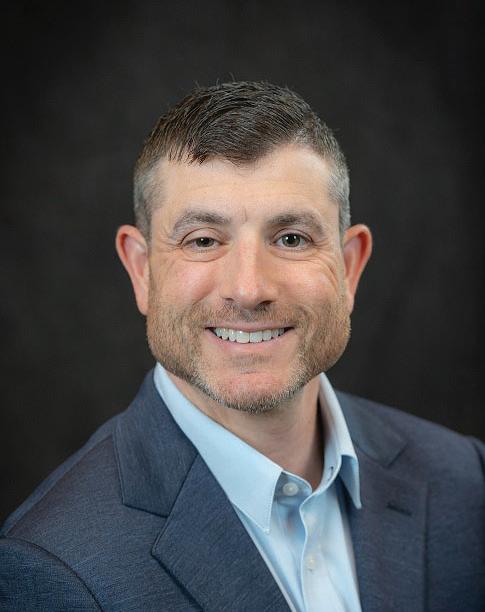 Conor Lee Senior Vice President Bellwether Enterprise Columbus, Ohio
Conor Lee Senior Vice President Bellwether Enterprise Columbus, Ohio

How has the Fed’s latest hike in its benchmark interest rate impacted demand for commercial financing?
Sam Miller: Obviously, the Fed is going to continue to raise its rate. The Fed made it clear that its target is to get the benchmark rate to 4.6%. This is happening in real time right now, so everyone is feeling it. The rising rates are definitely slowing things down.
The higher rates are making deals more challenging to close.
The saving grace for a lot of folks, especially in multifamily, is that rent growth has continued, too. That helps to absorb some of the shock from rising interest rates. The reality is that there is still a massive shortage of housing. There is a lot of demand for housing. And because of that, the demand for multifamily is growing, too, which means that owners can still grow their rents. That is helping to blunt some of the impact from in terest rates.
Conor Lee: From a real estate per spective, supply and demand is still in great shape. There is a ton of demand for housing in general. The number of units being developed is not fulfilling that demand. Are there potential lay offs and a recession ahead of us? If so, we might see bad debt creep into collections. We might start seeing occupancy issues. People who are looking for one-bedroom apartments might start looking for two-bedrooms so that they can bunk up with room mates to lower their monthly costs.
Right now, we are still seeing mul tifamily assets performing well. But what does your capital stack look like? If you have a refinance event, if you have a certain debt load you are at, can you get out of that debt? Can you return equity to your investors? That is challenging when rates are high.
Does it look like multifamily is resil ient enough to remain a good invest ment even during times of higher rates?
Miller: From a housing-market per spective, in some ways we are for tunate that it has been hard to build single-family housing for the last 10 years. When you look at the supply and what the vacant inventory was going into the great financial crisis of 2008 and 2009, it was so much more than it is today. There is not a huge glut of supply sitting there. Most people who own homes are possibly financed at 3.5% or lower. People don’t have to move now. If they don’t have to move, they won’t move. Why trade your 3.5% mortgage for a 6% mortgage? That further makes the case for multifamily. There are going
Midwest Real Estate News | September/October 2022 | www.rejournals.com28 FINANCE
FINANCE (continued from page 27) FINANCE (continued on page 30)
Sam MillerChad Kiner
“There is going to be a lot more thoughtfulness from investors on where they want to put their money. We are going to see a lot more discernment.”

St. Louis, MO 314.984.5514 Chicago, IL 312.845.8500 Indianapolis, IN 312.845.3093 Cleveland, OH 216.367.2101 Brentwood, TN 615.377.7676 Columbus, OH 614.468.5805 Germantown, TN 901.425.1828 Detroit, MI 248.208.3460 Kansas City, MO 816.759.0367 Milwaukee, WI 414.662.2459 BUILT FOR THE NOW. AND THE NEXT.® Our integrated platform, comprised of mortgage banking, investment sales, and JV equity expertise, enables us to deliver comprehensive solutions throughout the lifecycle of your investment. Built on trust, client service and collaboration, we’re here to build your future — together. Contact your local Berkadia office today and learn how we can deliver for you. BUILT FOR THE MIDWEST. © 2022 Berkadia Proprietary Holding LLC. Berkadia® is a trademark of Berkadia Proprietary Holding LLC. Commercial mortgage loan banking and servicing businesses are conducted exclusively by Berkadia Commercial Mortgage LLC and Berkadia Commercial Mortgage Inc. This advertisement is not intended to solicit commercial mortgage loan brokerage business in Nevada. Investment sales / real estate brokerage business is conducted exclusively by Berkadia Real Estate Advisors LLC and Berkadia Real Estate Advisors Inc. Tax credit syndication business is conducted exclusively by Berkadia Affordable Tax Credit Solutions. In California, Berkadia Commercial Mortgage LLC conducts business under CA Finance Lender & Broker Lic. #988-0701, Berkadia Commercial Mortgage Inc. under CA Real Estate Broker Lic. #01874116, and Berkadia Real Estate Advisors Inc. under CA Real Estate Broker Lic. #01931050. For state licensing details for the above entities, visit www.berkadia.com/legal/licensing INVESTMENT SALES | MORTGAGE BANKING | SERVICING BERKADIA.COM
to be more homes that don’t go on the market. That will increase demand for apartment units.
Are you seeing more multifamily supply coming on the market to help meet the high demand for it?

Lee: This is in flux right now. We are al ready seeing in Columbus developers pulling the plug on or pausing proj ects. That started because of the rising construction costs. Now with interest rates going up, that pause is going to continue. Couple construction costs with the cost of debt, that makes it more challenging to build anything. Construction lenders are starting to pull back. Underwriting metrics are more challenging. This environment is making it more difficult to get projects out of the ground.
I’ve asked others in the industry this, but even these rising rates are at historic low levels. Is there any acknowledgement of that in the commercial business?
Miller: We have been a little bit of doom-and-gloom here. At the end of the day, though, what is causing a lot of the pain right now is the uncertainty.

A 3.75% 10-year treasury is not the end of the world. But expectations need time to reset. If we start to level off and find a place where the Fed stops raising rates and lets things take their natural course, I think everyone will feel better. Everyone will have to adjust, but they will do that. It’s just been a big change in a short period. I’m hopeful we will
come out of it with a soft landing. It’s just difficult right now to know where the dominoes will fall.
Lee: Our strategy right now is to keep moving. We are trying to find ways to do deals. There is still a ton of capital out there. There are still a lot of debt providers in the market. As long as capital is still available, people will fig ure out how to do deals. If capital goes away, then we have a bigger problem.
We’ve talked a lot about multifamily. But how attractive of an investment is industrial real estate right now?
Lee: It is definitely slowing down. Things will slow. Velocity will slow. I don’t see how it doesn’t. But as long as capital is available, the market finds itself. We just need calmness. We can’t operate in this day-to-day volatile market. It’s hard to give guid ance when things change so quickly.
Hal Collett Chief Operating Officer, Agency Lending Colliers Mortgage Minneapolis

Building Our Roots in Wisconsin
Miller: Industrial has a lot going for it. There is a massive need for more in dustrial product. From a development standpoint, though, industrial is a lit tle trickier than multifamily. You might have one to three tenants in a typical industrial building. You are entering into long-term leases of five, seven or 10 years with these tenants. The chal lenge you’ve seen recently is with the increase in costs, both from construc tion costs that are rising and rising interest rates. You might agree to a 10year lease with FedEx. You might have agreed to that lease in July, but you’re not able to build until October or No vember. Suddenly, your costs are up 10% because interest rates have gone up. Everything changes so fast now. That million dollars of profit that you were counting on as a builder might now be gone.
But from a fundamentals standpoint, there is still room for rent growth in industrial. The mechanics of getting deals built is changing. Everybody is going through that, but we are seeing it more in industrial.
What are you seeing right now in terms of deal velocity?
The big question is an obvious one: What impact will the Fed’s latest in terest-rate hike have on the demand for commercial financing?
Hal Collett: The rate hike does make things more complicated. There are a lot of factors to consider. You have the rate environment and the Fed trying to catch up and curb inflation. The Fed was probably slow to react and is now trying to catch up, yet we are probably heading toward a reces sion now anyway. Then you have the general volatility in the economy. You have low cap rates and tremendous rent growth in the multifamily sector. The volatility with interest rates just adds more uncertainty to the com mercial real estate market. Add in the geo-political risks and an election year, and you might see people put their pencils down for a while as they adjust.
At the same time, construction costs are rising. Does this increase the chances of a slow down in investment and development activity?
Collett: I think so. The rising construc tion costs and the delays in getting materials are contributing factors in slowing down development activity. People are more cautious about what
Midwest Real Estate News | September/October 2022 | www.rejournals.com30
25 W. Main Street, 5th Floor Madison, WI 53703 www.mcshaneconstruction.com The Trotta Apartments Middleton, Wisconsin Alison Gorham, Director of Wisconsin Operations
As one of the largest multi-family contractors in the country, we’re proud to call Wisconsin home. FINANCE FINANCE (continued from page 28)
Conor
Lee
“From a real estate perspective, supply and demand is still in great shape. There is a ton of demand for housing in general.”
they are going to do. Now the rate environment is increasing the cost of capital. That just adds more hurdles to getting deals done.
We’ve had several volatile years in a row when you factor in the impact of COVID. How is this long-term stress ful period impacting the market?
Collett: That’s interesting. We have never been through a global pandem ic. How do you react to that? What impact does that have on the business decisions people make? When the pandemic started, we thought it would be catastrophic to the lending space. It turned out to be the opposite. We had a strong 2020 and an even stronger 2021. But I think we are starting to really feel the financial effects of the pandemic now, cost issues, supply issues, so much other uncertainty that you can put into the same bucket. We have seen those things occur before, but we have never seen them occur after you’ve been through a global pandemic. I think that we are just starting to feel the financial impacts of the pandemic now.
The worst healthcare impacts of the pandemic are hopefully behind us. But the economic impact is just starting to be felt.
Even with this all this uncertainty, is commercial real estate still a solid investment when compared to other investment vehicles?
Collett: We spend a lot of time in the multifamily space. Multifamily has remained a solid investment. It’s getting more difficult for people to afford to buy a house. Multifamily, then, becomes more attractive. There is a bit of a recession-proof aspect to multifamily. Owners can raise or lower rents and remain competitive. It’s not completely recession-proof, but generally speaking, multifamily is a wise bet. In some ways, you have a natural arbitrage against what is going on in the economy. Multifamily, self-storage and industrial are all good investment options today. They are more resilient than office and retail right now. Throughout recessions or down cycles, people find opportuni ties to execute business, just not at the same volumes as they might have in the past.
Are you surprised that multifamily has remained such a strong invest ment during these tumultuous times?
Collett: I’m not really surprised. We have had an unprecedented run here. It’s been going on more than 14 years. There is a massive problem in this country when it comes to the lack of affordable housing. People need a place to live. The single-family-hous ing markets have been on an unprec edented run of price appreciation. That is playing a large factor in the strength of the multifamily market.
A lot of folks are renting longer than they would have before. Houses are not affordable. They have several other loans they must pay off. The rental market will hit some bumps. But demand for multifamily housing will remain strong.
Is there still more demand for multi family housing than there is supply in most markets across the country?
Collett: The demand in a lot of mar kets is not diminished in any way, shape or form. There is still a gap between demand and supply.
What type of financing requests are you mostly seeing today?
Collett: A couple of years ago, there was an opportunity to refinance a bunch of deals because we were in an all-time-low interest-rate environ ment. There are still some refinance opportunities for people, but most of our financing requests today are for acquisitions. More buyers are out there buying deals. A lot of buyers are flooding to multifamily and real es tate in general. I’d say the mix today is closer to 60/40 of acquisition deals to refinance deals. Two to three years ago, it was 70/30 the other way.
Are investors looking to buy in Mid west markets today?
Collett: The Midwest markets are our sweet spot today. We play better in the secondary or tertiary markets. Those markets tend to be more resil ient, in my opinion. We find opportu nities in those markets to be fruitful. The bigger markets are covered effec tively by larger players, institutional players. We find better opportunities in the secondary and tertiary mar kets. Those markets are continuing to grow. We have seen tremendous growth, for instance, in Nashville.
When you consider financing re quests, what factors do you look at?
Collett: We look at transactions in three ways. First, we look at the strength of the borrower. That is pretty consistent across the indus try. Do they have experience in the market? Do they have the financial wherewithal and liquidity?
We also look at the market. We want to understand what is going on in the market or in the submarket in some cases.
The last piece is the unique piece that each lender looks at differently. Where do we have exposure? Where do we want more exposure? Is this a new client that we want to do more business with? This is about where we want to grow. We want more ex posure from a footprint perspective in some markets. Other lenders might want less exposure in those markets. It’s more about lenders making their own decisions about their own book.
Back to interest rates, do people un derstand that today’s rates, though higher, are still at historically low levels?
Collett: I feel like that is driven more by the number of years people have
been in the industry. The anomaly with rates is the last 10 years. Being at 2% or 3% is the uncommon factor. If you have been through cycles be fore, you realize this. If you have been in the market for four or five years, you know nothing different than this low interest-rate environment. This feels different to them. They don’t understand the anomaly.
John Manos Regional President BankFinancial Willowbrook, Illinois
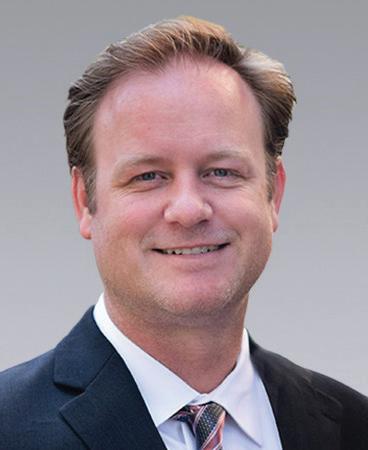
Do you think a slowdown is coming in commercial financing requests now that the Fed has raised interest rates again?
John Manos: I do. The Fed has been warning us about the moves they were going to take. They told us they were going to go from one rate hike to another. Most of us, and the investors, anticipated that. The first two quarters of this year, then, were incredibly busy. What surprised me was the amount of purchase trans actions we saw. We anticipated that anyone and everyone who could re finance would take advantage of that opportunity to hurry up and refinance before rate hikes would take effect. Because of that anticipation, the first two quarters of this year were very busy, and that activity trickled into the third quarter. But over the last three or four weeks, we have definite ly seen a slowdown.
The last time the Fed raised its rate this aggressively was in November of 1994. I think investors were an ticipating that and wanted to get all their deals completed as soon as they
www.rejournals.com | September/October 2022 | Midwest Real Estate News 31
FINANCE
Hal Collett
“The rising construction costs and the delays in getting materials are contributing factors in slowing down development activity.”
FINANCE (continued on page 32)
could, which explains why we were so busy at the beginning of this year.
Has the fact that the Fed didn’t raise rates gradually but instead in two large jumps created any uncer tainty in the commercial real estate landscape?
Manos: The Fed, by making their increases that steep and that fre quent, have made a statement that they are going to fight the threat of inflation aggressively. I think people have gotten that message, and it has altered their investment plans. Being in the Midwest, what has sur prised us is the amount of money coming in from the coasts, primarily from California. A good number of investors are purchasing properties here in the Midwest, primarily in the Chicago area. They’ve found higher cap rates and better returns than what they were seeing in their home markets.
Why is commercial real estate in the Midwest so attractive to inves tors?
Manos: The cap rate opportunity is the big reason. The Midwest is a place where investors can still find 7.5%, 8% and 8.5% cap rate oppor tunities in multifamily. In their home markets, they might be finding 3.5% and 4% cap rate returns. That is not very lucrative for them. They have nowhere else to invest their money that is as safe as in Midwest real estate. The stock market seems to have peaked, too. I would say that investing in commercial real estate, and especially in multifamily, is the safer bet today.
Speaking of multifamily, what has made this commercial sector such a strong investment for so long?
Manos: Rising interest rates mean that less people can afford to buy homes. More people, then, will be renting for a longer time. Inflation will slow rent increases in multifam ily. But the demand for apartments is still strong, so occupancies will remain high and vacancy rates will stay low. Higher interest rates could lead to higher vacancies in retail and office. Multifamily, then, looks like the better of the commercial property types.
From what we have been reading, there is not enough housing and not enough apartment units to meet demand, especially for low-income housing. We try to focus on that. We try to work with investors that invest in and grow in low-income census tracts.
When the pandemic started, we all worried that apartment dwellers would stop paying their monthly rents. For the most part, that didn’t happen. Are you surprised by that?
Manos: People made paying their rent a priority during the pandemic. We jumped on that early, too. We asked our borrowers if they needed support or if they had the need for any additional financing that we could help them with. A small per centage took advantage of that. We supplied lines of credit, gave them the ability to get through those
challenging times. They all paid us back ahead of time and ahead of schedule. We thought it was import ant to come up with a program, to be proactive with our borrowers as opposed to them getting in trouble. We jumped ahead of the curve on that. Our borrowers appreciated it. I like to think it carried through to the tenants and gave them an opportu nity to get back on their feet or gave them an extra month or two to find another job.
What type of commercial financing requests are you seeing today?
Manos: We lean toward multifamily, which we specialize in. But we are seeing business across the board. Multifamily is our primary source of business. We also get into retail. When we look at retail financing requests, we are careful about who the tenants are and what the lease structures are. Service-related re tail businesses are more appealing today than are other businesses that might be more hit by supply chain slowdowns. We are focusing more on borrower experience and liquidity. We are also looking at and considering more multi-tenant properties rather than stand-alone, single-use commercial facilities.
The industrial market has been hot for a long time, too. Are you seeing many financing requests for indus trial acquisitions?
Manos: We do. We still try to focus on working with requests for multi-
tenant properties. That way, you don’t have the Amazon effect. If Amazon is 80% of the income in a property and then leaves, it doesn’t bode well for an owner. It’s the same with grocery-anchored shopping centers. If the grocery store is 70% to 80% of a center’s income, if the grocery store leaves, you have a large, dark, empty box. That will hurt, no matter if you have other smaller tenants.
I know it’s difficult to predict the future, but what do you think will happen now that the Fed has com mitted to raising its benchmark rate?
Manos: I think as the Feds have done historically, they are doing what they need to do to control the economic cycle we are in. They will continue to move aggressively. Then I feel that things will flatten out. I think they’ll pull back in the early first quarter of next year and let things play out. I believe that the investors who could refinance have already refinanced. I anticipate purchases on any and all commer cial real estate to slow and give the market a chance to catch up. We are already starting to see properties stay on the market 30 days and 50 days. We will see more of this. And certainly, the overheating of the market the last couple of years made it a sellers’ market. Interest rate hikes will slowly convert it to a buyers’ market again probably by the third or fourth quarter of next year.
We will work through it, though. I don’t think we’ll keep seeing multi family rents grow, but I do believe multifamily occupancies will remain high. Retail is still adjusting and finding its way to get occupancies back up again. They have done tremendous work. The office sector might lag a bit. From what we’ve heard, businesses are trying to get their people back into the office. How does that work out? We are still waiting to see. Industrial has been on fire with all of the trucking and supply chain routes happening. That is starting to settle down a bit. We’ll see where that lands in the first and second quarter of next year. These are certainly interesting times.

Midwest Real Estate News | September/October 2022 | www.rejournals.com32
FINANCE FINANCE (continued from page 31)
“We will work through it, though. I don’t think we’ll keep seeing multifamily rents grow, but I do believe multifamily occupancies will remain high.”
John Manos
No huge drop-off coming: Multifamily market expected to remain hot into 2023
By Dan Rafter, Editor
Renters and investors are still seeking out multifamily space. And the demand for apartment living is showing no signs of slowing, accord ing to Kia Crooms, area vice president of the Midwestern region for King of Prussia, Pennsylvania-based Morgan Properties.
We spoke with Crooms about the enduring strength of the multifamily market and why Morgan Properties is eager to expand its apartment hold ings in the Midwest. Here is what she had to say.
Why has demand remained so strong for multifamily properties for so long? What are the factors fueling the long hot streak of this asset class?
Kia Crooms: The economy has certain ly helped. There has been excellent job growth in the United States. Wages for individuals continue to rise. People have access to cash. At the same time, the supply chain issues persist. That makes it difficult to build as many new homes as people want. Renting, then, is a great option for people today.
Housing prices are high, too. That is inspiring more people to rent. We are seeing an excellent retention ratio when it comes to lease renewals. Folks are even selling their homes, taking out the cash and downsizing to apart ments and townhomes. They want the lifestyle and the lack of maintenance that comes with renting instead of owning.
What about rising interest rates? What impact is that having on the number of people who want to rent instead of buy?
Crooms: When interest rates are high er, people are more likely to rent. But our investors are still excited about multifamily properties, too. Our in vestors continue to be excited about different markets, especially when it comes to the Midwest. There are many markets in the Midwest that are always strong.
Morgan Properties has made several recent multifamily acquisitions. We entered the Indianapolis market with a property of more than 2,100 units. We have also recently entered the Chicago suburbs with purchases in Elgin, Palatine and Schaumburg. We continue to find ways to build our portfolio.
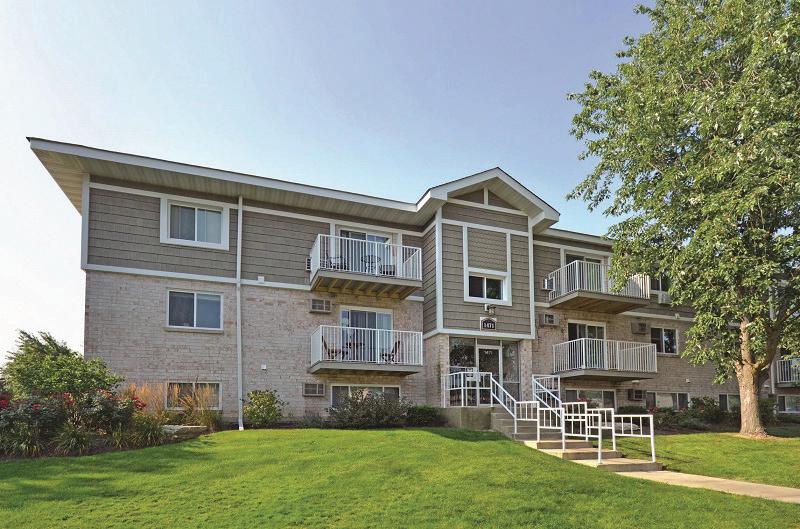
Why make the move to Indianapolis? What attracted you to this market?
Crooms: As an organization, we are oversaturated with properties in the East Coast and Sunbelt regions. In dianapolis was an untapped market for us. We like the growth potential in the Indianapolis area. There are some good meat-and-potatoes prop erties there when it comes to Class-B assets. There is a Class-B market there that is untapped and in our wheelhouse. We do that section of the market well. We like to buy those properties and add value to them.
What are renters looking for today from multifamily properties?
Crooms: Coming out of a pandem ic, people are now looking to be outside. They are looking for more space. They are looking for every thing from outdoor kitchens and grilling spaces to fire pits that they can use in the evenings. They want to really live and gather with family
www.rejournals.com | September/October 2022 | Midwest Real Estate News 33
MULTIFAMILY (continued on page 34)
Morgan Properties’ The Gates of Deer Grove in Palatine, Illinois.
“There has been excellent job growth in the United States. Wages for individuals continue to rise. People have access to cash. ”
MULTIFAMILY
and friends. That’s why we like the Class-B garden-style apartment communities. There are so many value-add opportunities. We can add a lot to the outdoor spaces in these communities.
The way people are living today, things like dog parks have become more essential to folks. They want that off-leash exercise for their furry friends. They want open kitchens outside or splash parks in tandem with swimming pools. Anything that involves spending time with family and friends is important today.
There is no one-size-fits-all list of amenities, though. What works in Michigan might not work in New Jersey.
Speaking of the pandemic, it seems like the multifamily sector held up really well even during the worst days of COVID and that the sector has emerged even stronger today.
Crooms: There were some industries that were hit hard by the pandemic, such as hospitality and retail. We did see some softness when it came to rent collection, but our team mem bers were good at being that expert when it came to helping people source those funds. The government and other agencies offered financial assistance that we could connect people to. There were no off days for our staff during the pandemic. We were there to be of service to the residents.
Today, many renters are staying in place and renewing their leases. Many are doing this because they are nervous about making the move to buying a single-family home with how the interest rates are rising. They might not have the money for a down payment. This all makes multi family a strong option for people.

Do you plan on acquiring more prop erties in the Midwest?
Crooms: We do. We are always look ing for growth opportunities. Even if we wanted to rest, our investors and employees won’t allow it. It is so lucrative out there now in the multi family space. We are interested in those value-add opportunities where we can find more meat on the bone
by upgrading apartments and town homes and the amenities in those spaces. That is in our wheelhouse. That is where we win and where we are always looking to expand and grow.
Do you upgrade these Class-B properties enough to turn them into Class-A space?
Crooms: Sometimes that does hap pen. It depends on the spend and the demographic we are trying to serve. It’s about what the market dictates for a property. We want to make the changes that people want to see, bring in what has been missing from a development. That’s the recipe. We’ve
done it over and over, but every prop erty is different. The same amenities don’t work everywhere. We do our due diligence when it comes to the market. We study what people want to see.
The multifamily market has been strong for so long. Do you see de mand for apartments, from both renters and investors, continuing to hold steady or rise throughout the rest of this year and into next?
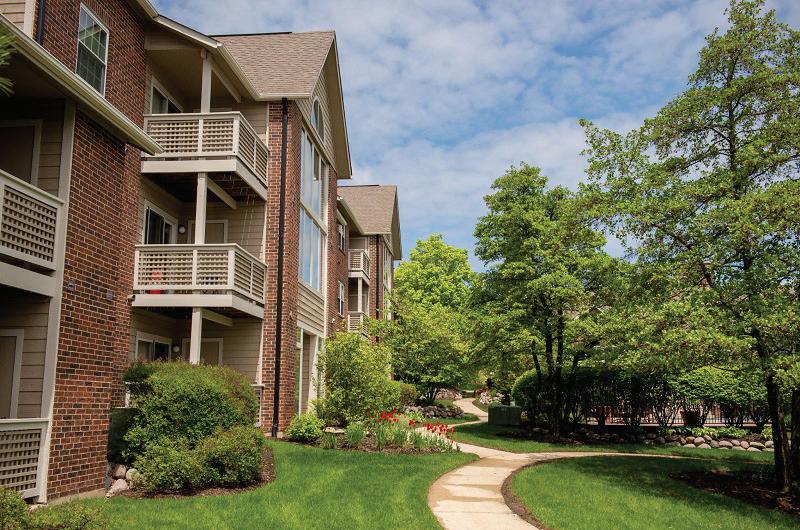
Crooms: We will continue to see strong numbers. Some markets might soften a bit, but I don’t see any huge drop-off happening. The supply chain issues have not been fixed yet when
it comes to building new single-family homes. We still don’t have enough housing to get everyone’s heads into beds. Adult children who moved back with their parents will be leav ing again to find their own places to live. People are branching out and getting their own apartments and townhomes. One household is now becoming two. Do I see occupancy in the multifamily sector softening a bit? Sure. But I don’t see a huge drop-off. Our occupancy numbers and demand for apartments will both remain high.
Midwest Real Estate News | September/October 2022 | www.rejournals.com34
MULTIFAMILY MULTIFAMILY (continued from page 33)
The Lakes of Schaumburg Apartment Homes, Morgan Properties’ apartment community in Schaumburg, Illinois.
Kia Crooms
“We will continue to see strong numbers. Some markets might soften a bit, but I don’t see any huge drop-off happening. ”
Maintaining SkylinesFor Over 10 0 Years
International in 1938. As “ e Best Hands in the related damage, and deterioration to your masonry façade from store fronts to skyscrapers, historical landmarks to new construction.
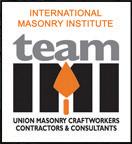


All members are medically evaluated and t tested and go thru 10 to 30 hours of OSHA training. Recognized by the City of Chicago for Sca old Training, members are also trained in Fall Protection and Silicosis Awareness. e Apprenticeship requires a minimum of 3 years training and is registered with the United States Dept of Labor.
POINTER, CLEANER & CAULKER
Anyone Interested in Quality Workmanship
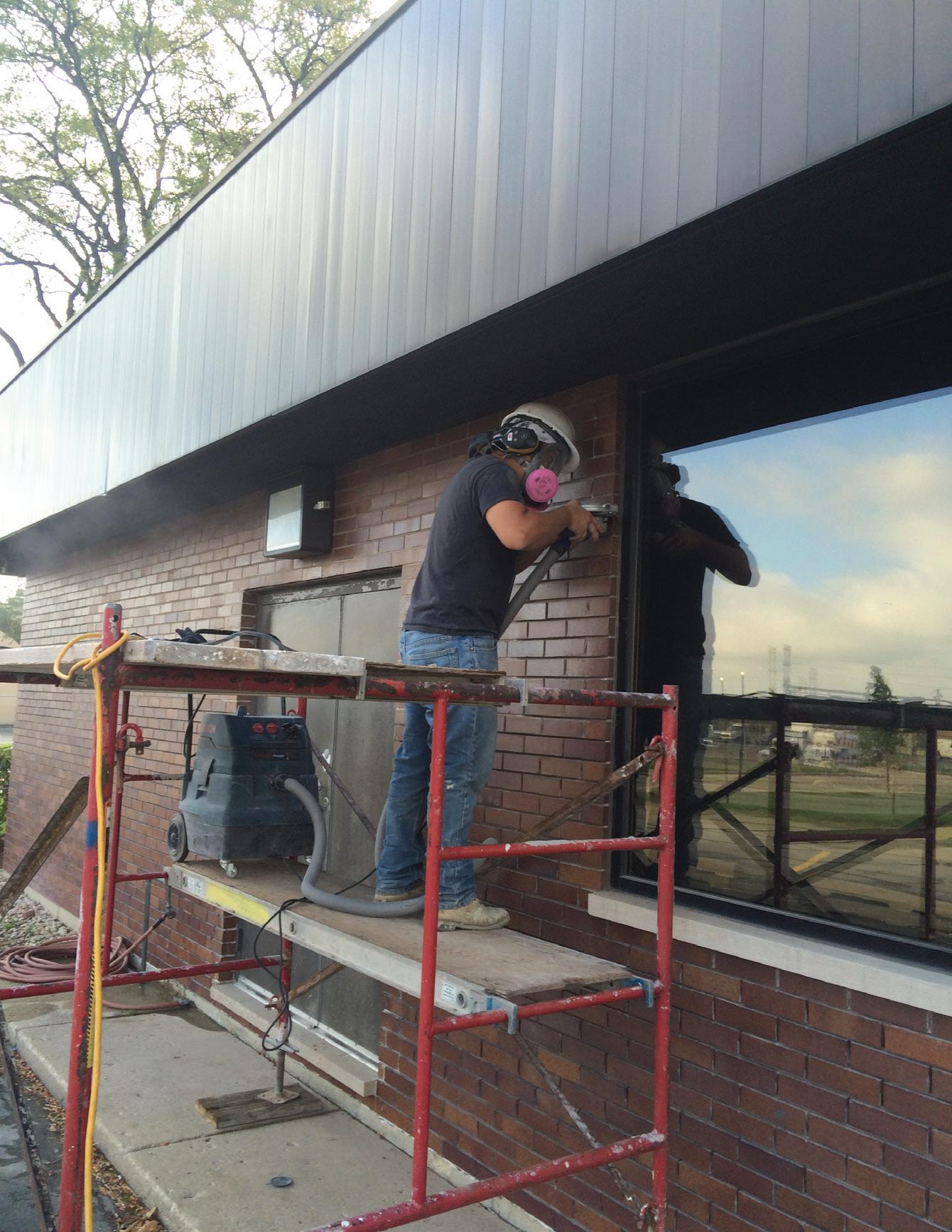
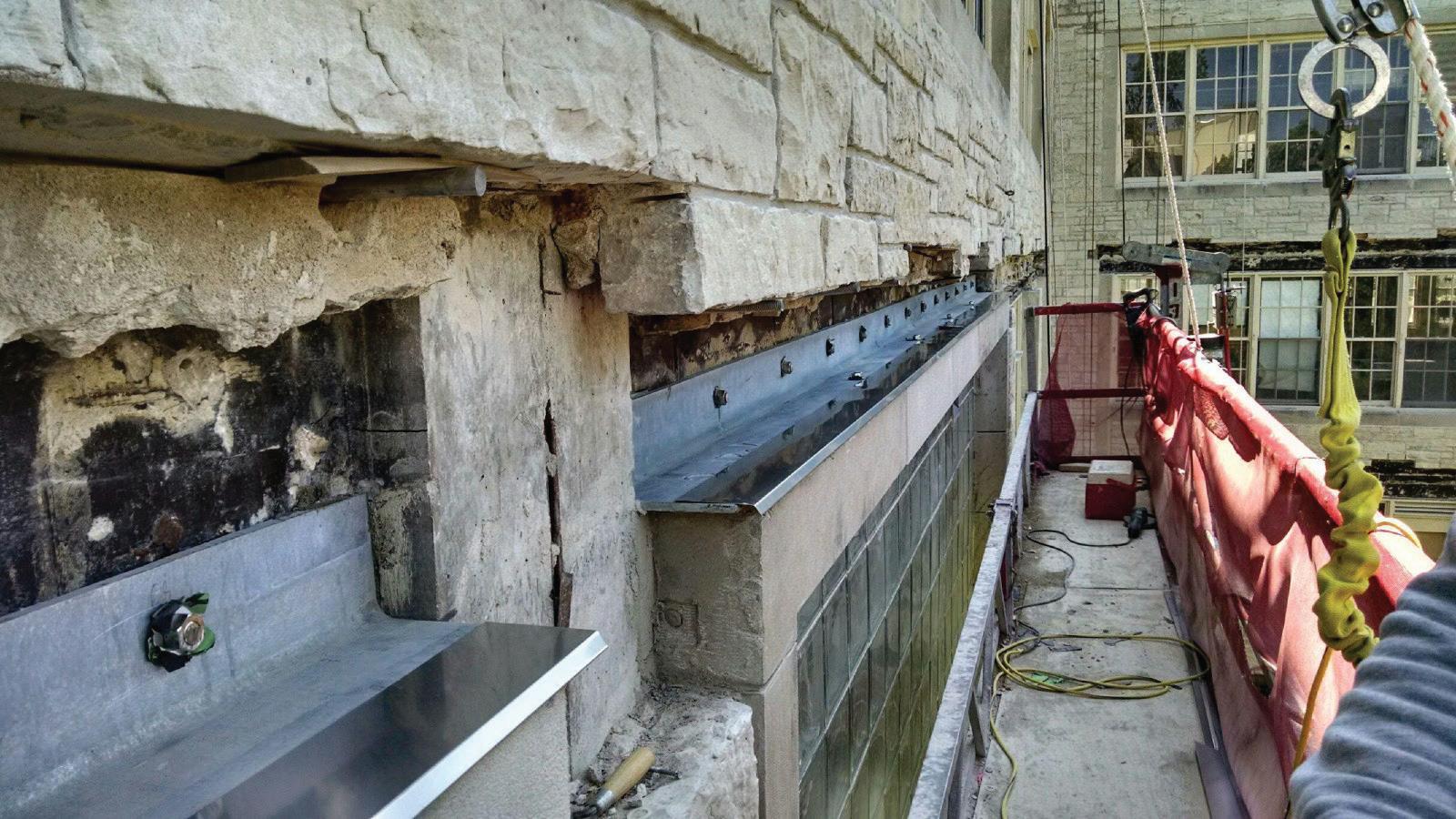


can contact:












Administrative District Council #1 Call (630) 941-2300 for a list of Signitory Contractors Websites: tuckpointers.weebly.com www.bacadc1.org
Ad paid for by Tuckpointers Promotional Fund
THE PROFESSIONALS IN MASONRY RESTORATION
Supply chain issues. A labor shortage. An increasingly competitive market: Can modular construction provide the relief developers seek?
By Dan Rafter, Editor
Developers face plenty of challenges today: It’s dif ficult to find experienced labor. Material costs keep rising. And supply chain disruptions mean that it can be diffi cult to get everything from insulation to concrete and steel to construction sites on time.
That’s why it’s not surprising to many commercial real estate professionals that developers are slowly, but steadi ly, turning to modular construction when building restaurants, hotels, apartment projects and healthcare facilities.

Modular construction in the commer cial development industry works much the same as it does with residential projects: Anywhere from 60% to 90% of a building -- whether it be an apart ment development, fast-food restau rant, hotel or school building -- is built offsite in a factory or manufacturing facility.
These pieces, known as modules, are then shipped to the building site where they are put together to form a completed project.
The benefit here is that modular build ings can be developed in less time. They also require less experienced construction crews. That helps devel opers who are struggling with supply chain disruptions and a lack of skilled labor.
Modular construction, then, has the potential to play a far bigger role in the commercial construction industry than it has in the past.
This is one reason why REjournals focused heavily on modular construc tion during its Midwest Construction Double-Header event held Sept. 8 at the Hyatt Regency O’Hare Chicago in Rosemont, Illinois. The second half of this event focused on the ways in which modular construction can change the development industry.
A growing demand for modular?
Dean Dovolis, principal, chief execu tive officer and founder of DJR Archi tecture in Minneapolis, said that the reasons for the increased demand
for modular construction are many and complicated.
First, there are the societal reasons. As Dovolis says, many workers who are 55 and older have walked away
from the workforce and retired. This has happened in the construction industry, too.
Midwest Real Estate News | September/October 2022 | www.rejournals.com36
CONSTRUCTION
An example of a current modular project taking place in the Midwest is the Pentagon Village Apartments, a six-story, 202-unit apartment project planned for the Twin Cities suburb of Edina, Minnesota.
CONSTRUCTION (continued on page 38)
“ We have to do more with less people. There is not a throng of young people ready to fill the ranks. It’s now about creating higher productivity per person.”
Think Beyond the Build.
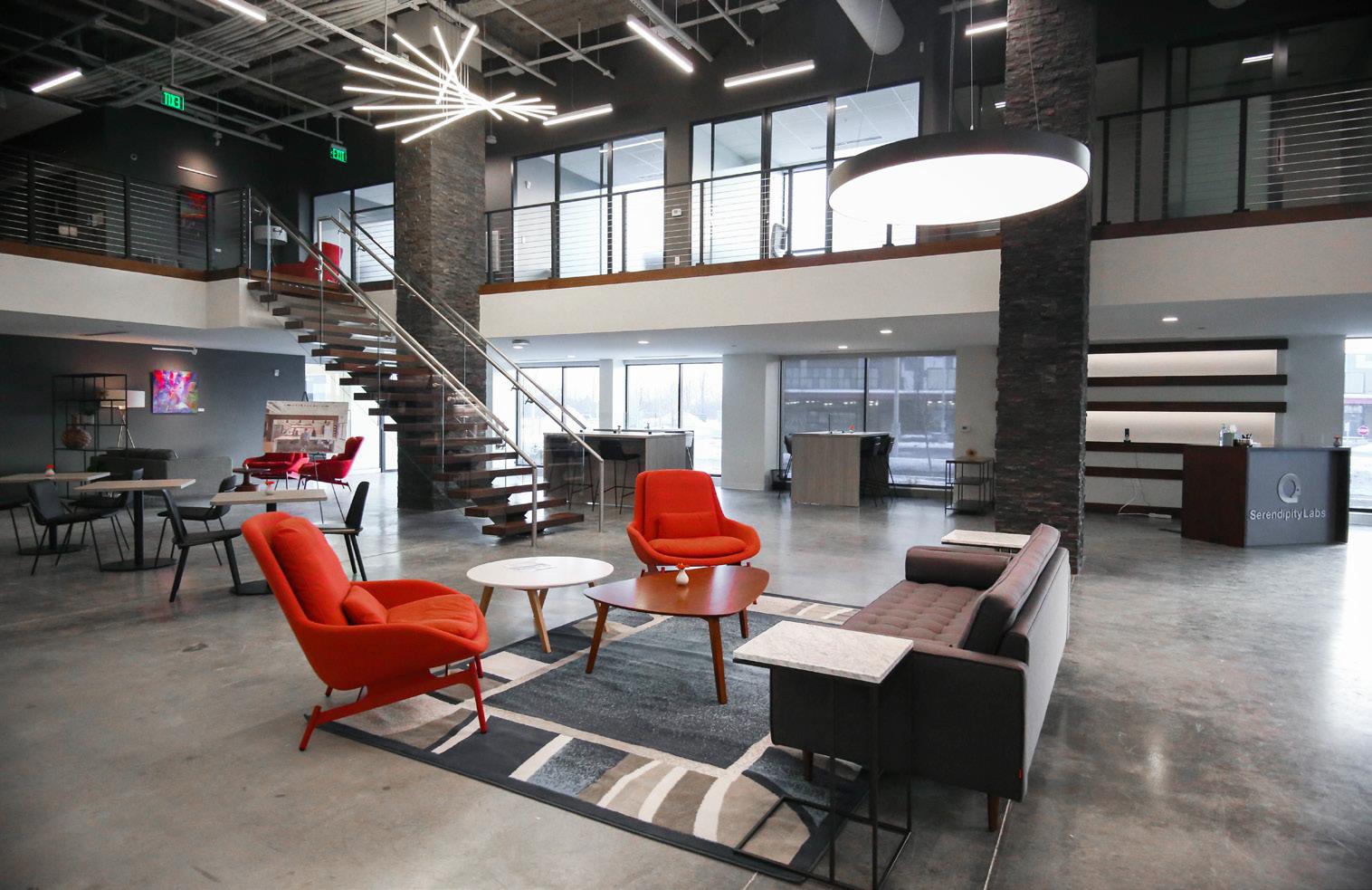
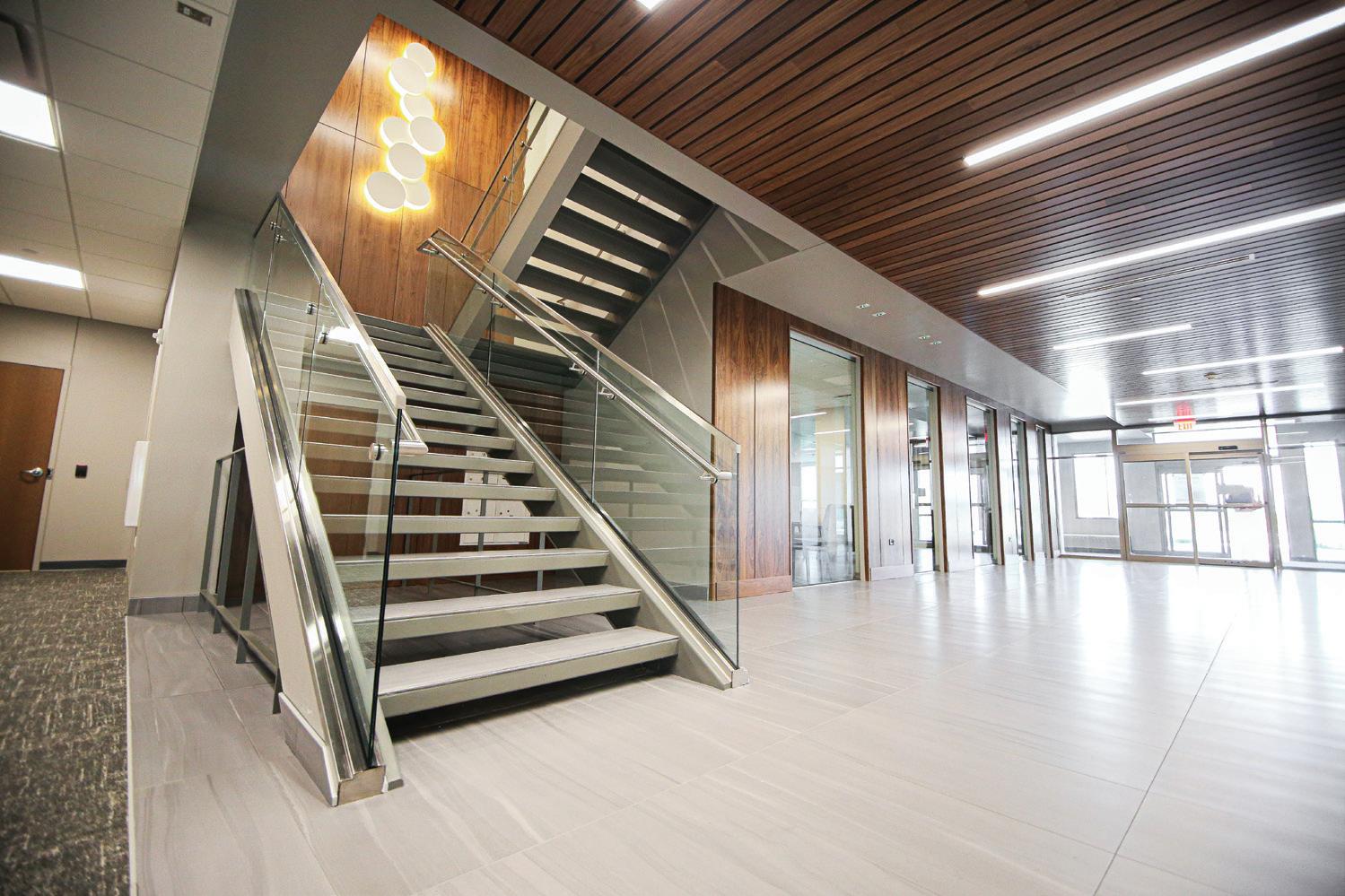

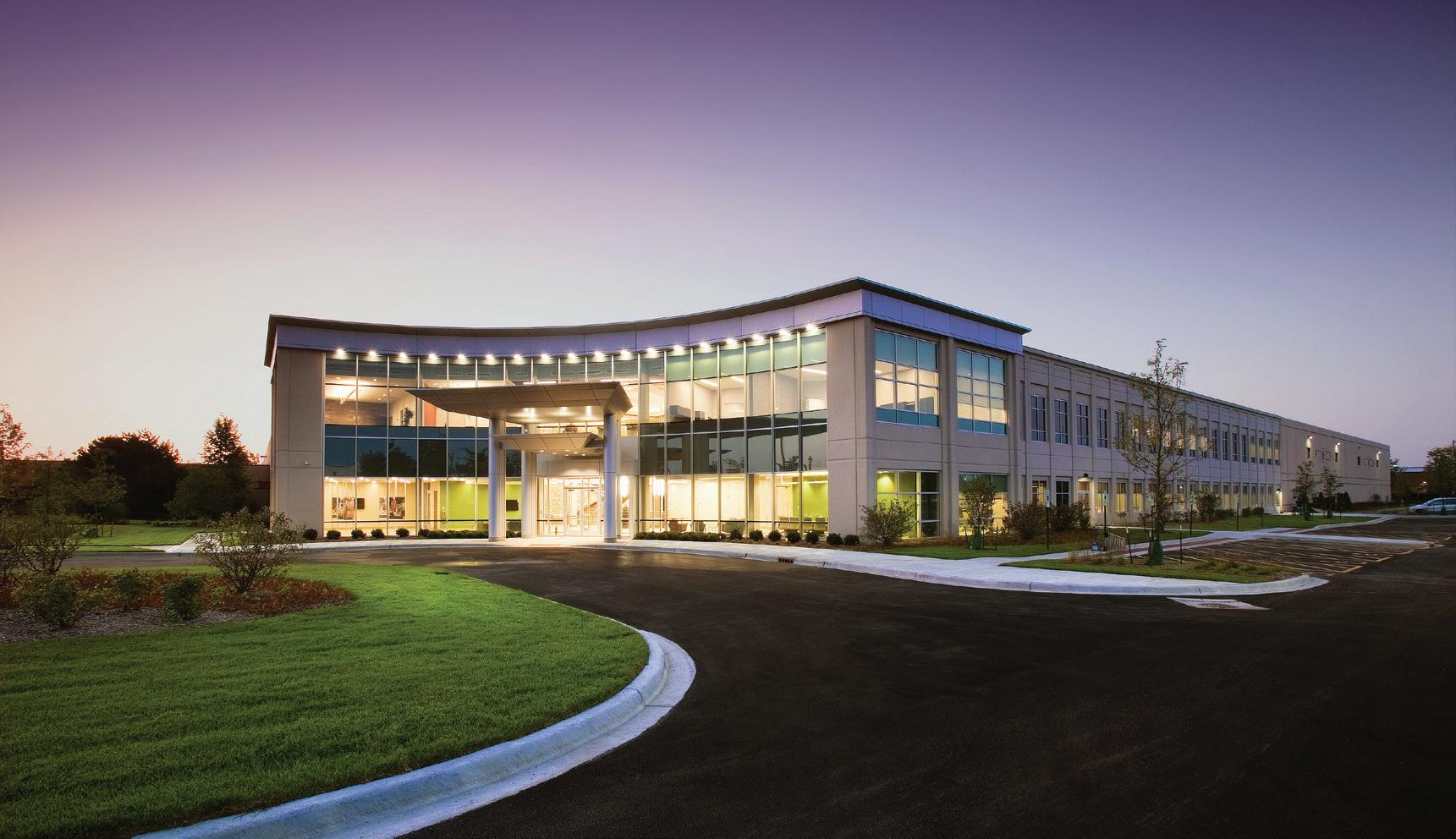
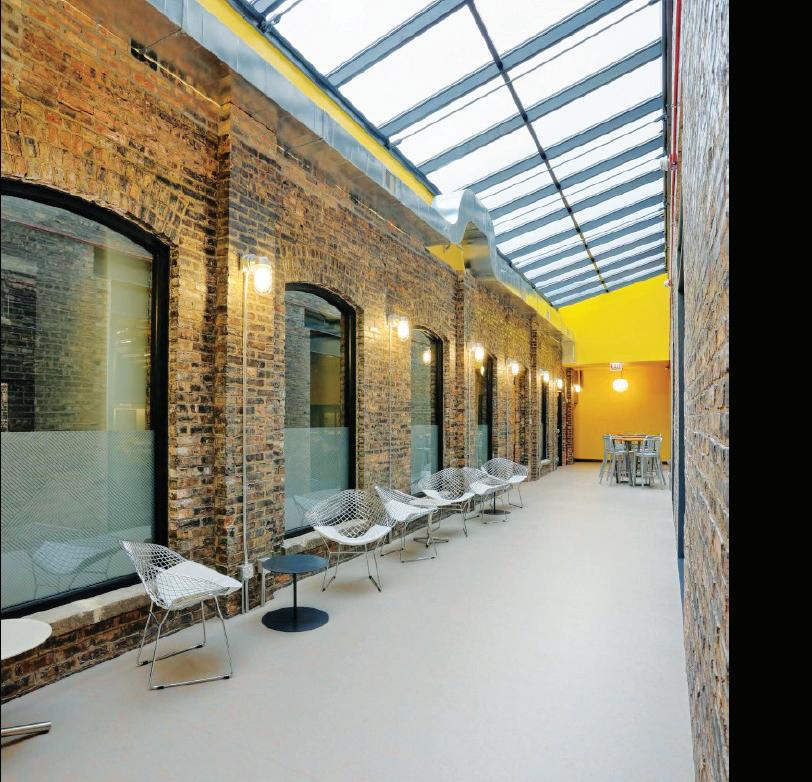
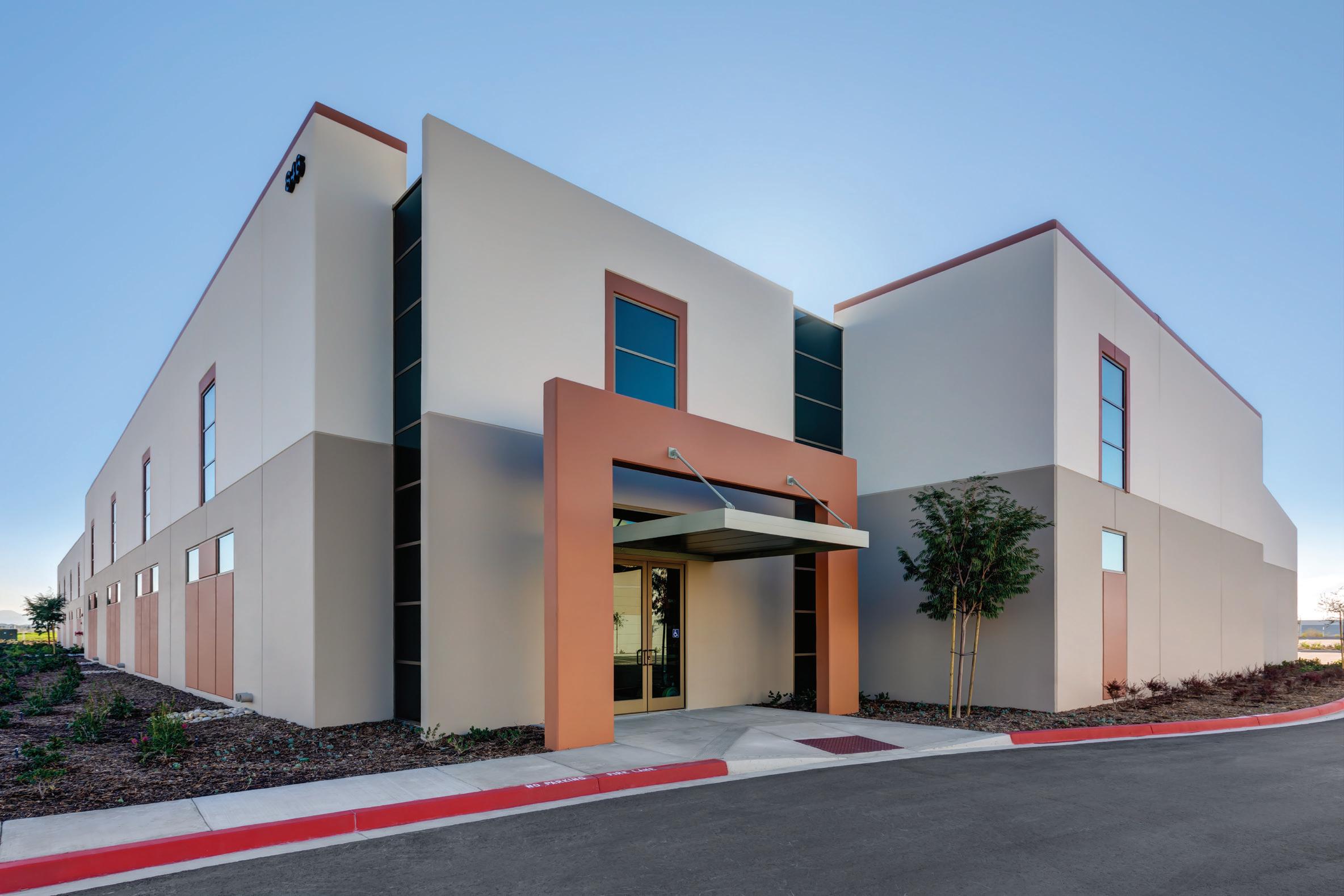
pdbgroup.com
That has left a shortage of expe rienced labor in the construction industry, making it more difficult for construction companies to find the people they need to complete proj ects efficiently. Many of these com panies are looking for a new way of building, and modular construction offers them a choice, Dovolis said.
“There is pressure to change our methods of construction,” Dovolis said. “We can’t build them like we used to. So much of the experienced workforce is gone now, your plumb ers, carpenters, electricians, people in all areas of the construction indus try. We have to change the method of construction we use, otherwise the pace of construction becomes slow and inefficient.”
New workers aren’t filling the void left by the departing experienced construction workers, Dovolis said.
This means that the labor shortage we are seeing today is far from a temporary one.
“There are no replacement workers coming,” Dovolis said. “This is a permanent fact in the labor market.”
It takes less people to build mul tifamily buildings, schools, hotels and fast-food restaurants when developers rely at least in part on modular construction. Workers with less experience can get the job done.

“These societal issues aren’t going away,” Dovolis said. “They are going to keep intensifying. There are less people performing the work. We have to do more with less people. There is not a throng of young people ready to fill the ranks. It’s now about cre ating higher productivity per person. Modular construction is one method that allows that to happen.”
Jeffrey Schoeneck, principal and ex ecutive director in the Minneapolis
office of design firm Cuningham, agreed that the number of experi enced construction professionals leaving the industry makes it more important for developers to seek alternative means of construction, including modular.
“We are losing people in the trades to retirement on a pretty steady basis,” Schoeneck said. “That has led to several challenges for all parties involved. It’s a weaker link in the overall construction process to have more junior staff and less expe rienced senior veterans in the field. That creates hiccups in the entire construction process.”
But it’s more than just veteran pro fessionals leaving the business. Finding any labor, even construction professionals with fewer years of experience, is a challenge today, Schoeneck said. And again, that makes modular construction a viable alternative for construction firms looking to do more with less.
At the same time, the technology behind modular construction is im proving, Schoeneck said. That gives developers more confidence that they can turn to modular construc tion and receive quality products.
“The growth in modular construction is being fueled by tech dollars, not by construction dollars,” Schoeneck said. “There has been an influx of in vestment in construction techniques outside of what would typically be considered the real estate industry.”
Speed matters
Speed is a major factor in the growth of modular construction, too, Schoe neck said. By relying on modular technology, developers can bring their projects to the market faster.
That is a key benefit in the compet itive world of commercial construc tion, Schoeneck said.
“This industry has never been as
Midwest Real Estate News | September/October 2022 | www.rejournals.com38
CONSTRUCTION CONSTRUCTION (continued from page 36)
competitive as it is now,” Schoeneck said. “Every day that you are waiting for a building to be built, you are not earning that rent or making that sale. Speed to market is so important today. Clients and end users want faster delivery. Owners and investors want their return on investment to come faster.”

Dovolis said that modular construc tion doesn’t typically bring big cost savings up front. But the reduction in construction time adds up to big savings, he said.
“Time is money,” Dovolis said. “That has become a critical factor with inter est rate issues and the cost of money today. Speed to market is so import ant. You can cut construction time in half with modular construction. That is a big deal when interest rates are double what they once were. If you can reduce your carrying costs and cut them in half, that makes a project go from infeasible to feasible.”
Modular construction works particu larly well for multifamily housing, with many developers already relying on
his approach to build new apartment buildings.
The United States needs more multi family housing to meet demand. And the shortage isn’t a small one: The National Multifamily Housing Council has said that the country needs more than 4 million new apartment units to meet the current demand for them.
Modular construction, in which apart ment buildings can be built more quickly, can help developers provide more multifamily housing in less time.
“I don’t see modular construction as an optional thing. I see it as inevita ble,” Schoeneck said. “It might not be tomorrow that this industry truly con verts to modular. But it is an inevitable
necessity. We continue to have a huge demand for multifamily housing in the world. That demand won’t get met through a construction industry that is losing senior, experienced profes sionals. Modular will become a staple as we need to build more housing to meet the ever-growing demand.”

Fighting a bad reputation
Dovolis said that the modular con struction industry is still saddled with a bad reputation. Much of this is because people often think of trailer parks when they picture modular con struction.
“When you think of manufactured homes, do you get a good feeling?” Dovolis asks. “Probably not. That’s something that we have to overcome.”
This means educating the public about how modular construction technology has changed. Modular projects today, or developments that rely on some modular construction,
Jerry Sullivan Principal

www.rejournals.com | September/October 2022 | Midwest Real Estate News 39
MULTIFAMILY
“At DarwinPW Realty, we look at building long term relationships and we achieve this by putting our clients’ interests above all others.
For over 45 years, DarwinPW Realty/ CORFAC International has been a leader in industrial and commercial real estate. The company specializes in brokerage, property management, investment and development services primarily in the Midwest. DarwinPW Realty’s highly qualified professionals are problem solvers and utilize a breadth of tools and knowledge to serve our clients best.
Broker 630.782.9520 | darwinpw.com CONSTRUCTION (continued on page 40)
don’t look boxy or cheap. They look little different, in fact, from any other form of commercial construction.

Dovolis said that developers and the public will accept modular construc tion over time. They’ll do this after seeing a steady stream of successful, and aesthetically pleasing, modular projects pop up across the country, Dovolis said.
“Buildings are being built this way,” he said. “They are successfully being built. People can touch and feel them. Seeing these examples will make a difference.”
Developers can turn to modular construction for a wide variety of building types. It’s a natural fit for multifamily, of course, but this con struction technique works well for hotels, office buildings, educational facilities, healthcare properties and restaurants.
In fact, modular construction can work for just about any type of commercial project.
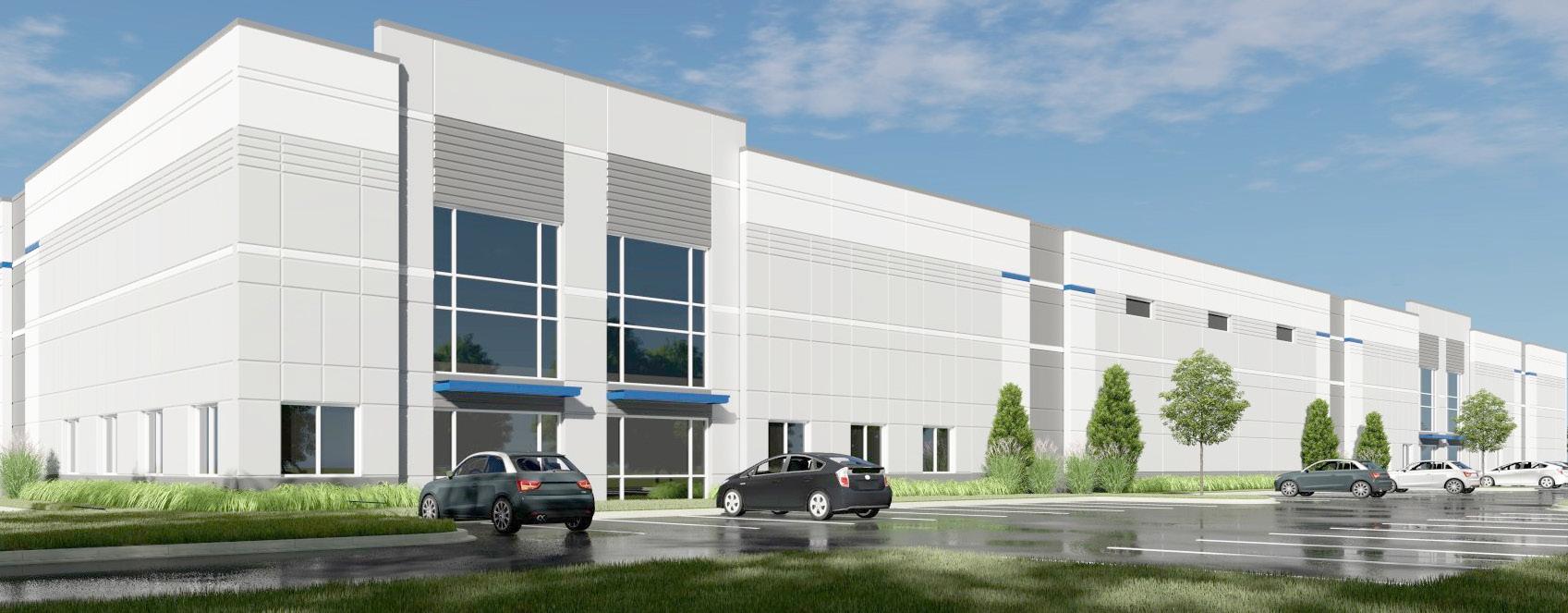
“The easiest low-hanging fruit is hous ing,” Dovolis said. “But major hotel chains do modular, too. Marriott is building modular now. You are begin ning to see modular with educational facilities. Franchises are starting to
use modular construction, starting to experiment with this technology.”
An example of a current modular project taking place in the Midwest is the Pentagon Village Apartments, a six-story, 202-unit apartment project planned for the Twin Cities suburb of Edina, Minnesota. Rise Modular, based in Minneapolis, is
the co-developer, general contrac tor and module manufacturer on the project. Partners are Solomon Real Estate Group and Cuningham Group.
The apartments will be part of the master-planned Pentagon Village de velopment. The apartment building will be constructed with five stories of RISE-manufactured modules over a one-story concrete podium. Units will be a mix of studio, alcove, oneand two-bedroom units. A 142-stall parking garage will be attached to the development.
“Are more developers embracing modular construction? That might be too strong,” Schoeneck said. “It does have everyone’s attention today, though. Modular is very evi dent in the conversation. Developers might not be ready to move forward yet, but they do want to learn about it. I have had very few conversations with developers in which they don’t have one eye on this technology coming down the pipe.”
Midwest Real Estate News | September/October 2022 | www.rejournals.com40
CONSTRUCTION Seefried Properties has selected Principle as the General Contractor, to construct a new 80,053 SF spec distribution facility in Mount Prospect. The rear-load industrial building will sit on 5.4 acres and will feature a 32’ clear height, 16 exterior dock doors, ample car parking, 17 trailer stalls and prominent exposure on I-90. Ground has been broken and first lease has been signed by World Courier Inc. 9450 West Bryn Mawr Avenue, Suite #120 • Rosemont, IL 60018 (847) 615-1515 fax (847) 615-1598 Multi-Tenant Distribution Facility 80,053 SF Delivering a new facility in the heart of the O’Hare industrial submarket. PCC2022 MWREN Sept Ad (f).indd 1 9/22/22 1:53 PM CONSTRUCTION (continued from page 39) “Time is money. That has become a critical factor with interest rate issues and the cost of money today.”
ALVERA: Much More Than a Building
By Todd A. Phillips, Minnesota Real Estate Journal
I
t starts with its name: Alvera. Stuart Ackerberg’s mother, Alvera Franceschi, passed away in August of 2020 at the age of 90. “Few people know this, but she was the glue that the Ackerberg’s development history was built upon.” Award-winning history, that is. “It became more than a name. It gave the project meaning. It allowed all the people who worked on the project to add their own chapter to the story.” It’s a heart-warming tale that personifies the project from start to finish, but also effectively launched the building on its own path going into the future.
The building’s story starts with a small 0.6-acre site on West 7th across from the Children’s Hospital in St. Paul, Minnesota. It was not an obvious site for apartments. Brian Farrell, Principal of Northland Real Estate Group had been working with the Bonfe Automotive family exploring the next chapter for the property. The site was comprised of multiple small parcels with an alleyway that was home to several electrical transformers. “It wasn’t an obvious site,” recalls Farrell. Of course, there are always hurdles, but the
proximity to Children’s and their need for attainable housing led Brian to be lieve he could solve the challenges and transform the property. “We enjoy challenges. The bigger the challenge, the more we can achieve. Especially on sites that have failed previous redevelopment attempts, like this one.”
Farrell brought in fellow Madison graduate Stuart Ackerberg of the Ackerberg Group to co-develop the property. The two learned to re-envision real estate from
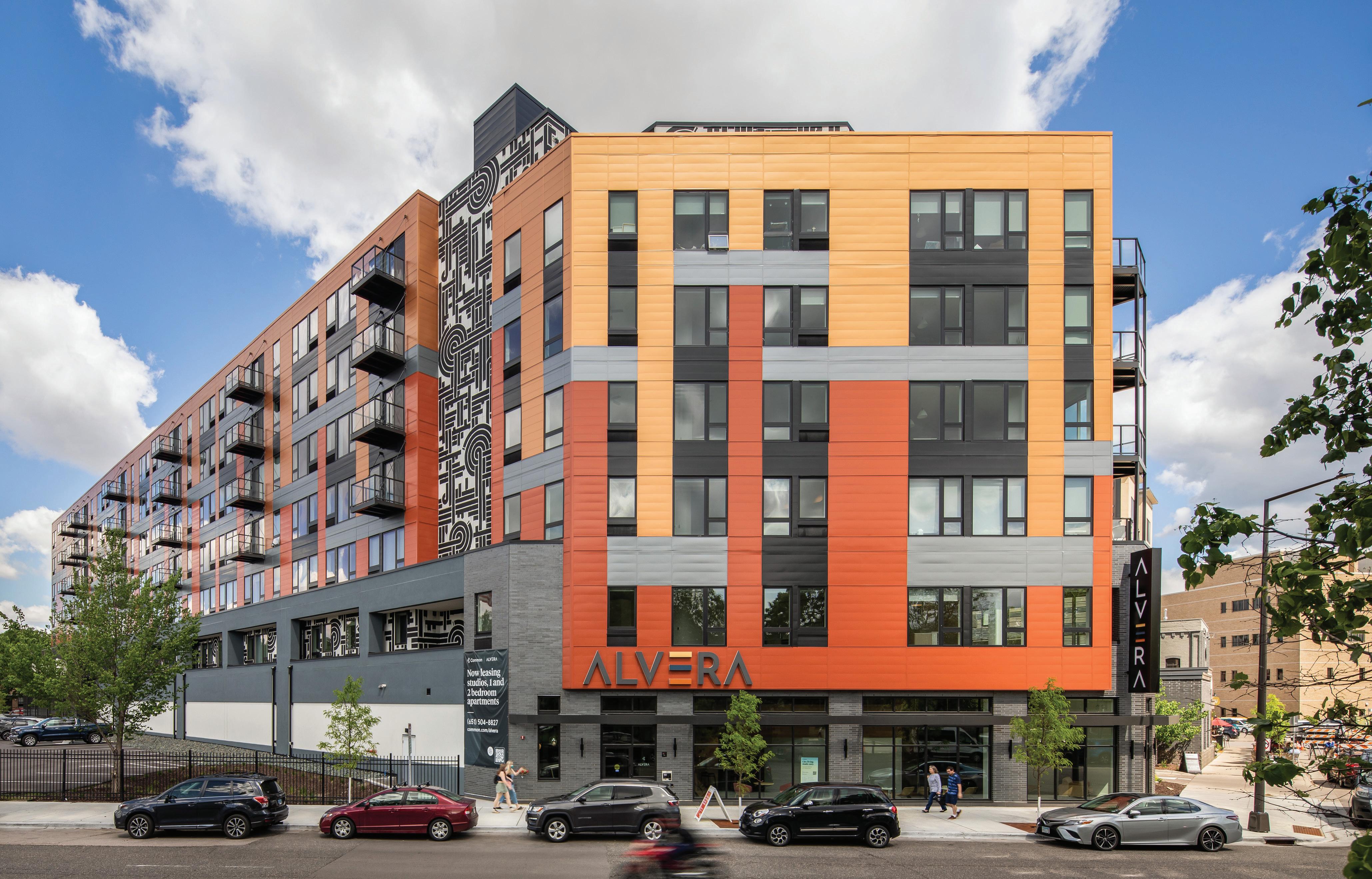
Professor Graaskamp, for whom the University of Wisconsin-Madison’s Real Estate School is now named. The design here needed to be efficient, affordable, and have adequate parking, conceived in a way to attract the workforce from nearby Children’s, the Science Museum, and staff from nearby hotels. All of which seems simple enough, but in an urban setting, projects of this nature rarely pencil-out. “We had to find a way to bring the proforma from in the red to in the black,” recalls Farrell, referring to the old ways accountants would use red ink to show losses versus profits. The turning point came from embracing bold new construction techniques in two ways: (1) implementing an automated, stacked parking structure and (2) by using volumetric modular construction for Floors 3 through 7. Neither had been attempted at this scale in the Upper Midwest. The team would need the glue only Alvera Franceschi and her memory could provide.


The Leap of Faith

Enter Dean Dovolis, chief of everything at DJR Architecture. Dean’s genius-like na ture and childlike enthusiasm makes you feel like anything is possible. Dovolis cut his chops in modular construction during the Bakken oil boom from roughly 2008 to 2014. “In the Bakken, we had to find a way to house thousands of people quickly and efficiently and modular construction was a natural fit,” according to Dovolis. But what worked for the Bakken “Man-Camps” wasn’t the kind of construction that would be needed to create multi-story buildings like what you now see on West 7th. Luckily for this team, another soon-to-be major player was hard at work build a manufacturing plant in Owatonna Minnesota that would evolve modular construction into the future.
Enter Rise Modular, LLC, a full-volumetric commercial manufacturing company founded by Christian Lawrence, CEO. Lawrence recognized the opportunity of modular early on. “I wanted to be a developer and incorporate modular construc tion in multi-story developments, which are prevalent on the East and West coasts. However, full-volumetric commercial modular production didn’t exist in the Mid west, so I decided to pivot and become a modular manufacturer instead. In 2019, I launched Rise and built its manufacturing facility in Owatonna, Minnesota. The company has since grown to nearly 200 employees.”

As a graduate of Yale Univer

Environmental Investigation & Remediation Industrial Hygiene Building and Structural Sciences Geotechnical Engineering & Testing www.braunintertec.com
Proud to be your trusted consulting partner on multifamily projects for:
be
garden-style
blown away
they see a
level of finishes.”
with private equity experience, Lawrence certainly has the drive and vision to figure it out.

“Christian did it right,” according to Dovolis. “He scoured the nation for the best talent in modular construction and convinced them to come to Minnesota and join Rise. In a state-of-the-art manufacturing facility, designed and engineered by industry experts, the company has established a best-in-class manufacturing process.” It takes but a single tour of the facility to appreciate that modular is
the future of construction. It is a tradesman’s ideal work environment; state-ofthe-art machinery, no exposure to outside elements, and all ground-level work. In this environment precision is unparalleled, quality is second to none and con sistency easily maintained.
“The reduction in project duration results in real savings,” all team members concurred. “The foundation of the building starts at the same time module man ufacturing began. When the foundation was complete Rise stacked the modules
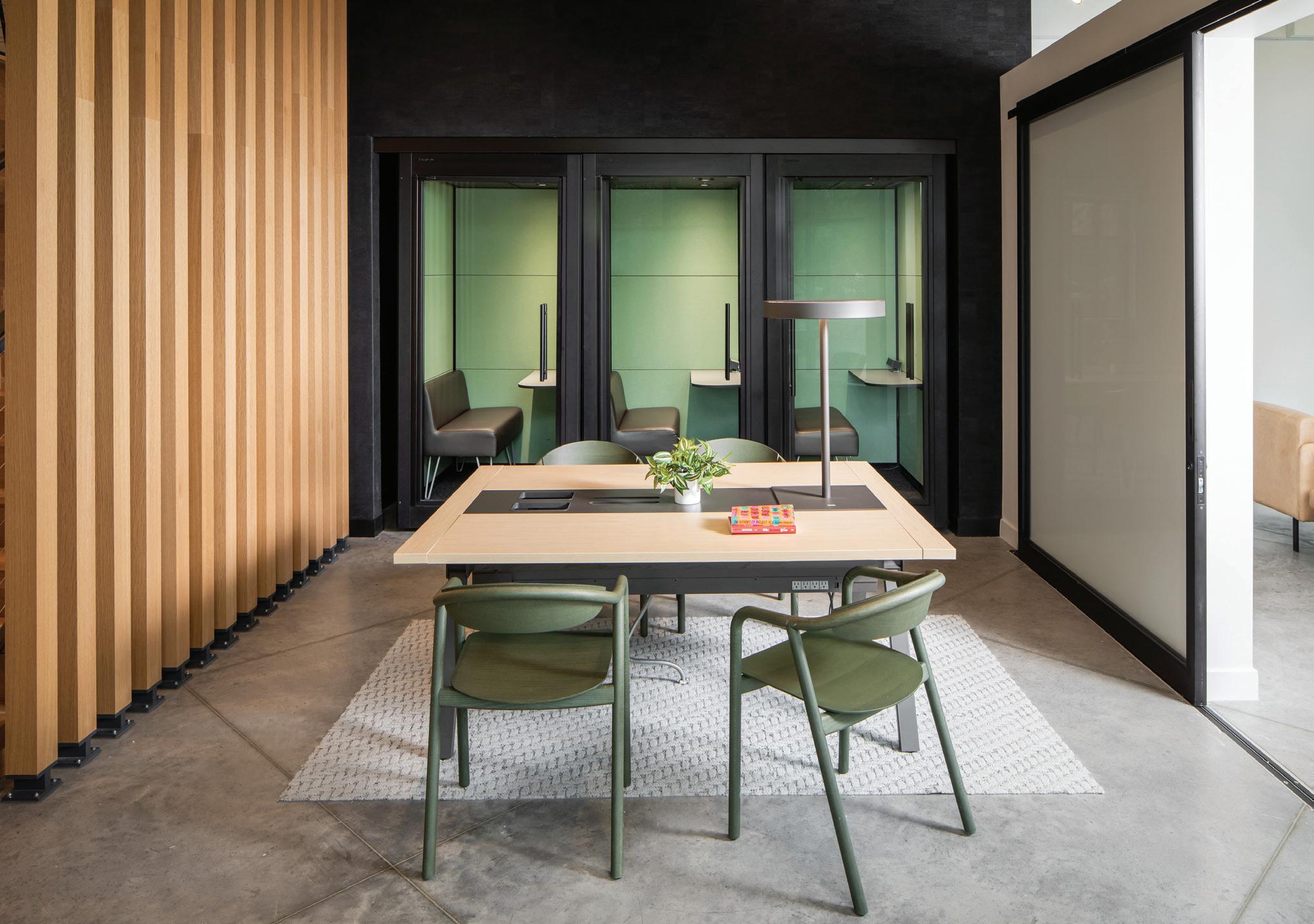
HARDING STEEL 800-727-5325 HARDINGSTEEL.COM CARBON 12 PORTLAND, OR “It might
easy to imag ine a
apartment being modular, but people are
when
seven-story structure with this
sity
on-site and floors three through seven were completed in a short six weeks” adds Dovolis.
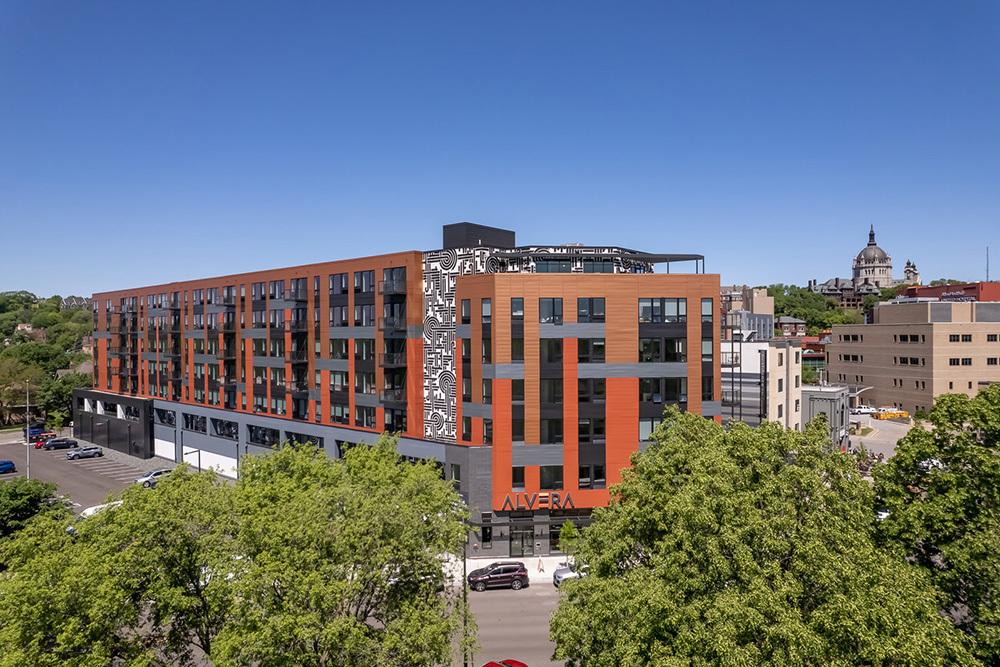

The modular units are incredibly well built,” according to Farrell. “Think about it, Rise builds the apartment units in a factory in Owatonna, ships them on a truck to St. Paul, and crane lifts them into place seven stories in the air. To accomplish this, each unit has its own ceiling and floor, which when stacked together, provide twice the density. It is very structurally sound and solid.”
“It gives us tremendous joy when people see the Alvera in person; most cannot believe it’s a modular project,” says Lawrence. “It might be easy to imagine a garden-style apartment being modular, but people are blown away when they see a seven-story structure with this level of finishes and no hint of its modular nature.”
The Parking Problem
The next problem was the bedrock under the site. “We weren’t going to be able to go underground for parking,” recalls Farrell, “and we were already height restricted, constraining the number units going up.” Farrell thought back to his days in New York City seeing car elevators being used commonly to increase parking density. “We just haven’t seen any in Minnesota at this scale,” he added. The team was about to undertake another first.
Opus and All City Elevator. Opus built the first two stories, which would house the parking and serve as the foundation for setting the modular apart ments. But it was All City Elevator President Matt Gamble and his team who were tasked to install the mechanical parking structure. “It’s really quite amaz ing,” recalls Gamble. “We were able to provide 102 parking stalls using six sep arate mechanical structures in very little space. You would need three levels of traditional parking to replace what we were able to effectively accomplish
Enter
in two stories.” Congratulations to Opus on the successful completion of the Alvera Apartments Project. Midwest Specialty Maintenance appreciates being part of your team! PROVIDING EXCEPTIONAL CONTRACT CLEANING SERVICES SINCE 2005PROVIDING EXCEPTIONAL CONTRACT CLEANING SERVICES SINCE 2005 9225 East River Road Coon Rapids, MN 55433 763-493-2555 www.midwestspecialtymaintenance.com

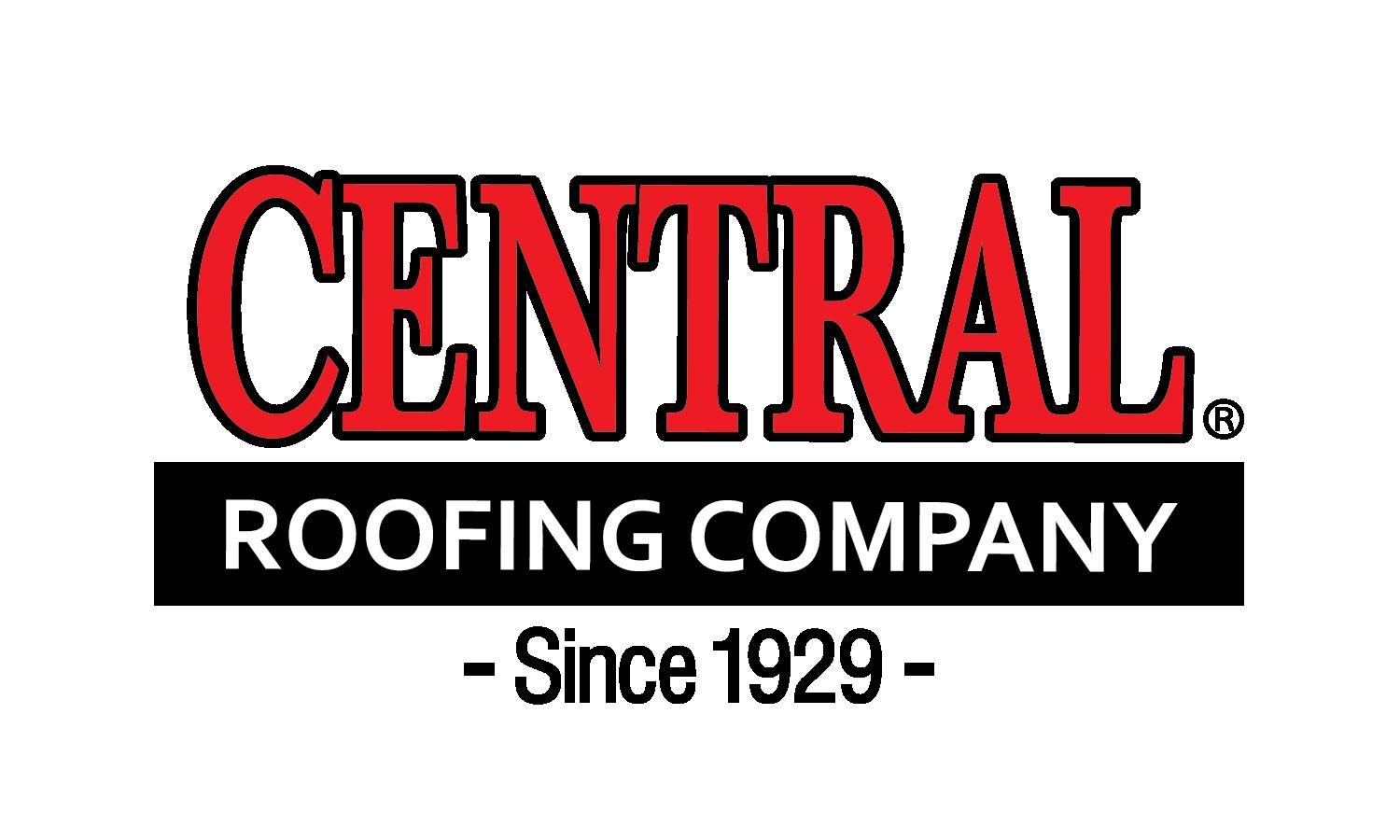


The Alvera | St. Paul, MN ROOFING CONTRACTOR: CENTRAL ROOFING COMPANY
See more. Our projects always have a view.


Enhance your community with instant-on connectivity Fast, reliable Internet from the provider of the largest Gig-speed network is just the beginning. Get your residents connected within minutes of move in — no waiting for equipment or tech appointments. Our customized solutions are tailored to your property’s needs to give you and your residents the best experience possible. All with dedicated support and 24/7 customer service. Get your property WiFi ready today xfinity.com/connectivity Restrictions apply. Not available in all areas. Actual speeds vary and not guaranteed. For factors affecting speed visit www.xfinity.com/networkmanagement. NPA231510-0006 144015_NPA231510-0006 XFCommunities WiFiReady ad 4.875x7.indd 1 9/8/22 5:13 PM World-Class Electrical and Technology LOCALLY DELIVERED SINCE 1948 • Preconstruction • Electrical Design & Construction • Service & Maintenance • Outdoor Electrical • Technology Systems Proud Provider of Electrical & Technology Services for Alvera Apartments 651.224.2833 | collinsmn.com
The parking structure allowed the team to deliver 30 more apartments over what would have otherwise been possible, yielding a total of 193 units for the project. “And it’s secure,” adds Gamble, noting that security in urban neighbor hoods like this one, especially during civil unrest, is a big concern. The other benefit is timing. One would think that as a tenant, waiting for a mechanical parking structure would take longer than a traditional parking structure. “This system retrieves your car in around 45 seconds,” according to Gamble. The All City team waned to compare this to a traditional parking garage, so they headed across town with a stopwatch. They found, on average, that it took 90 seconds to drive around and up and down in a traditional structure versus 45 in the automated system they installed at Alvera.
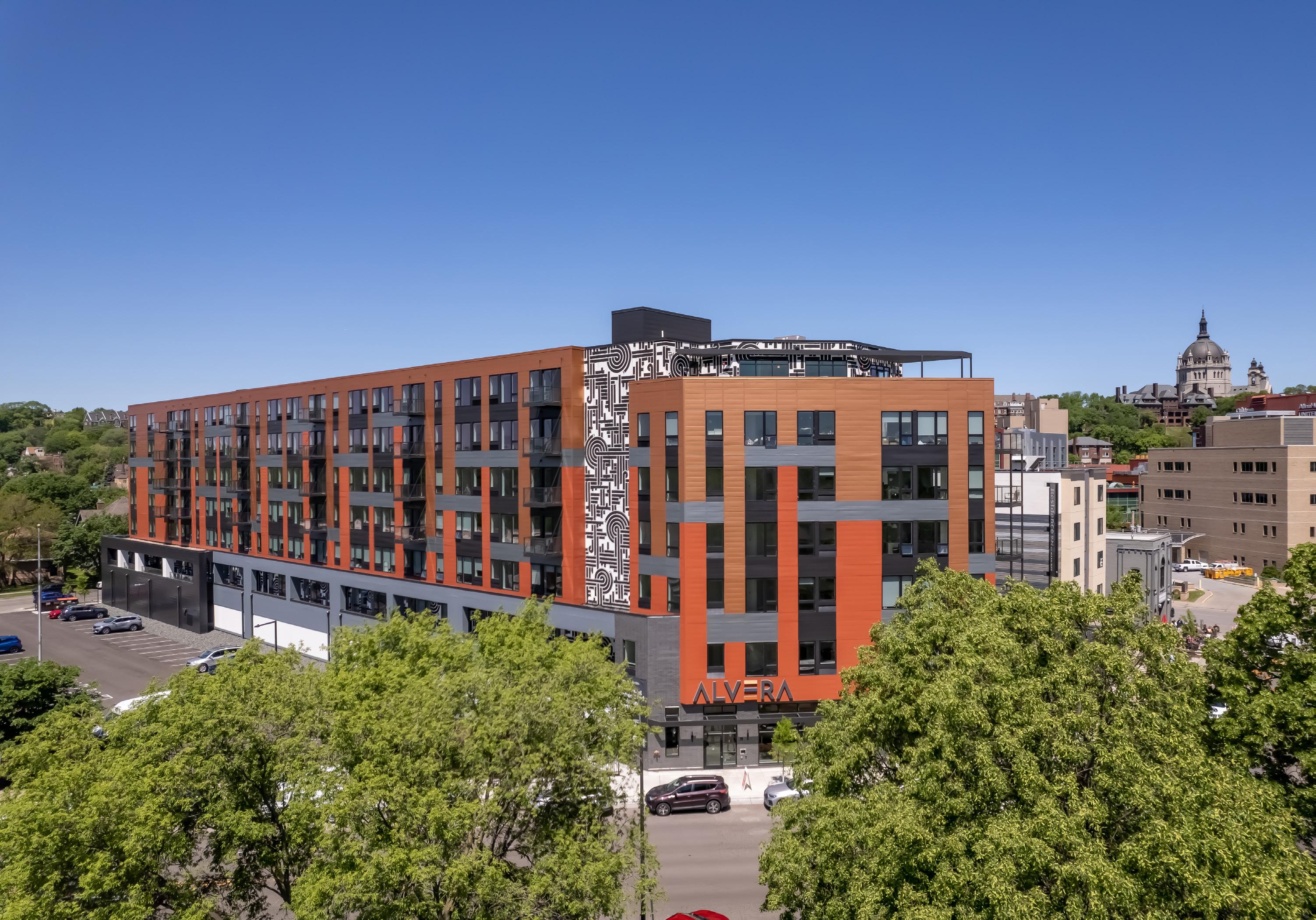
Making it Real
The final piece to the puzzle belonged to Stuart Ackerberg. “We have a re sponsibility to leave this world better than we found it. We have a duty to make our buildings someplace special. And this site in particular we are working to activate the West 7th Corridor as a center for artistic expression.” It was with this mission that Ackerberg turned to Forecast Public Art in St. Paul to bring the building to life. Forecast Public Art, in turn, brought in world-renowned artist Aaron De La Cruz. De La Cruz and Ackerberg hit it off immediately. In fact, the two still talk weekly, even after the project was completed.
It was De La Cruz and Ackerberg who turned to the memory of Alvera Fran ceschi for inspiration. “Aaron became obsessed with the story of my mother,” recalls Ackerberg. “He wanted to know more about her, her love for art, her favorite color, and her warming personality. It set him on a mission. In fact, it set all of us on a mission. We used that energy and that purpose to shape and mold the project into what people now admire from their windows of Chil dren’s Hospital. Even the tradespeople working day to day on the project felt inspired to leave their own chapter in the Alvera story.”
47DEVELOPMENT SHOWCASE
PROUD TO BE A PARTNER IN INNOVATION AT ALVERA
opus-group.com
“We have a responsibility to leave this world better than we found it. We have a duty to make our buildings special. And with this site in particular we are working to activate the West 7th Corridor as a center for artistic expression.”

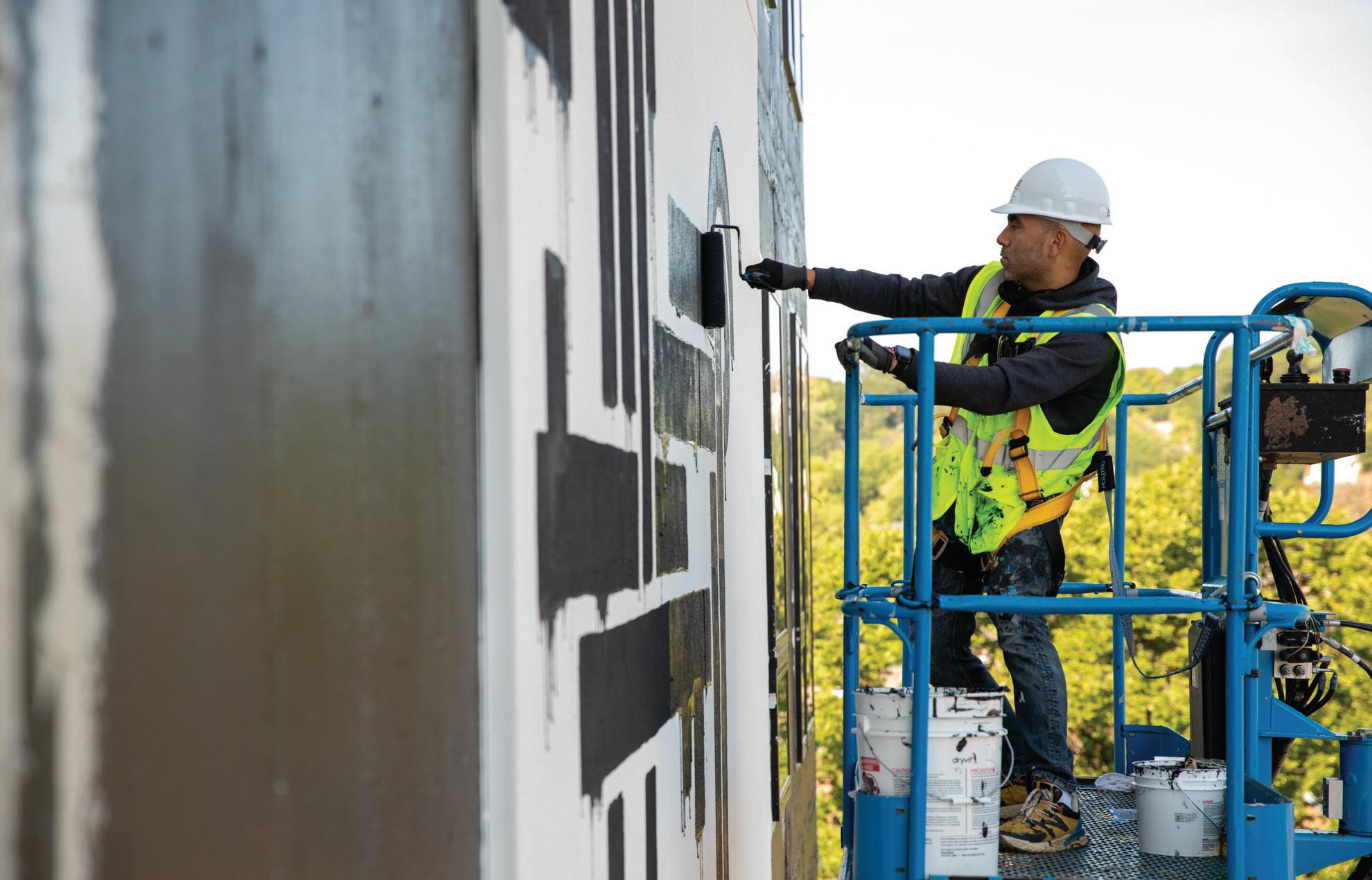
For days, De La Cruz and his team hung by a cherry-picker to paint the exterior of the building by hand. Not just a simple mural, but the whole building—all seven stories have painted elements. All told, 7,500 square feet is painted, all reflecting artwork inspired by the Alvera story.
De La Cruz was inspired by Alvera Franceschi as a mother and also as a lover of art. Her favorite color was orange. Looking at the exterior of the building, the shades of orange not only make the building stand out, but the colors signify the coming and going of the day. Mixed in with that, De La Cruz used patterns to express a serape (Mexican blanket) to envelop the building as a mother would by putting her arms around its inhabitants. The tones and textures also carry into the common areas and rooftop deck.
Ackerberg didn’t stop with De La Cruz. There needed to be more artistic impact. The team created an “Artist-in-Residence” program whereby an artist will live in the building rent-free for one year. In exchange, the artist creates fresh and unique artwork for display in the building. Alvera Franceschi was an avid art collector. “Not the traditional, museum art you might think of,” clarifies Stuart. “But when she traveled, she would seek out local artists, get to know them and understand their art. Then we she brought home the pieces, they were meaningful because she knew the artist personally.” Ackerberg is honoring her memory by bringing in artists, supporting them through free rent and giving them a venue to cre ate and explore their craft. “We have a duty to stimulate others,” added Ackerberg, “and to inspire other developers and builders to do the same.”
The art gallery in the building will serve as a reminder to the development community that design doesn’t need to be the tail of the dog. “Design is the dog,” says Ackerberg.
49DEVELOPMENT SHOWCASE
We connect
the dots, and
make
the connections.
BWBMN.COM Member FDIC Discover Bridgewater Bank. “We
believe in being honest and
confronting
the difficult issues up-
front,
which helped with tackling
this small site. Credit
also goes to
Opus for understanding the challenges of this project and working with everyone to deliver an amazing finished product.”
Shaping
Making it Affordable
The costs of construction today and the rents that are needed to support new construction are at odds with the community’s needs for urban workforce housing. Farrell and Ackerberg knew the project needed to serve the workers of the neigh borhood in which it was being built. To accomplish this, the units needed to be efficient. “Alvera’s homes are typically in the range of four hundred to six hundred square feet,” according to Ackerberg. “In order to do that, we had to place an emphasis on the amenities,” adds Farrell. “During a time when work-from-home was exploding, we needed to accommodate resident needs to get out their space to stretch their legs or take a phone call.” In addition to the typical high-tech gym and rooftop lounge, the team added phone booths and hidden alcoves to provide those much-needed individual touch-down spaces. This is the landing pad for the young professional and support staff who call this building home. The design had to reflect that, according to Ferrell.
In the end, the project achieved the goal of accessible housing. Unit rents start at $980 according to the building’s website, and the building is wildly popular with tenants.
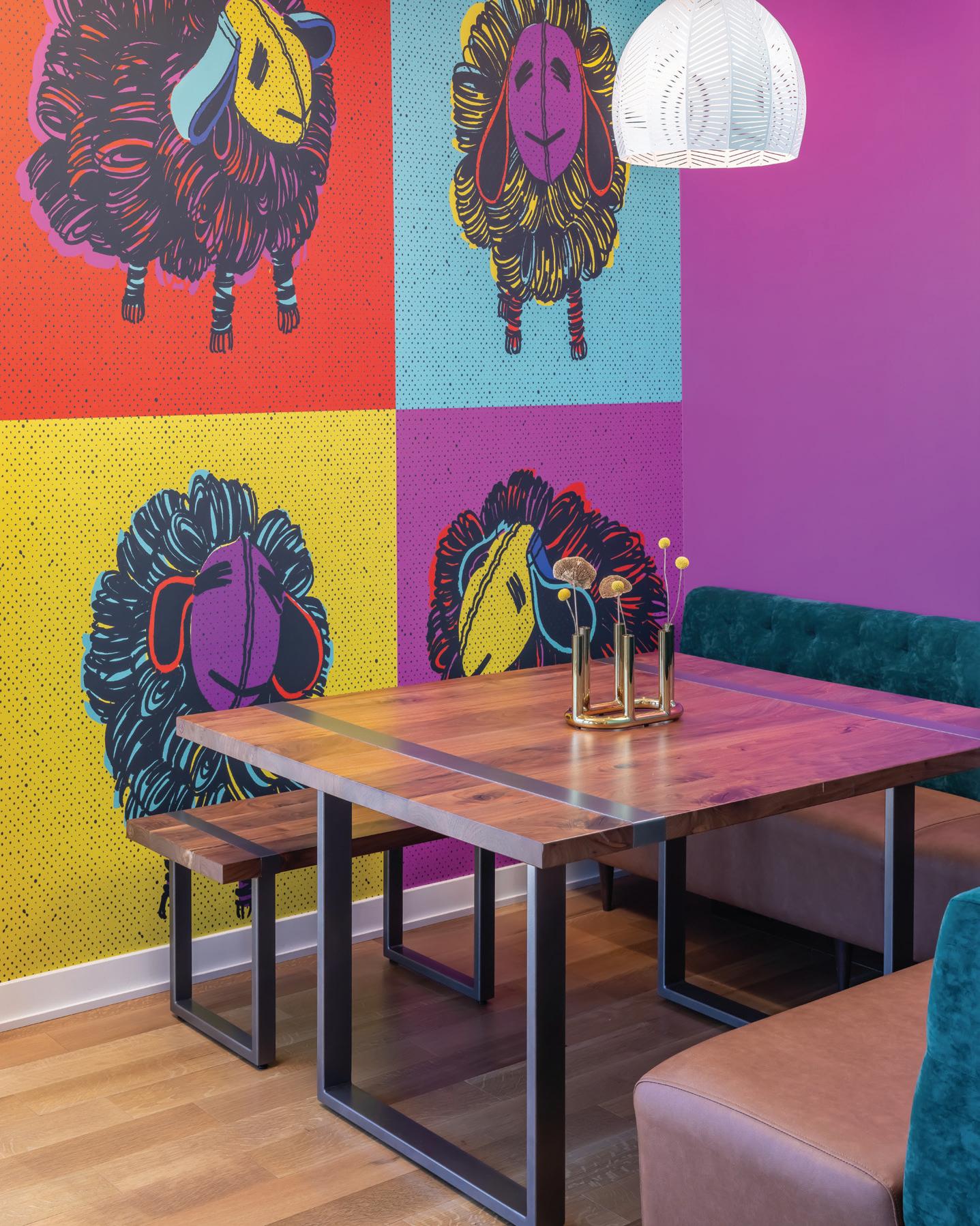
Other Modular and Construction Challenges to Overcome

Modular construction will be a big part of the industry’s future. It is promising not only for cost savings, but also speed-to-market, construction quality, and perhaps, even automation. “The biggest savings for us was timing,” according to Farrell. “We are now exploring volumetric modular for all of our projects.” The short time span from the start of construction to the first day you collect rent can generate significant savings. Not only do you save interest and other carrying costs, “your
future
to The Ackerberg Group on the Alvera project.
were privileged to work with you on this building and proud to call you a client.
aspects of
GPM attorneys have
the creative management of
The firm’s robust
team takes pride in
Estate
with
50 DEVELOPMENT SHOWCASE
the
Congratulations
We
Lathrop
deep experience in all
commercial real estate development, including
complex environmental situations.
Real
& Development
partnering
our clients to achieve their development goals. Working together, we build exciting futures. Wade Anderson 612.632.3005 wade.anderson@lathropgpm.com lathropgpm.com This is an advertisement. The choice of a lawyer is an important decision and should not be made based solely upon advertisements. Neither the highest state courts nor state bar associations review, recognize, or approve certifying organizations, certifications of specialties or specialist designations in the practice of law. The certificate, award or recognition is not a requirement to practice law. Lathrop GPM LLP, 2345 Grand Blvd., Suite 2200, Kansas City, MO 64108. For more information, contact Cameron Garrison at 816.292.2000.
Lorem
ipsum
Dovolis’ company DJR assigned modular veteran Aaron Johnson to the job. Many credit Johnson for his impact on melding the building’s design with the intricacies of modular. When you build in a factory at the pace and timing of a modu lar project, one hundred percent of the design work must be done upfront. “You are making choices really early on in the process,” recalls Ackerberg. “It’s definitely an adjustment.” So much so that DJR brought in technology to help the team virtually visualize the interior design to facilitate the unusual early timing of design.
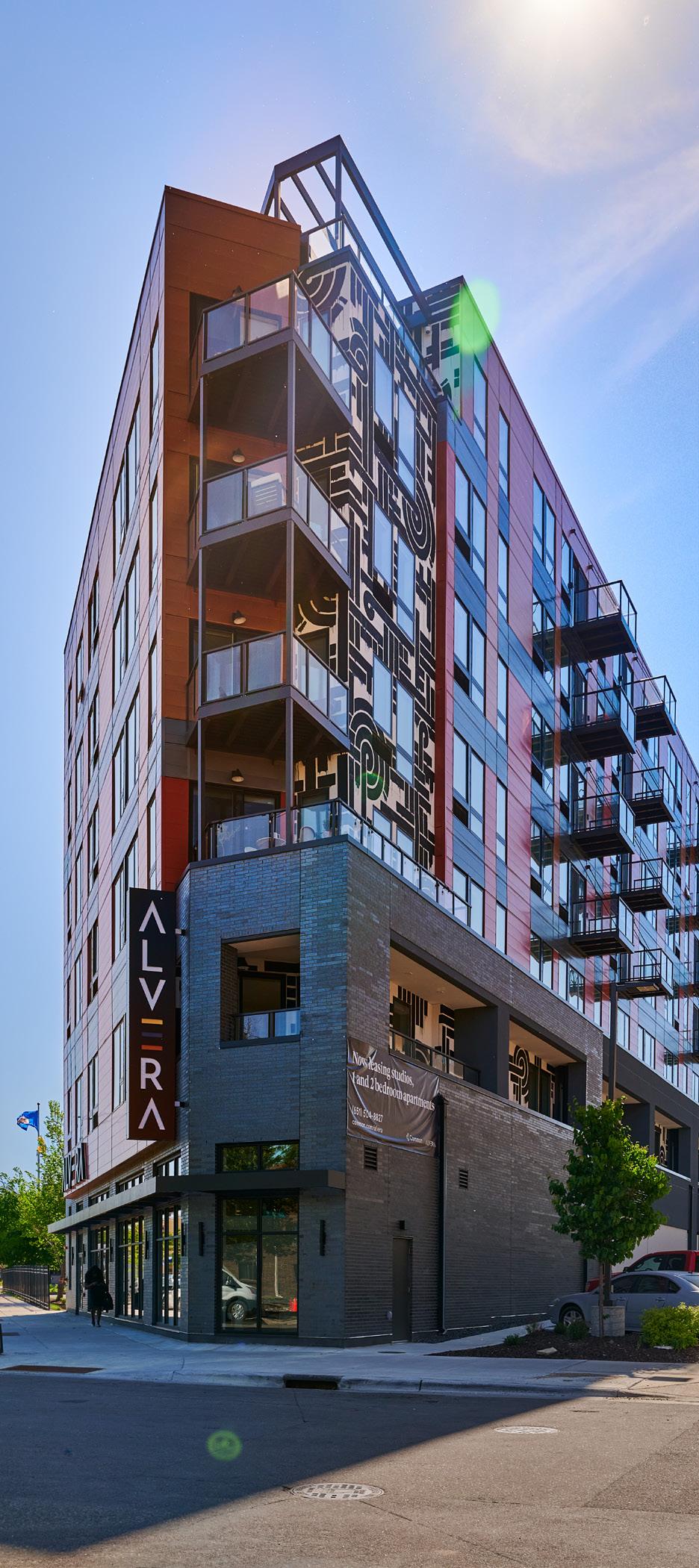
Putting a roof on a modular building “was really just like any ither job,” according to Mike Olson of Central Roofing Company. The challenge with Alvera was that the north and south sides of the building were only about six feet from the property line. “There were times when we were bringing in materials in a wheelbarrow and hoisting some of it by hand,” recalls Olson. “We believe in being honest and confronting the difficult issues upfront, which helped with tackling this small site. Credit also goes to Opus for understanding the challenges of this project and working with everyone to de liver an amazing finished product.”
Additional unforeseen challenges, like construction lending, added to the com plexities. “Modular construction might scare away many lenders at first blush,” states Ross Wiesner, Senior Vice President at Bridgewater Bank. “There are a number of issues we had to dig in and understand to develop a comfort level with this project. For example, what is your security interest in an incomplete module in a factory? Who owns the modules or rather who insures the modules

while they are in transit?” Wiesner concluded that Bridgewater was passionate about the West 7th Corridor, as it has an office in that neighborhood, but he and Bridgewater also believe strongly in the development team. “Ackerberg, really everyone involved, knocked this one out of the park. We believe in mul tifamily in the long term, and we were honored to be afforded the opportunity to be involved in such a unique project.” In the end, modular construction was just another speed bump to funding the project.

51DEVELOPMENT SHOWCASE
Ackerberg Group, Northland Real Estate Group, DJR Architecture, The Opus Group and RISE Modular came together to build the largest commercial volumetric modular project in Minnesota – the award-winning Alvera Apartments in St. Paul. TOGETHER WE RISE www.risemodular.com
Not the Best Time to Put up A Building
The team again turned to Alvera Franceschi and relied on her strength to work through troubled times. It wasn’t the easiest time to be putting up a structure. During civil unrest in an adjacent community, an entire project was burned to the ground, just blocks away from the site. Add to that workplace issues related to a pandemic, and you have a recipe for a disaster. “We approached each day as an adventure,” says Ackerberg. “ It was certainly a vertical learning curve. Learning modular, dealing with site restrictions, lumber pricing, labor shortages, and dealing with pandemic-related civil unrest, we had daily hurdles to overcome. But the stronger the team, the easier it was to pivot and bounce. And our team rallied together with a positive approach to really make it hap pen.”
In the End, a Legacy
Dovolis says, “A testament to the building, and also an ongoing challenge, is the number of requests we get for tours of the building. It is really going to inspire the next generation of multifamily development.” Ferrell credits the creativity and leadership by Stuart and the rest of the team at Ackerberg Group. “A proj ect like this doesn’t happen without a progressive partner like Ackerberg.”
Alvera is truly a legacy of love and a legacy of firsts. It is the first modular project of this scale in the Upper Midwest, with the largest automated parking struc ture in the Midwest to date. Additionally, the inspired artwork of Aaron De La Cruz met the vision of Stuart Ackerberg and Brian Farrell to enhance West 7th in a way that no one else could at a time when it was needed the most. Dean Dovolis will be proudly hosting tours for years to come.
Project Team
Ackerberg Group
Co-Developer
Northland Real Estate Group Co-Developer
RISE
Opus Group
All City Elevator
Central Roofing
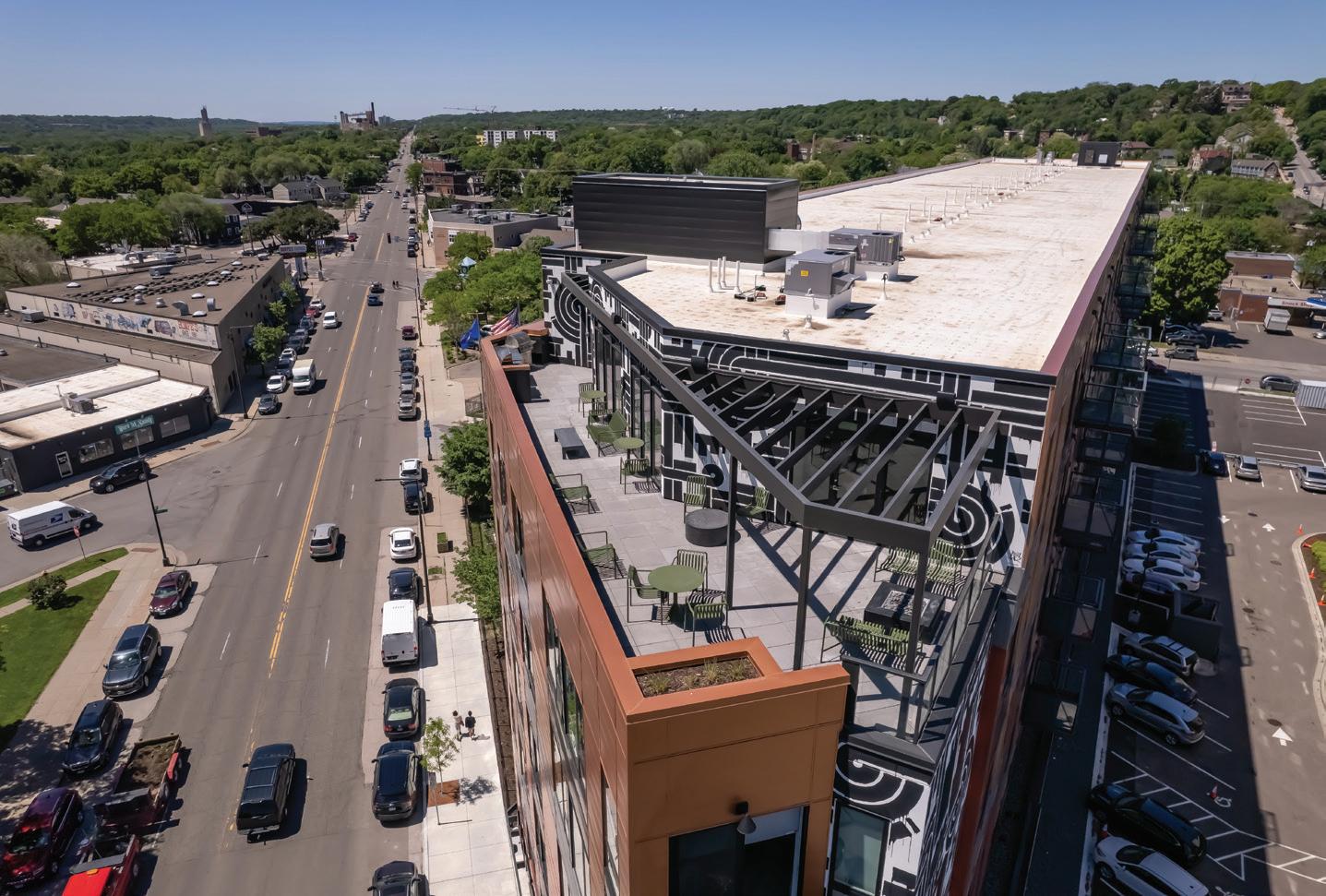
Modular Construction
General Contractor
Parking System
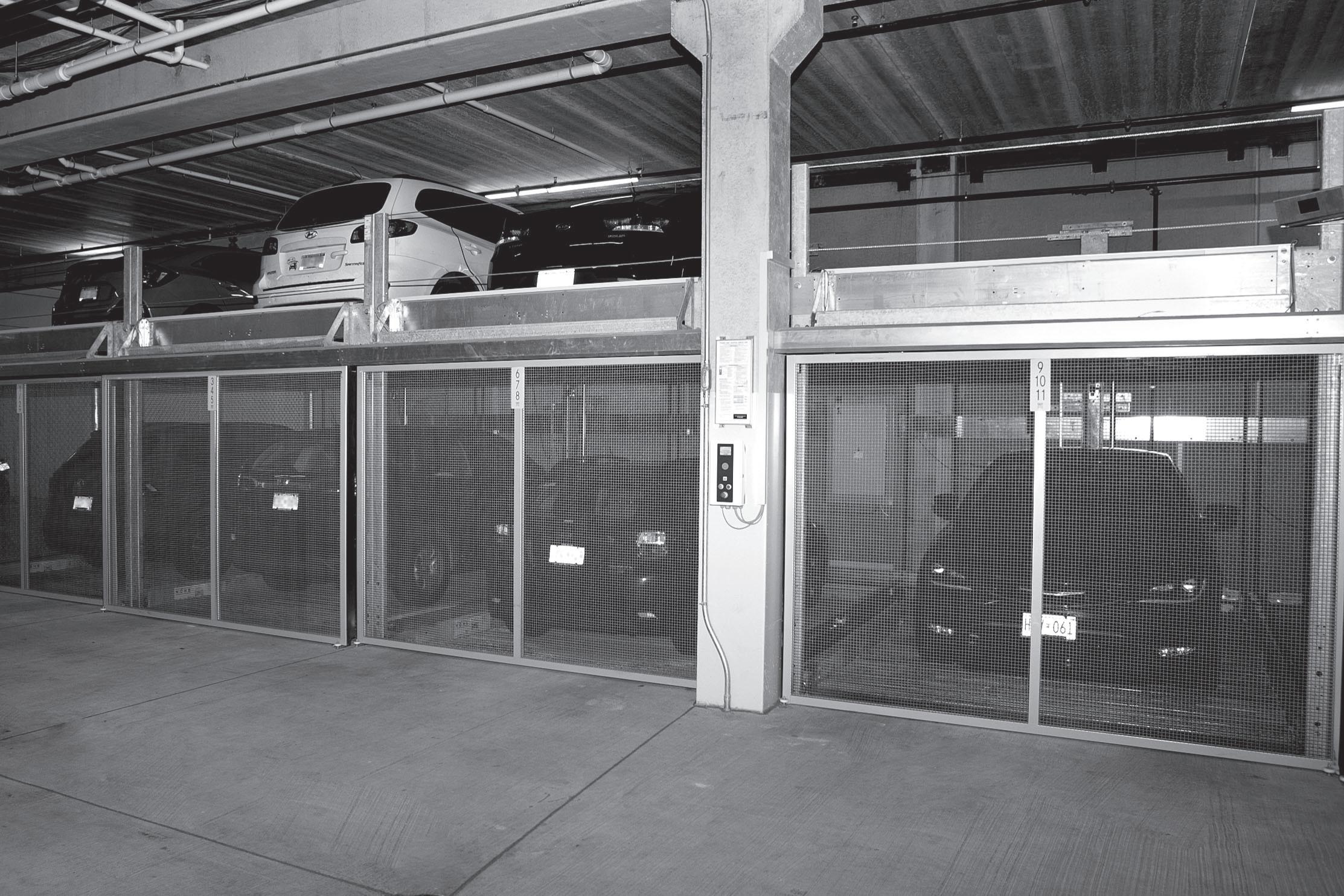
Roofing Systems
Midwest Specialty Maintenance Construction Cleaning Service
Bridgewater Bank Lender
52 DEVELOPMENT SHOWCASE
ARCHITECTS/DESIGN-BUILD FIRMS
LAMAR JOHNSON COLLABORATIVE
35 E. Wacker Drive, Ste. 1300
Chicago, IL 60601
P: 312.429.0400
Key Contact: Lamar Johnson, FAIA, LEED AP 2199 Innerbelt Business Center Drive St. Louis, MO 63114
P: 314.429.1010
Key Contact: Chip Crawford, PLA, FASLA, LEED GA Website: theljc.com
Services Provided: Lamar Johnson Collaborative provides architecture, interior design, landscape architecture, urban planning, and urban design.
Company Profile: Lamar Johnson Collaborative is a full-service design and architecture firm committed to enhancing the quality of the human experience and to improving how design and architecture can impact each individual’s emotional being. By harnessing the power of integrated design, including architecture, interior design, landscape architecture, urban planning, urban design and engineering, the company achieves its clients’ goals and aspirations.
Notable/Recent Projects: 448 N LaSalle, Horizon Therapeutics, Triangle Square, 24 E Washington, T-Rex Lobby Renovation & Art Installation, POPCourts!, Mark Anthony Brewing, Katherine Ward Burg Memorial Garden, EDGE @ WEST, Northwestern Medicine Mokena Medical Office Building, St. Louis County Library – Lynn Beckwith, Jr. Administrative Building and Ladue Branch, Wildhorse Village Mixed Use Development
BROKERAGE FIRMS
AREA REAL ESTATE ADVISORS
4800 Main Street, Suite 400
Kansas City, MO 64112
P: 816.895.4800
Website: openarea.com
Key Contact: Tim Schaffer, Founder & President, tschaffer@openarea.com Services Provided: Office, Retail & Industrial Landlord and Tenant Representation; Multifamily Brokerage; Property Management; Project Management; Investment; Research Analytic and Consulting.
Company Profile: AREA Real Estate Advisors is a full-suite commercial real estate firm in Kansas City. AREA is the hometown team that plays in the big leagues. Our size and scope allow us to be nimble and apply a team-driven approach while providing best-in-class service. At AREA, we deal in real estate, but our business is relationships. We are committed to meaningful partnerships with our clients to ensure that their goals are achieved. Our goal is to exceed our clients’ expectations
Notable Transactions: Ocean Prime / Prime Social, Visiting Nurse Association, American Trailer & Storage, Ryan Lawn & Tree, Five Below, Lightwell Food Hall, BioLife, CentiMark, Clairvaux, Santa Fe Village Apartments, Arvest Bank, Arborwalk.
BARBERMURPHY
1173 Fortune Blvd.
Shiloh, IL 62269
P: 618.277.4400 | F: 618.277.4407
Website: barbermurphy.com
Key Contacts: Wayne Barber, Jr., SIOR, Principal, Wayne@barbermurphy.com; Paul Murphy, Managing Broker, Principal, Paul@barbermurphy.com; Steve Zuber, SIOR, CCIM, Principal, Steve@barbermurphy. com; Collin Fischer, CCIM, Principal, CollinF@barbermurphy.com
Services Provided: BARBERMURPHY is a full service Commercial Real Estate firm offering their clients on the ground market knowledge and experience in the disposition and acquisition of commercial, industrial, land, retail, and investment properties.
Company Profile: BARBERMURPHY is one of the top commercial real estate brokerage firms in downstate Illinois/St. Louis Region. Our growing firm has 19 Licensed Brokers and more than 500 exclusive listings.

Mission Statement: Achieving total client satisfaction through exceptional people providing the best possible Commercial Real Estate Solutions.
CRESSY COMMERCIAL REAL ESTATE

4100 Edison Lakes Pkwy., Suite 350 Mishawaka, IN 46545
P: 574.271.4060
3502 Woodview Trace, Suite 250 Indianapolis, IN 46268
P: 317.875.8888
Website: cressy.com
Key Contact: Chris Fielding, CEO Services Provided: Brokerage Services, Property Management, Financial Management & Reporting, Maintenance & Mechanical Services, Development, Architectural Services, Design Services, Project Management, Construction Services.
Company Profile: NAI Cressy, the brokerage division of Cressy Commercial Real Estate provides expert data, marketing and closing services. Our proprietary database and dedicated staff ensure our brokers are able to meet all of your real estate needs and goals. With corporate offices in South Bend, Mishawaka and Indianapolis, Indiana we are able to serve the vast majority of Central to Northern Indiana and Southwest Michigan. Also through our affiliation with NAI Global, we can provide a global network of data for markets nationwide.
CUSHMAN & WAKEFIELD


225 West Wacker Drive, Suite 3000
Chicago, IL 60606
P: 312.470.1800 F: 312.470.3800
2021 ANNUAL RESOURCE GUIDE marketplace
Website: www.cushmanwakefield.com
Key Contact: Victoria Malkin, Regional President, Midwest Services Provided: Property, facilities and project management, leasing, capital markets, valuation and other services.
Company Profile: Cushman & Wakefield (NYSE: CWK) is a leading global real estate services firm that delivers exceptional value for real estate occupiers and owners. Cushman & Wakefield is among the largest real estate services firms with approximately 50,000 employees in over 400 offices and approximately 60 countries.
CUSHMAN & WAKEFIELD/THE LUND COMPANY
450 Regency Parkway, Suite 200
Omaha, NE 68114
P: 402.393.8811 | F: 402.393.2402
Website: lundco.com
Key Contacts: Jason Fisher, CEO, jfisher@lundco.com; Tanya Shapiro, President, tanya.shapiro@lundco.com Services Provided: Our staff of innovative and creative professionals offer a wide range of real estate services including brokerage, commercial and multi-family property management, real estate consulting, investment acquisition, and project and development services.
Company Profile: Company Profile: Cushman & Wakefield/The Lund Company markets and manages over 20 million square feet of properties, which includes more than 100 commercial buildings and 16,000 apartment units.

FRIEDMAN REAL ESTATE
34975 W. Twelve Mile Road
Farmington Hills, MI 48331
P: 888.848.1671
Website: friedmanrealestate.com
Key Contacts: David B. Friedman, President/CEO; Gary Goodman, Sr. Managing Director-Brokerage Services Services Provided: Friedman offers a full range of real estate services including commercial and multifamily property and asset management, tenant and landlord representation, investment and loan sale advisory, space planning, design and construction and a unique platform of lenderfocused bankruptcy, receivership and distressed asset services. All services are provided inhouse, though a single point of contact, which guarantees that clients receive the most timely and efficient service available in the marketplace.
Company Profile: Founded in 1987, Friedman Real Estate is one of the largest privately held commercial real estate organizations in the nation; currently managing over 15M SF of commercial space and more than 15,000 apartment homes located throughout the country. Friedman’s commercial brokerage team has over 800 current listings with $20 billion in closed transactions.
Notable Transactions/Clients:
• Troy Technology Park - Troy, MI
• Sakthi Automotive Industrial Portfolio - Detroit
• Greyberry Apartments - Waterford
• Tiffany Plaza - Youngstown
• West 11 Tech Park – Southfield
GERSHMAN COMMERCIAL REAL ESTATE
150 N. Meramec Ave., Suite 500
St. Louis, MO 63105
P: 314.862.9400
Website: gershmancommercial.com
Key Contacts: Chris Fox, CCIM, SIOR, President & CEO, cfox@gershmancommercial.com; Molly Studer, Executive Vice President, Operations, mstuder@gershmancommercial.com Services Provided: Gershman offers an extensive array of commercial real estate services, including brokerage, landlord and tenant representation, investment sales, valuation advisory, market research, corporate services, property & facility management, project/construction management, client accounting and maintenance/engineering.
Company Profile: Gershman Commercial Real Estate is a full-service real estate firm providing comprehensive, personalized services to owners and occupiers of commercial property. With an over 70-year history in St. Louis, and firm leadership based locally, we are uniquely positioned as the longest-standing independently owned firm in the metro area.
GOODMAN REAL ESTATE SERVICES GROUP LLC
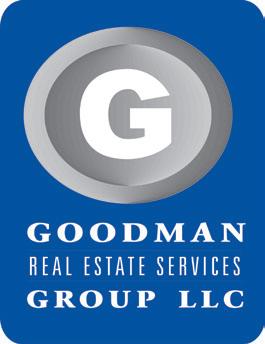
25333 Cedar Road, Suite 305
Cleveland, OH 44124
P: 216.381.8200 | F: 216.381.8211
Website: goodmanrealestate.com
Key Contacts: Randy Goodman, President, Randy@goodmanrealestate.com; Richard Edelman, Senior Vice President/Principal, Richard@goodmanrealestate.com Services Provided: At Goodman, we combine experience, technology, a large support team and hard work to provide exceptional service to its clients in national investment sales and financing, tenant and buyer site selection, property marketing, leasing, sales and disposition.
Company Profile: Goodman is a leading commercial brokerage firm based in Ohio specializing in national investment sales, tenant and buyer site selection with over 100 companies represented and marketing over 10 million square feet of retail properties for lease and development.
Commercial Real Estate Solutions
BROKERAGE FIRMS
KESSINGER HUNTER & COMPANY, LC
2600 Grand Boulevard, Suite 700
Kansas City, MO 64108
P: 816.842.2690 | F: 816.421.5659
Website: kessingerhunter.com
Key Contact: John DeHardt
Services Provided: Kessinger Hunter & Company, LC is a full-service, commercial real estate firm. Full service includes management, brokerage, development, accounting, and consulting services throughout the United States and globally.

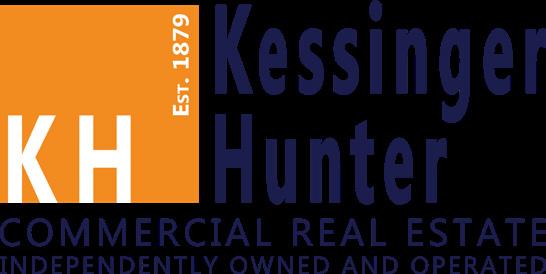
Company Profile: What really sets us apart is our People. Integrity, Passion, Knowledge, and Experience are a way of everyday life for us at Kessinger Hunter. Each group responds to our clients’ needs, and they work together to utilize the resources that come with more than 140 years of experience and 200 associates. We manage over 26,000,000 square feet of property and have developed in excess of 14,000,000 square feet of projects.
NAI FARBMAN/FARBMAN GROUP
28400 Northwestern Highway, Suite 400
Southfield, MI 48034
P: 248.353.0500 | F: 248.353.0501
Website: farbman.com
Key Contacts: Andrew Farbman, CEO, afarbman@farbman.com; Andrew Gutman, President, gutman@farbman.com;

Michael Kalil, COO and Director of Brokerage, kalil@farbman.com.
Services Provided: Leasing & Brokerage, Construction, Investment Sales, Asset Management, Site Selection Services, Acquisition & Disposition, Medical Real Estate Solutions, Move Management, Property Management, Receivership Services, Facility Management.
Company Profile: NAI Farbman, a full-service commercial real estate company, is one of the largest and most respected names in Commercial Real Estate.
DEVELOPERS
CENTERPOINT PROPERTIES

1808 Swift Drive
Oak Brook, IL 60523
P: 630.586.8000 Website: centerpoint.com
Key Contacts: Bob Chapman, Chief Executive Officer, bchapman@centerpoint.com; Michael Murphy, Chief Development Officer, mmurphy@centerpoint.com
Services Provided: CenterPoint Properties is an innovator in the investment, development and management of industrial real estate and multimodal transportation infrastructure. CenterPoint acquires, develops, redevelops, manages, leases and sells state-of-the-art warehouse, distribution and manufacturing facilities near major transportation nodes. Our experts focus on rail and portproximate distribution infrastructure assets.
Company Profile: CenterPoint Properties continuously reimagines what’s possible by creating ingenious solutions to the most complex industrial property, logistics and supply chain problems. With an agile team, substantial access to capital and industry-leading expertise, we provide our customers with a competitive edge and ensure their success — no matter how great the challenge.
CRG
35 E. Wacker Drive, Ste. 1300
Chicago, IL 60601
P: 312-658-0747
2199 Innerbelt Business Drive St. Louis, MO 63114
P: 314-429-5100
Key Contacts: Shawn Clark, President clarks@realcrg.com; Chris McKee, Chief Development Officer, mckeec@realcrg.com
Website: www.realcrg.com
Services Provided: Development, Site Selection, Site Planning & Cost Analysis, Engagement & Entitlements, Incentive Discovery & Negotiation, Financing, Development Management, Leasing & Administration, Asset Management and Investment Management.
Company Profile: CRG is a privately held national real estate development and investment firm that has developed more than 10,000 acres of land and delivered over 210 million square feet of commercial, industrial, institutional and multifamily assets exceeding $13 billion in value. CRG leverages a powerful North American platform with local market expertise and offices in Atlanta, Chicago, Seattle, Southern California, St. Louis, Philadelphia and Phoenix. CRG’s philosophy of developing for the future and anticipating the enhanced needs of next-generation users led to the creation of its industrial brand, The Cubes, and its multifamily brand, Chapter. For more information, visit CRG’s website at www.realcrg.com.
THE BROADBENT COMPANY
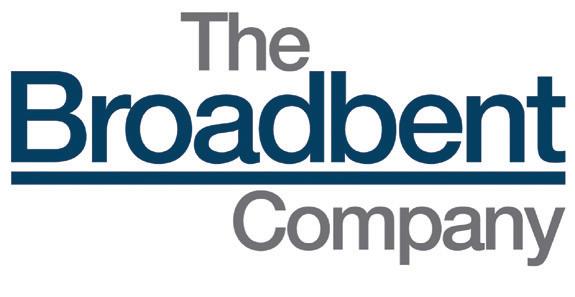
117 E. Washington Street, Suite 300
Indianapolis, IN 46204
P: 317.237.2900
Website: BroadbentCompany.com
Key Contact: Dave Cheslyn, Executive Vice President Leasing Development & Real Estate Sales Services Provided: Leasing - Brokerage - Acquisition - Development - Management - Tenant Representation
Company Profile: Broadbent is a full service real estate company in business since 1972; Leasing/ Brokerage, Management, Acquisitions, Development and Tenant Representation of retail centers throughout the Midwest.
Notable Transactions/Clients: La-Z-Boy, The Room Place, Kohls, At Home, PetSmart, Ashley Furniture, Uncle Bill’s Pet Center, United Art & Education, The District Tap, Office Depot, Office Max, McAlister’s Deli, Moe’s Southwest Grill, Noodles and Company.
THE LUND COMPANY
450 Regency Parkway, Suite 200 Omaha, NE 68114
P: 402.393.8811 | F: 402.393.2402 Website: lundco.com
Key Contacts: Jason Fisher, CEO, jfisher@lundco.com; Tanya Shapiro, President, tanya.shapiro@lundco.com Services Provided: Our staff of innovative and creative professionals offer a wide range of real estate services including project and development services, brokerage, commercial and multi-family property management, real estate consulting and investment acquisition. Company Profile: Company Profile: Cushman & Wakefield/The Lund Company markets and manages over 20 million square feet of properties, which includes more than 100 commercial buildings and 16,000 apartment units.
THE MISSNER GROUP
1700 W. Higgins Road, Ste. 400 Des Plaines, IL 60018
P: 847.675.8877 Website: missnergroup.com
Key Contacts: Eddie Adler, EVP, eadler@missnergroup.com; Aldo Bottalla, SVP, Business Development, aldo@missnergroup.com Services Provided:
• Investment
• Development
• Acquisition
• Construction
CONOR COMMERCIAL REAL ESTATE
9500 W. Bryn Mawr Avenue, Suite 200
Rosemont, IL 60018
P: 847.692.8700 | F: 847.292.4313
Website: conor.com
Key Contacts: David J. Friedman, President, dfriedman@conor.com; Brian Quigley, Executive Vice President, bquigley@conor.com
Services Provided: Conor Commercial identifies and implements the most suitable commercial real estate strategy to yield increased returns for each real estate opportunity. With offices and seasoned real estate professionals strategically located throughout the country, the firm provides the experience and resources needed to develop and stabilize real estate developments that maximize positive returns to investors and partners.
Company Profile: Conor Commercial Real Estate is the integrated real estate development firm of The McShane Companies headquartered in suburban Chicago, Illinois with regional offices located in Dallas, Houston, Irvine and Phoenix. The firm is active on a local, regional and national basis in the development of master-planned industrial and office parks, multifamily properties, medical office developments and built-to-suit projects for lease or purchase.
• Asset Management Company Profile: The Missner Group, headquartered in Des Plaines, Illinois, provides comprehensive and integrated real estate development and construction services throughout the Chicagoland and Midwestern markets. The firm, established in 1945, has completed more than $1 billion in construction projects, and has orchestrated the development of more than 15 million square feet of commercial and industrial real estate. For more information, please visit www.missnergroup.com.

Notable/Recent Projects: 4400 Homerlee Ave (250,000 SF), 50 S. Fairbank St. (80,000 SF), 1032 W. 43rd St. (130,000 SF), 3900 S. Normal (169,000 SF), 2100 Melrose Park (187,000 SF)
LAW FIRMS
GOULD & RATNER
222 N. LaSalle St., Ste. 300 Chicago, IL 60601
P: 312.236.3003 | F: 312.236.3241 Website: gouldratner.com
Key Contact: Linsey Cohen, Chair, Real Estate Practice, lcohen@gouldratner.com Services Provided: Counsel on nearly all real estate transactions, including purchase, sale and financing of office, industrial, hotel/hospitality and residential/multifamily development, as well as commercial and retail leasing, multiparcel assemblage, tax-deferred exchanges, management agreements, construction financing, litigation and environmental issues.
Company Profile: Gould & Ratner lawyers translate legal knowledge and business acumen into practical solutions that work for our clients, who include entrepreneurs, family businesses, and middle-market and Fortune 500 companies in real estate and many other industries in Chicago and nationwide.

54 | Midwest Real Estate News | September/October 2022 | www.rejournals.com
HAHN LOESER & PARKS LLP
200 Public Square, Suite 2800
Cleveland, OH 44114
P: 216.621.0150
200 West Madison Street, Suite 2700
Chicago, IL 60606
P: 312.637.3000
Key Contacts: Aaron S. Evenchik, Partner, National Chair, Real Estate Group, aevenchik@hahanlaw.com; Joel T. Cooper, Partner, jcooper@hahnlaw.com
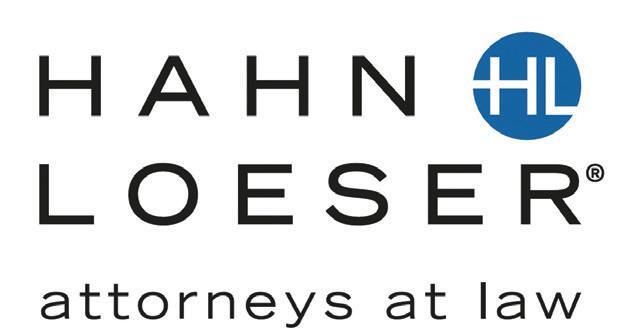
Services Provided: Our real estate practice is national in scope across all asset classes, and we assist our clients with structuring and implementing acquisitions, dispositions, joint ventures, financings (public and private), leasing, and development matters. Clients include local and national property owners, investors, developers, contractors, asset and property managers, and financial institutions.
Company Profile: With over 140 attorneys practicing from offices in Chicago, Cleveland, Columbus, San Diego, Fort Myers, and Naples, we are always focused on our clients’ missions. We render innovative solutions across multiple areas of the law and legal disciplines. We serve individuals and businesses doing business locally, regionally, and globally.
KRIEG DEVAULT LLP

One Indiana Square, Suite 2800
Indianapolis, IN 46204
P: 317.636.4341 | F: 317.636.1507
Website: kriegdevault.com
Key Contacts: David A. Adams, Partner, dadams@kdlegal.com
Stephen A. Studer, Partner, sstuder@kdlegal.com
Services Provided: Acquisitions and Dispositions, Leasing, Construction, Development, Environmental, Land Use and Zoning, Finance/Debt/Equity, Tax Structuring/Tax Credits, Foreclosure/ Bankruptcy.
Company Profile: The professionals of Krieg DeVault’s real estate, environmental and commercial real estate lending groups provide practical, comprehensive legal services to our clients to assist them from concept to completion of their real estate projects.
MELTZER, PURTILL & STELLE LLC
1515 Woodfield Road, Ste. 250 Schaumburg, IL 60173
P: 847.330.2400 | F: 847.330.1231
125 S. Wacker Drive, Suite 2900 Chicago, Illinois 60606
P: 312.987.9900 | F: 312.987.9854
Website: mpslaw.com
Key Contact: William J. Mitchell, Managing Partner, wmitchell@mpslaw.com Services Provided: The firm provides an exceptionally wide range of real estate-related services, including commercial real estate and leasing; land use, zoning, and entitlement; construction and finance- including TIF and other development incentives and commercial litigation.
Company Profile: Meltzer, Purtill & Stelle LLC is a business-to-business law firm with exceptionally strong capabilities in all areas of real estate law. The firm provides a full range of transaction and litigation services to real estate developers, financial institutions, and businesses engaged in corporate, industrial, and retail development as well as financing, leasing, and investment.
O’KEEFE LYONS & HYNES, LLC
30 N. LaSalle St., Ste. 4100
Chicago, IL 60602
P: 312.621.0400 | F: 312.621.0297
Website: okeefe-law.com
Key Contacts: Elizabeth Gracie, Partner, elizabethgracie@okeefe-law.com; Brian Forde, Partner, brianforde@okeefe-law.com
Services Provided: The firm’s partners have been on the forefront of understanding, shaping, challenging, and sometimes writing, Illinois property tax laws. Many of the partners honed their skills overseeing taxation matters for Illinois public taxing agencies. Our firm leverages this expertise, along with a proprietary technology database, to create innovative tax and litigation strategies that lead to successful outcomes for our clients.
Company Profile: O’Keefe Lyons & Hynes, LLC has an 85-year track record of supporting commercial real estate interests in property tax matters. We work with corporate, institutional, private and not-forprofit entities across the office, multifamily, industrial, retail and hospitality sectors.
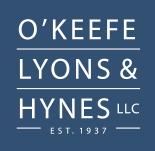
SARNOFF & BACCASH
Two N. LaSalle St., Ste. 1000
Chicago, IL 60602
P: 312.782.8310 | F: 312.782.8635 Website: sarnoffbaccash.com
Key Contacts: James Sarnoff, jsarnoff@sarnoffbaccash.com; Robert Sarnoff, rsarnoff@sarnoffbaccash.com
Services Provided: Sarnoff & Baccash is a leading and recognized law firm concentrating solely in the field of property taxation. We help client’s secure favorable taxes in Illinois through property tax appeals, incentives and consulting.
Company Profile: Sarnoff & Baccash’s clients include Owners, Developers, Managers, REIT’s, Fortune 500 Companies, Private Equity Firms, etc., in connection with commercial property, high-rise and low-rise apartment buildings, condominium associations and single-family home portfolios.
ULMER & BERNE LLP

1660 West 2nd Street, Suite 1100
Cleveland, OH 44113
P: 216.583.7000
Website: Ulmer.com
Key Contacts: Lori Pittman Haas, Group Leader, Real Estate Practice; lhaas@ulmer.com
Services Provided: All aspects of commercial real estate, including but not limited to: urban development, multi-family development, and shopping center development; environmental issues; tax credit enhancements for financing, such as New Markets Tax Credits, Historic Tax Credits, and Low Income Housing Tax Credits; private and public financing; property taxation; eminent domain; land use; tax-deferred exchanges; leasing (retail, office, and industrial/warehouse); acquisitions and divestitures, including skilled nursing and assisted living facilities; and portfolio transactions.
Company Profile: From the acquisition and financing of a corporate headquarters to the construction or adaptive reuse of a mixed-use facility, Ulmer’s real estate attorneys offer a broad scope of talent and expertise in serving clients across the United States.
ECONOMIC DEVELOPMENT CORPORATIONS
ECONOMIC ALLIANCE OF KANKAKEE COUNTY
200 E. Court St., Suite 507
Kankakee, IL 60901
P1: 815.935.1177 | P2: 815.355.4159 Website: kankakeecountyed.org
ECONOMIC ALLIANCE OF
COUNTY
Key Contacts: Timothy Nugent, President/CEO, tnugent@kankakeecountyed.org; Angela Morrey, Director, Marketing & Business Attraction, amorrey@kankakeecountyed.org Services/Demographic Info: The Economic Alliance of Kankakee County is a 501c6 public/ private partnership tasked with retaining industry within and recruiting industry to the Greater Chicago community of Kankakee County, Illinois. The Alliance leverages a number of business intelligence tools, providing current property availability, market data and other information on demand. Incentives: Based on location, projects may be able to take advantage of one or more of the following: Enterprise Zone, New Markets Tax Credits, Historic Tax Credits, Opportunity Zone financing, Tax Increment Financing, C-PACE financing and Special Service Area/Business District incentives.
Recent CRE Activity: Multiple county-wide investments in 2021 including CSL Behring’s $83+ million, Rise Baking’s $34 million and Nucor Steel’s $8 million; 23 major investment projects and 350+ NEW jobs created. $1.6 billion in CRE investment activity in five years, Riverfront & Court Street TIF districts in Kankakee.
LAKE COUNTY, INDIANA ECONOMIC ALLIANCE (LCEA)

440 W. 84th Drive
Merrillville, IN 46410
P: 219.756.4317 Website: LCEA.us
Key Contacts: Karen Lauerman, President & CEO, klauerman@LCEA.us; Don Koliboski, VP Economic Development, dkoliboski@LCEA.us Services Provided:The LCEA team provides economic development and site selection assistance; business expansion services; community connections with decision makers/elected officials; workforce analysis, demographics, cost comparisons and other critical information. Company Profile: LCEA is the Lake County Indiana Economic Development Organization representing 20+ communities just minutes away from Chicago. It is the one resource for developers, site consultants and company executives considering relocation or expansion opportunities in Lake County, Indiana.
MICHIGAN CITY ECONOMIC DEVELOPMENT CORPORATION

Two Cadence Park Plaza
Michigan City, IN 46360
P: 219.873.1211
Website: www.edcmc.com
Key Contacts: Clarence Hulse, Executive Director, chulse@edcmc.com Services/Demographic Info: Michigan City has recognized $1.5 Billion in capital investment over the last 8 years, with more deals - $300 Million Multi-family projects on the horizon. We are located on Lake Michigan with easy access to I-94, I-80 and we are 1 hour drive East of Chicago. Michigan City is home to 32,000 residents with 5.6 Million visitors annually.
Incentives: Waterfront Opportunity Zone, 3 TIF Districts, Facade Improvement Program, Tax based Incentives, Start Up Assistance, and Workforce Training Funds.
Recent CRE Activity: Double Track project ($500 Millions), Michigan City Central Station ($80 Millions), Workforce Apartments 125 units, Waterfront Condominiums 150 Units/Boutique hotel 180 units, 32 Single Family Homes, Shady Creek Winery Expansion - 9,000 SF ($3 Millions), Sullair Hitachi Expansion – 80,000 SF ($33 Millions), Shell-Criterion Expansion ($34 Millions),GAF Expansion – 200,000 SF ($30 Millions), Burn ‘Em Brewing Expansion - ($1.6 Millions), and 30 Independent Restaurants in our Downtown.
NAPERVILLE DEVELOPMENT PARTNERSHIP

22 E. Chicago Ave., Ste. 205
Naperville, IL 60540
P: 630.305.7701
Website: www.Naper.org
Key Contact: Christine D. Jeffries, President, CJeffries@Naper.org
Services Provided:The Naperville Development Partnership promotes the City of Naperville and its many businesses. Whether you are an existing business looking to relocate or a new company, we will take the time to show you what Naperville has to offer.
Company Profile: The Naperville Development Partnership is a public / private economic development organization that promotes business interest in the City of Naperville. Our mission is to enhance the economic vitality of Naperville and maintain its outstanding quality of life. This is achieved through the retention and expansion of existing businesses as well as attracting new business to the community
www.rejournals.com | September/October 2022 | Midwest Real Estate News | 55
KANKAKEE
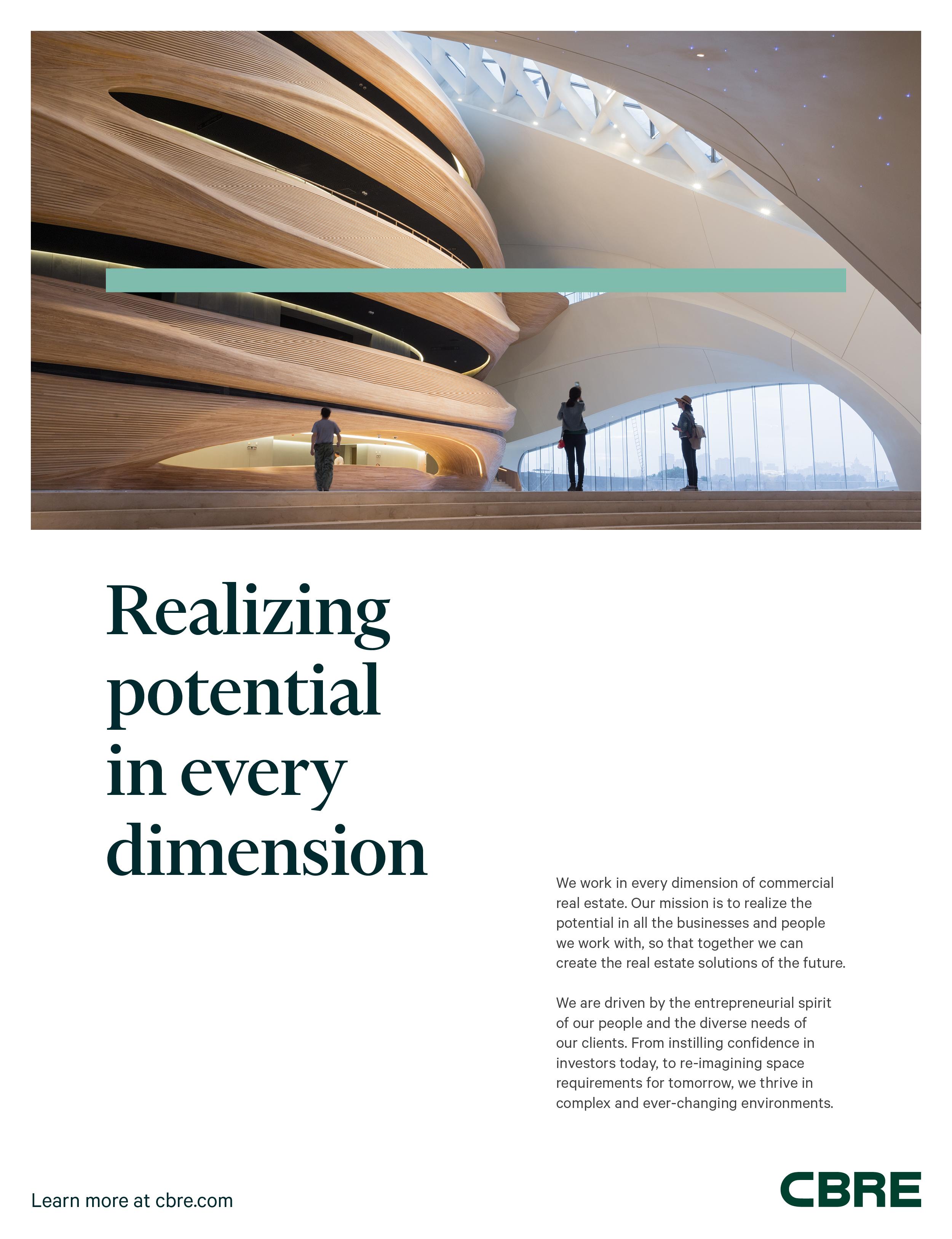




























































 By Dan Rafter, Editor
By Dan Rafter, Editor



























 Chad Kiner Managing Director Walker & Dunlop Columbus, Ohio
Chad Kiner Managing Director Walker & Dunlop Columbus, Ohio



 Conor Lee Senior Vice President Bellwether Enterprise Columbus, Ohio
Conor Lee Senior Vice President Bellwether Enterprise Columbus, Ohio























































































